China Train Schedule & Tickets Booking
- International Train from China
- Select Seats for Free
- 100% Refund for Failed Purchases
- Easy Changes and Cancellations
- One-to-one Service in English
- Expert Booking Consultation
- 3000+ 5-star Reviews on TripAdvisor
- Hong Kong Guangzhou 1h from $30
- Hong Kong Shenzhen 15mins from $9
- Hong Kong Shanghai 8.5h from $141
- Hong Kong Beijing 9h from $150
- Hong Kong Guilin 3.5h from $53
- Hong Kong Xiamen 4h from $36
- Hong Kong Hangzhou 7.5h from $131
- Hong Kong Humen 46mins from $25
- Beijing Shanghai 4.5h from $77
- Beijing Xian 4.5h from $72
- Beijing Pingyao 4h from $26
- Beijing Tianjin 30mins from $8
- Beijing Guangzhou 8h from $120
- Beijing Luoyang 3.5h from $51
- Beijing Datong 6h from $7
- Beijing Harbin 7h from $43
- Shanghai Beijing 4.5h from $77
- Shanghai Xian 6.5h from $94
- Shanghai Hangzhou 45mins from $8
- Shanghai Nanjing 1h from $10
- Shanghai Suzhou 30mins from $4
- Shanghai Huangshan 4h from $42
- Shanghai Yiwu 1.5h from $17
- Shanghai Ningbo 2h from $15
- Guangzhou Shenzhen 30mins from $10
- Guangzhou Yangshuo 2.5h from $15
- Guangzhou Zhuhai 1h from $8
- Guangzhou Shanghai 7.5h from $111
- Guangzhou Beijing 8h from $120
- Guangzhou Zhangjiajie 14h from $24
- Guangzhou Guilin 2.5h from $23
- Guangzhou Hong Kong 2h from $28
- Xian Beijing 4.5h from $72
- Xian Shanghai 7.5h from $94
- Xian Chengdu 3.5h from $37
- Xian Luoyang 1.5h from $17
- Xian Pingyao 2.5h from $21
- Xian Huashan 30mins from $5
- Xian Chongqing 5h from $39
- Xian Lanzhou 3h from $24
- Hangzhou Shanghai 1h from $8
- Hangzhou Suzhou 1.5h from $15
- Hangzhou Beijing 4.5h from $75
- Hangzhou Huangshan 3h from $32
- Hangzhou Nanjing 1.5h from $16
- Hangzhou Ningbo 1h from $8
- Hangzhou Xian 6.5h from $91
- Hangzhou Guangzhou 6.5h from $101
- Suzhou Shanghai 30mins from $4
- Suzhou Hangzhou 1.5h from $15
- Suzhou Beijing 4.5h from $73
- Suzhou Nanjing 1.5h from $10
- Suzhou Xian 6.5h from $89
- Suzhou Huangshan 9.5h from $11
- Suzhou Ningbo 3h from $18
- Suzhou Hefei 2.5h from $21
- Shenzhen Guangzhou 30mins from $10
- Shenzhen Guilin 3h from $33
- Shenzhen Xiamen 3.5h from $25
- Shenzhen Beijing 9h from $132
- Shenzhen Shanghai 12h from $79
- Shenzhen Changsha 3.5h from $54
- Shenzhen Fuzhou 5h from $36
- Shenzhen Chaoshan 2h from $15
- Nanjing Shanghai 2h from $19
- Nanjing Beijing 3.5h from $62
- Nanjing Hangzhou 1.5h from $16
- Nanjing Suzhou 1.5h from $10
- Nanjing Xian 5h from $75
- Nanjing Wuhan 3h from $28
- Nanjing Huangshan 6h from $7
- Nanjing Guangzhou 7.5h from $92

Quick Guide on Train Travel in China

High Speed Trains

First Class Seat vs. Second Class Seat
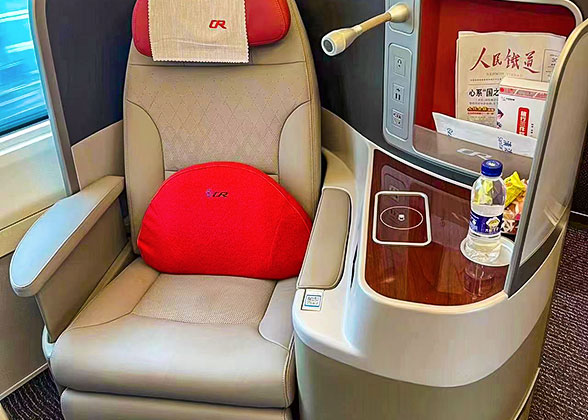
Which type of train and which class to choose

How to buy China rail tickets

How to take a train in China
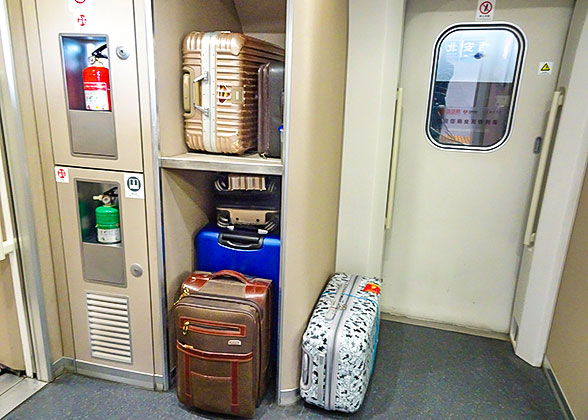
Weight & size limit for carry-on luggage
- Admission Tickets Booking
- Railway Stations
- Food Onboard
- Useful Chinese Phrases
- China Railway
- Railway Map
- Travel Tips
- International Tickets
- Booking FAQ
- China Train App
- Tips during Holidays
Best China Train Travel Routes:
- Beijing-Shanghai : 4.5 - 6 hours
- Hong Kong-Guangzhou : 1 hour
- Beijing-Xian : 4.5 - 6 hours
- Beijing-Guangzhou : 8 - 10 hours
- Shanghai-Guangzhou : 7 - 8.5 hours
- Shanghai-Hangzhou : 1 hour
- Shanghai-Suzhou : 23 - 44 minutes
- Guangzhou-Guilin : 2.5 hours
- Guangzhou-Hong Kong : 1 hour
- Guangzhou-Shenzhen : 30 minutes
- Xian-Shanghai : 6 - 7.5 hours
- Xian-Chengdu : 3 - 4.5 hours
Schedule of Top Chinese Cities:
China High Speed Train Tour, 50+ China Bullet Train Tours 2024
Are you a fan of high speed trains ? Plan to have a China High Speed Train Tours ? Do you know? Because of its fast speed, convenience, comfort, and safety, and with prices even lower than airplanes, China high speed train has become the preferred mode of long-distance travel for Chinese people. As a new symbol of China , Chinese high speed rail has achieved a historic transformation from nothing to a leading position, with a total length of 40,000 km (by late 2021), which is the longest operational mileage in the world.
Take your time to explore the diversity of China 's vast territory by checking out our China High Speed Train Tour Packages . You can choose your China Bullet Train Tour by Destinations such as Beijing , Shanghai , Hong Kong , Chengdu, Xian , Guilin , Jiangnan , and Chongqing ...You can also join our China Tours with High Speed Train , which will include 1 to 3 connections of bullet trains across China .
Popular China High Speed Train Destinations: (Speeds range from 160 to 350km/hour)
1. Beijing Xian High Speed Train Tours: From China's capital to China's ancient capital, it takes only 4.5-6 hours to cover 1,209km.
2. Shanghai Beijing High Speed Train Tours: From China's biggest city to China's second biggest city, it takes only 4.5-6 hours to cover 1,318km.
3. Xian Chengdu High Speed Train Tours: From Terracotta Warriors to Panda City, it takes only 3.5-4 hours to cover 658km.
4. Chengdu Chongqing High Speed Train Tours: From the Land of Abundance to Mountain City, it takes only 1.5-2 hours to cover 308km.
5. Hong Kong Guilin High Speed Train Tours: From Asia's World City to The City of Rivers and Mountains, it takes only 3 hours to cover 284 km.
Tailor-made Your China High Speed Train Tour with us and Discover the Marvels of China's Speed.
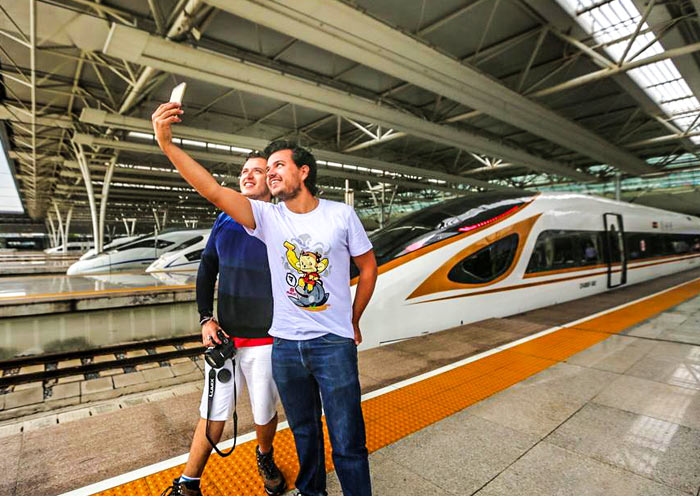
"Excellent Tour, best experience"
"A unique experience despite a difficult context thanks
to an experience team of organisers"
- China High Speed Train Tours
- China Group Tours with Bullet Train
- Train Travel by Destinations
- China Train Rails
Top 9 Popular - China High Speed Train Tours
Would you like to plan a China High Speed Train Tours ? What are China 's most popular bullet train destinations? Here are the Top 9 Popular China High Speed Train Tours that we hand picket for you. Join our China Bullet Train Trips to unveil China 's top tourist cities, from Beijing to Xian , Chengdu , Chongqing , Shanghai , Hong Kong , and Guilin , Jiangnan ... Contact us for an unforgettable high speed train experience across China's vast land while enjoying the country's diverse natural beauty and cultural heritage.
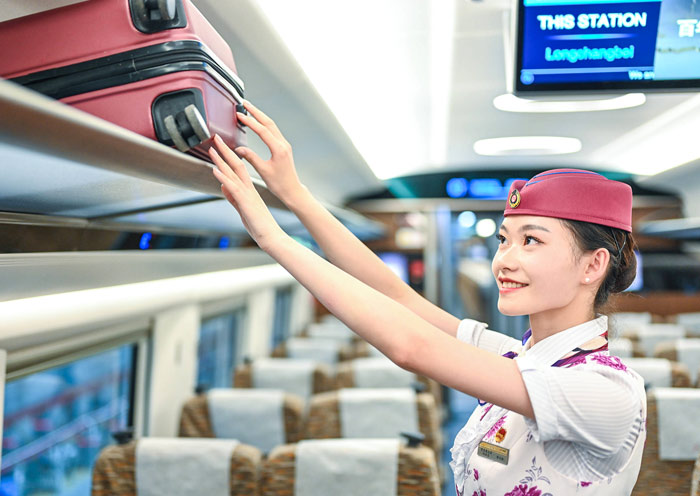
32 China High Speed Train Tours by Destinations
Design Your China High Speed Train Tour with us and Discover the Marvels of China's Speed. How to plan a China High Speed Train Tours? You can detail your China Bullet Train Trips by destinations such as such as Beijing , Shanghai , Hong Kong , Chengdu , Xian , Guilin , Jiangnan , and Chongqing ... These are just a few examples of China high speed train tours in popular destinations in China . Contact us to explore the diverse landscapes across China that align with your interests, duration, and budget.
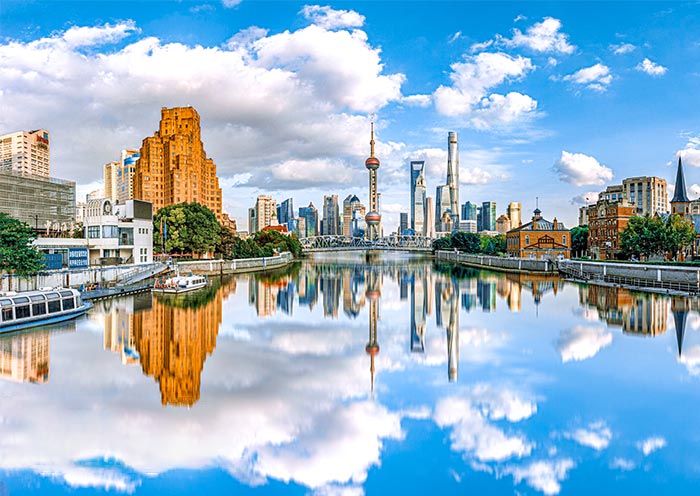
China High Speed Train Day Tours & Short Tours - See China's High Speed
See China 's High Speed by a China High Speed Train Day Tour & Short Tour with us. If you would like to spend 1 to 4 days to enjoy a Bullet Train Tour you can choose to depart from cities like Shanghai , Beijing , Xian , and Hong Kong . You can visit the Jiangnan region such as Shanghai , Hangzhou , Suzhou , and Jiangnan water towns. You can also explore Chinese painting-like scenery in Guilin and Yangshuo . What's more, a glimpse of China 's ancient capitals like Xian and Luoyang. Contact us for wonderful China High Speed Train Day Tours & Short Tours to have a memorable journey by Chinese Bullet Trains .

6 China Group Tours with High Speed Train - With Best Price
Why choose our China Group Tours with High Speed Train ? As a new symbol of China , Chinese high speed rail has the longest operational mileage in the world, the fastest commercial operating speed, and the highest level of operational network coverage, which has amazed the world. Because of its fast speed, convenience, comfort, and safety, and with prices even lower than airplanes, the China Bullet train has become the preferred mode of China travel for our guests from all over the world. Contact us for a China Group Tour with Bullet Train at the best price.
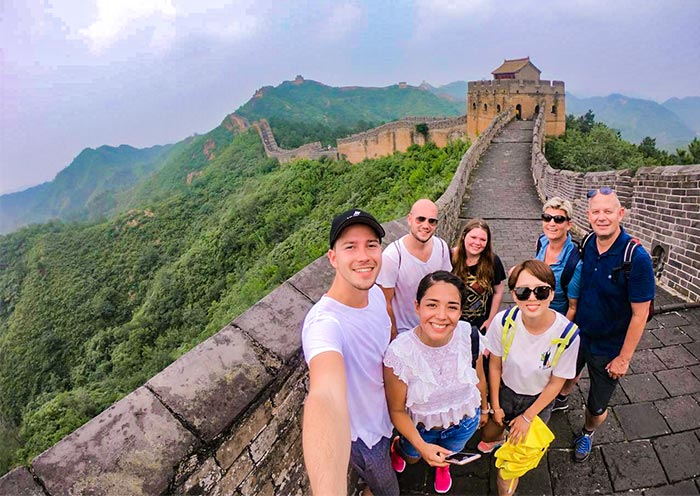
8 Days Beijing Xian Shanghai Small Group Tour
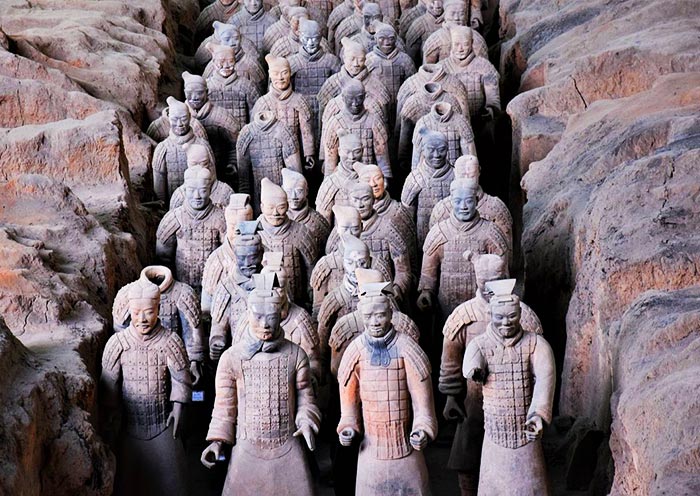
10 Days Beijing Xian Chengdu Shanghai Small Group Tour

11 Days Shanghai Huangshan Xian Beijing Stunning Group Tour

13 Days Relaxing China Tour with Yangtze Cruise in Small Group

13 Days Shanghai Guilin Yangtze Xian Beijing Small Group Tour
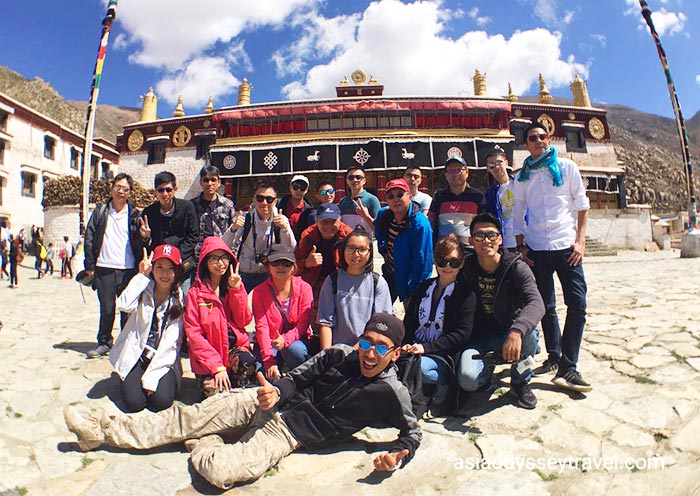
13 Days Essential China Group Tour with Lhasa & Chengdu Pandas
China high speed train rails - quick transfers between china's top cities.
China's high speed train rails are modern, efficient, and well-connected hubs that facilitate quick and convenient transfers between the country's top cities. With trains reaching speeds of up to 350 km/h , travelers can enjoy fast and comfortable journeys, maximizing their time and efficiency. Beijing high speed train rails connect the capital to major destinations efficiently. Shanghai bullet train rails offer seamless transfers and convenient access to the vibrant city. Hong Kong serves as a gateway to mainland China with a smooth transition to the extensive high-speed rail network. Chengdu high speed train rails are a key transportation hub in western China , offering quick transfers to explore the city's famous pandas and vibrant culinary scene. Xian bullet train rails provide easy access to Terracotta Warriors and rich cultural heritage. Guilin high speed train rails are a gateway that leads to picturesque landscapes and the Li River . Contact us to enjoy your China High Speed Train Tour now.
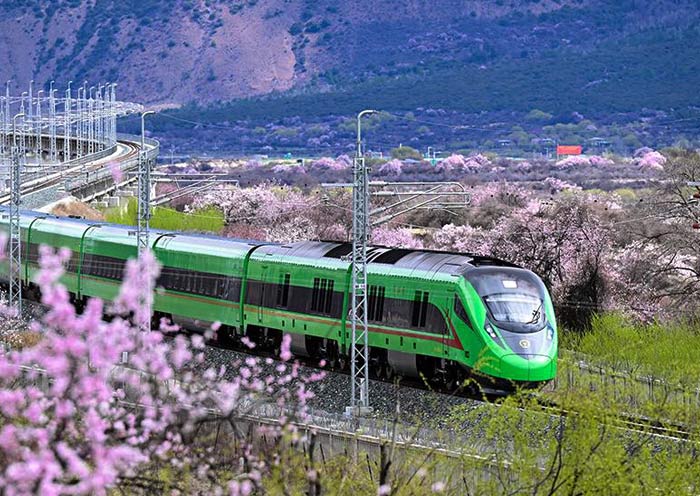
China High Speed Train Tours FAQs - Plan Your China High Speed Train Tours Worry-Free
Traveling through China by high speed rail and bullet train offers numerous advantages and is a popular choice for both domestic and international travelers. It offers a combination of speed, convenience, comfort, and accessibility, making it an attractive choice for travelers seeking efficient and enjoyable journeys throughout China . Here are some reasons why travel to China by High Speed Train :
1). Speed and Efficiency: High speed trains in China can reach speeds of up to 350 kilometers per hour, allowing travelers to cover long distances in a fraction of the time compared to other modes of transportation. This efficiency is particularly beneficial when traveling between major cities.
2). Convenience and Accessibility: China 's high-speed rail network is extensive, connecting major cities and popular tourist destinations across the country. This makes it easy for travelers to access a wide range of attractions and explore different regions conveniently.
3). Comfort and Amenities: High-speed trains in China are designed with passenger comfort in mind. They offer spacious seating, ample legroom, and modern amenities such as power outlets, Wi-Fi, and onboard dining options. Traveling by high-speed rail provides a comfortable and enjoyable experience.
4). Safety and Reliability: China's high-speed rail system has an excellent safety record, with strict regulations and advanced technology ensuring passenger safety. Trains operate on a reliable schedule, minimizing delays and providing a predictable travel experience.
5). Scenic Views: Traveling by high-speed rail allows passengers to enjoy scenic views of China 's diverse landscapes, including rolling countryside, mountains, and picturesque rural areas. It offers a unique perspective on the country's natural beauty.
6). Environmental Friendliness: High-speed trains are a more eco-friendly option compared to air travel or road transportation. They produce lower carbon emissions per passenger, contributing to a more sustainable mode of travel.
7). Cost-effective: While high-speed train tickets may vary in price depending on the distance and class of travel, they are often more affordable than airfares for similar routes. Traveling by high-speed rail can be a cost-effective option for exploring China .
Yes, China's high speed trains have a strong safety record and are considered safe for travel. The Chinese government has placed a strong emphasis on safety in the development and operation of its high-speed rail network. Several measures are in place to ensure the safety of passengers. These include:
1). Advanced Technology: China has invested in state-of-the-art technology for its high-speed trains, including advanced signaling systems, automatic train protection, and train control systems. These technologies help monitor and control train operations, ensuring safe and efficient travel.
2). Rigorous Safety Standards: China has established stringent safety standards for the design, construction, and operation of high-speed rail infrastructure and trains. These standards cover aspects such as track design, train performance, signaling systems, emergency response procedures, and maintenance protocols.
3). Regular Inspections and Maintenance: High-speed trains and infrastructure undergo regular inspections and maintenance to identify and address any potential safety issues. This includes routine checks of tracks, train components, signaling systems, and other critical systems.
4). Experienced Operators: China 's high-speed rail system is operated by well-trained and experienced personnel who are responsible for the safe operation of trains and the management of emergencies. These operators undergo comprehensive training programs to ensure they are equipped with the necessary skills and knowledge.
5). Emergency Preparedness: China has robust emergency preparedness and response systems in place for its high-speed rail network. This includes contingency plans for various scenarios, such as severe weather conditions, natural disasters, or technical failures. The aim is to swiftly address any emergencies and ensure passenger safety.
Yes, Chinese high speed trains do have onboard toilets for passenger convenience. The availability and design of toilets may vary slightly depending on the specific train model and class of service. However, most high speed trains in China are equipped with Western-style or squat-style toilets and all are equipped with a small hand sink and a mirror.
The toilets on Chinese high speed trains are typically located at the ends of each train car, and they are marked with clear signage. They are designed to provide basic amenities and meet hygiene standards. It's important to note that the availability of toilets may be limited in certain sections or during specific times, such as during station stops or maintenance periods.
Passengers are advised to familiarize themselves with the train layout and inquire with the train staff regarding the location and availability of toilets. Additionally, it's recommended to bring personal hygiene supplies , such as toilet paper and hand sanitizer, as these items may not always be readily available onboard the train.
Overall, China 's high speed trains strive to provide comfortable and convenient facilities for passengers, including the provision of toilets, to ensure a pleasant travel experience.
While the Qinghai- Tibet Railway is renowned for its breathtaking scenic beauty, it is not a high-speed train ride. The Qinghai- Tibet Railway is a remarkable engineering feat that connects Xining in Qinghai Province to Lhasa in Tibet, offering stunning views of the Tibetan Plateau and the Himalayan mountain range. However, it operates at a relatively slower speed compared to high-speed trains .
When it comes to high speed train rides in China , there are several routes that offer scenic beauty. Here are some notable ones:
1). Beijing to Shanghai High speed train ride: This route takes you through the picturesque landscapes of the North China Plain, passing by cities, countryside, and the Yangtze River along the way.
2). Chengdu to Chongqing High speed train ride: This route showcases the natural beauty of Sichuan Province, with lush green mountains, rivers, and scenic countryside views.
3). Hong Kong to Guilin High speed train ride: This route takes you through the picturesque karst landscapes of Guangxi Province, with stunning limestone peaks, rivers, and rice terraces.
4). Hangzhou to Huangshan High speed train ride: This route offers views of the beautiful West Lake in Hangzhou and later takes you through the scenic mountains and tea plantations of Anhui Province, culminating in the renowned Huangshan (Yellow Mountain) area.
5). Xian to Chengdu High speed train ride: This route travels through the scenic landscapes of Shaanxi and Sichuan provinces, including the famous Qinling Mountains and the charming countryside.
These are just a few examples, and there are many other high speed train routes in China that offer their own unique scenic attractions. The specific beauty of each route can vary depending on the season and weather conditions.
Yes, foreigners can buy high speed train tickets online in China . There are several ways to purchase China bullet train tickets with a passport:
1). Official Websites: China Railway's official website, 12306.cn, allows users to purchase train tickets online. The website is available in Chinese, but it also offers an English version for international users. You can create an account, search for train routes, select the desired train, and proceed with the booking process using your passport information.
2). Third-Party Ticketing Platforms: There are various third-party ticketing platforms available, such as Ctrip, Trip.com, and Qunar, which provide online ticket booking services for high-speed trains in. These platforms often have English language options and user-friendly interfaces, making it easier for foreigners to search for trains and purchase tickets using their passport details.
3). Mobile Apps: China Railway's official mobile app and other third-party apps like Ctrip and Trip.com have mobile versions that allow users to search, book, and purchase high-speed train tickets with a passport. These apps provide convenience and flexibility for travelers to make ticket bookings on the go.
When purchasing high-speed train tickets online, it's important to ensure that you provide accurate passport information as it will be required during the booking process. Additionally, it's advisable to book your tickets in advance, especially during peak travel seasons, to secure your preferred train and seat.
After completing the online ticket purchase, you will receive an electronic ticket, often in the form of a confirmation email or a QR code. Make sure to bring a printed copy or have a digital version of the ticket on your mobile device when traveling, as you may be required to present it along with your passport during ticket checks at the train station. Contact us if you need help for your China high speed train tour.
High speed rail travel in China is generally more affordable compared to air travel for similar distances. However, the cost comparison between high-speed rail and air travel depends on several factors, including the specific route, travel class, time of booking, and availability of discounts or promotions. Here are some key points to consider:
1). Ticket Prices: In many cases, high-speed rail tickets in China are priced lower than airfares for the same distance. High-speed rail offers a cost-effective option, especially for medium to short distances. However, ticket prices can vary depending on factors such as travel season, demand, and availability.
2). Additional Costs: When considering the cost of air travel, it's important to factor in additional expenses such as baggage fees, airport transfers, and potential charges for in-flight services. High-speed train travel often has fewer additional costs, making it a more straightforward and transparent pricing option.
3). Time and Convenience: High-speed rail can provide time savings and convenience compared to air travel for certain routes. While air travel may be faster for long distances, high-speed trains often have the advantage of city-center-to-city-center transportation, eliminating the need for additional travel to and from airports.
4). Travel Experience: High-speed rail travel in China offers a more spacious and comfortable experience compared to air travel, especially for shorter trips. Passengers have more legroom, larger seats, and the freedom to move around during the journey.
It's important to note that there are exceptions where air travel might be more cost-effective, especially for long-distance or international travel. Airlines may offer promotional fares or discounted tickets during certain periods, which can make air travel more competitive in terms of pricing.
Overall, high speed rail travel in China is often regarded as a more affordable option compared to air travel for domestic journeys, especially for shorter to medium distances. However, it's essential to assess individual circumstances, preferences, and specific route details to make an informed decision.
The cost of riding high-speed rail in China can vary depending on several factors, including the distance traveled, the class of service chosen, and the specific train route. It's also worth noting that ticket prices for high-speed trains in China are generally more affordable compared to airfares for similar routes, making high speed trains an attractive and cost-effective option for travel within the country.
Here's a general overview of the cost range for high speed train tickets in China :
1). Short Distances: For shorter distances, such as traveling between neighboring cities, the ticket prices are relatively lower. The cost can range from around 30 to 150 Chinese Yuan (CNY) or more, depending on the distance and class of service.
2). Medium Distances: For medium-distance trips, such as traveling between major cities within a province or region, ticket prices can range from approximately 200 to 500 CNY or more, depending on factors like distance, class, and demand.
3). Long Distances: Long-distance journeys, such as traveling between cities that are far apart or crossing multiple provinces, tend to have higher ticket prices. The cost can range from approximately 500 to 1,500 CNY or more, depending on the abovementioned factors.
4). Class of Service: High-speed trains in China generally offer different classes of service, such as second class, first class, and business class. The ticket prices increase as you move up in class, with business class being the most expensive and offering additional amenities and more spacious seating.
It's important to note that these price ranges are approximate and can fluctuate based on factors like travel season, availability, and promotions. Popular routes or peak travel periods may also have higher demand and potentially higher prices.
To get accurate and up-to-date pricing information for specific routes and travel dates, it's recommended to check the official websites or mobile apps of China's railway authorities, such as China Railway (12306.cn), or Contact us for a memorable China high speed train tour.
Certainly! Here are some interesting facts about trains in China :
1). Extensive High Speed Rail Network: China boasts the world's largest high-speed rail network, with over 40,000 kilometers of track, accounting for more than two-thirds of the world's total. It connects major cities, including Beijing , Shanghai , Guangzhou, and Chengdu, as well as numerous other destinations.
2). Record-Breaking Speeds: China holds multiple speed records for high-speed trains . The Fuxing (formerly known as the CR400) train set a record with a top speed of 603 kilometers per hour during a test run in 2020, making it the fastest commercial train in the world.
3). Impressive Train Stations: China is home to some of the world's largest and most architecturally stunning train stations. For example, Beijing South Railway Station covers an area of 320,000 square meters and has 24 platforms, while Shanghai Hongqiao Railway Station is an integrated transportation hub with extensive facilities.
4). Maglev Technology: China operates the world's first commercial magnetic levitation (maglev) train, the Shanghai Maglev train . It can reach speeds of up to 431 kilometers per hour and connects Shanghai Pudong International Airport with the city center.
5). Green Initiatives: China is actively pursuing green initiatives in its rail transportation system. It has introduced solar panels on some trains , stations, and trackside infrastructure to generate renewable energy. Additionally, efforts are being made to reduce energy consumption and carbon emissions in train operations.
6). Innovative Train Designs: China has developed unique train designs to cater to different travel needs. For instance, the Harmony CRH380A train features an aerodynamic shape inspired by the beak of a bird, reducing wind resistance and increasing efficiency.
7). Massive Passenger Volume: China's trains handle an enormous volume of passengers. During the annual Spring Festival travel rush, known as Chunyun, the railway system experiences a significant surge in passengers, with millions of people traveling across the country to celebrate the holiday with their families.
8). Train Ticketing Technology: China has implemented advanced ticketing systems, including e-ticketing and mobile ticketing options. Passengers can conveniently book and manage their train tickets through online platforms and mobile apps.
9). Belt and Road Initiative: China's high-speed rail network plays a vital role in the Belt and Road Initiative, a global infrastructure development project. It connects China to neighboring countries and beyond, facilitating trade, cultural exchanges, and regional integration.
Latest China High Speed Train Tours Reviews from Our Customers

My experience with Asia Odyssey Travel was exceptional as they provided thorough assistance throughout my train tour, from start to finish. From my initial contact with Mike to the follow-up from Lucy, their service was fantastic. Mike maintained excellent communication throughout the entire process, and when I needed to make amendments to my train tickets, he promptly and efficiently resolved the changes. Everything went smoothly, and I couldn't find any faults with their service. I highly appreciate their dedication and professionalism in ensuring a seamless experience.
Destination(s): Beijing, Xian, Shanghai, Tibet
Date of Experience: Jun 23, 2023
Tour Customized by: JoJo
You May be Interested in This Tour: 16 Days Classic China, Panda & Holy Tibet Tour in Small Group

Destination(s): Beijing, Xian, Shanghai, Chengdu/Sichuan
Date of Experience: May 16, 2023
Tour Customized by: Emma
You May be Interested in This Tour: 10 Days China Family Classic Tour with Panda Kingdom

Destination(s): Beijing, Xian, Chengdu/Sichuan, YangtzeRiver, Chongqing
Date of Experience: Sep 05, 2019
Tour Customized by: Amy
You May be Interested in This Tour: 15 Days Diverse China Tour with Pandas, Yangtze & Zhangjiajie Mountains
5 epic train journeys to take in China
Oct 24, 2021 • 4 min read
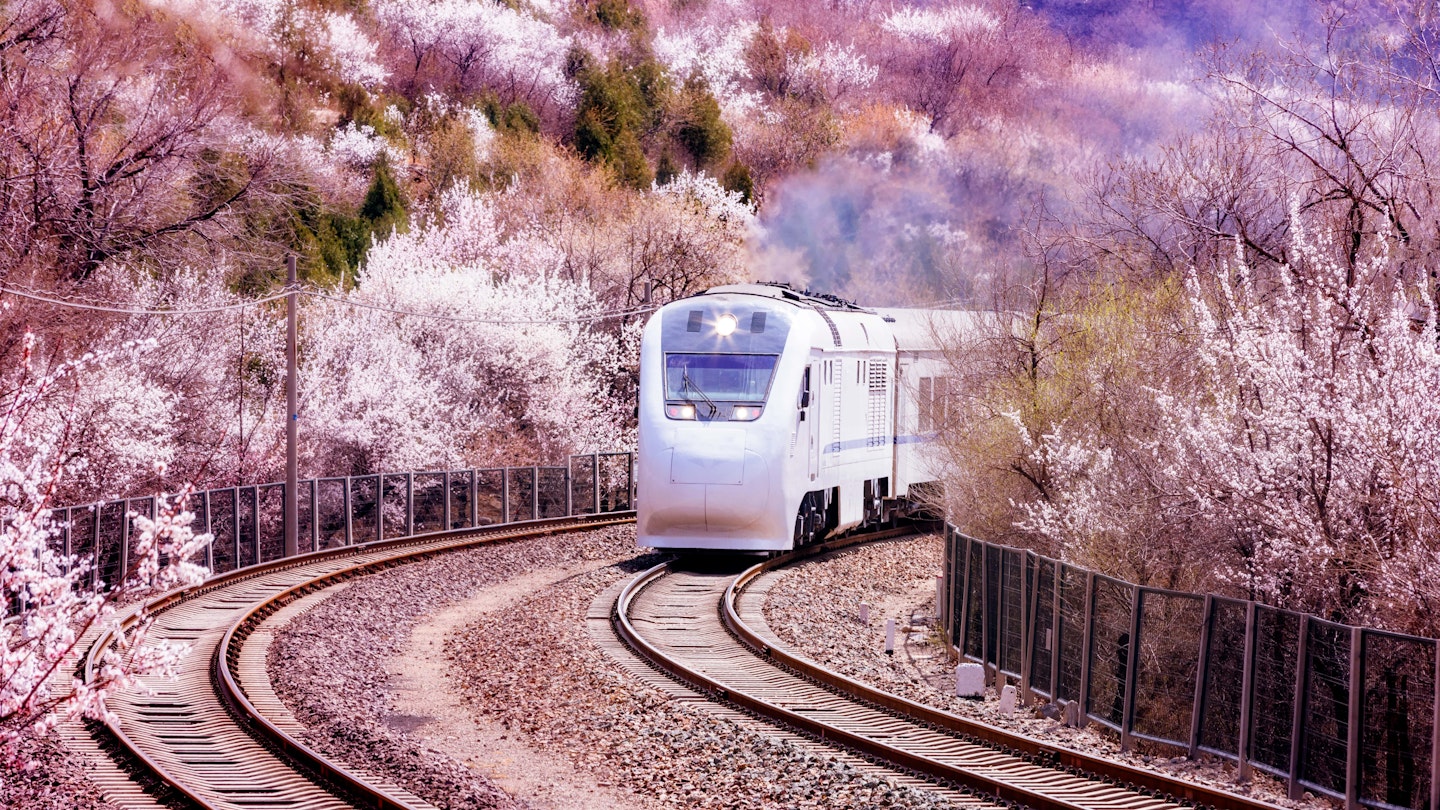
China's trains offer a highlight reel of the nation's best sights – soaring Himalayan peaks, bamboo forests, ancient temples and remote deserts © linlypu/Shutterstock
A nation of vast distances and ever-changing landscapes, China is a destination that’s simply made for train travel. While you’ll encounter the classic imagery of the country’s mist-shrouded jagged peaks and pine-clad temples, you may be surprised by what else is on offer.
From the snow-capped Himalayas and Silk Road oasis towns to grassy Inner Mongolian steppes and bamboo forests, China’s expansive rail network gets you right in amongst it – reaching speeds in excess of 300km/h, the arrival of the fast-train network has been a game changer. Not only has it halved the time required to travel across the country, but it’s infinitely more comfortable and reliable, and offers a much greener alternative to flying . And with the unveiling of the Maglev bullet trains , clocking in around 600km/h, rail travel is about to get even faster.
Here are our picks for the best train journeys running through China, to see beautiful landscapes, epic World Heritage sites and beyond.

Beijing to Lhasa (3757km)
One of China’s most epic train journeys is this spectacular two-day trip along the highest railway line in the world. Running from the nation’s capital all the way to Tibet , it covers some 3757km across eight provinces.
Departing Beijing in the evening, you’ll awake to the flat rural landscapes of the North China Plain, but it’s not until reaching Qinghai (2275m) that the highlights reel clicks into gear. Here you’ll pass through the Tibetan Plateau as you make your ascent to the Roof of the World . The remaining 1110km to Lhasa features 86% of the line above 4000m; the highest point is at Tanggu-la Pass (5072m), the highlight, where you’ll be treated to the sharp-contoured snowy mountains overlooking stunning grasslands home to Tibetan nomads and yaks.
And for those wanting to make the trip in luxury, the Golden Eagle Shangri-La Express does the journey too.

Trans-Mongolian (7621km)
No discussion on China train travel is complete without mention of the Trans-Mongolian route . One of the world’s great rail journeys, this seven-day, six-night bucket-list adventure travels 7621km from Beijing into the wilds of the Gobi desert, the Mongolia steppe and the endless birch forests of Siberia before pulling into Moscow.
Departing from Beijing , the Chinese leg takes you through the dramatic forest mountain scenery of Northern China's Hebei and Shandong provinces before entering the grass steppes of Inner Mongolia. Reaching the Mongolia border, you’ll encounter the remarkable process of the changing of the bogies, in which each carriage is painstakingly hoisted up to change the gauge from the Chinese to Russian line before continuing on its way.
Another option from Beijing is the Trans-Manchurian (8986km). This less-traveled journey takes you through China’s northeast provinces before arriving at Harbin , from where it shoots through Inner Mongolia to reach the Russian border and on to Moscow .
Hefei to Fuzhou (850km)
Unquestionably one of China’s most scenic high-speed railways, this route passes not one, but three World Heritage sites. Beginning in Hefei in Anhui province, this bullet train races through China’s southeast to arrive at Fuzhou in Fujian province. It’s a four-hour journey through mountainous scenery of mist-cloaked pine forest, canyons, rivers, tea plantations and well-preserved villages. Highlights include Huangshan , Sanqingshan National Park and Mt Wuyi, all featuring idyllic trails leading to summits with astonishing lookouts.
Xian to Urumuqi (2344km)
Linking China to the West, the ancient trade route of the Silk Road has long evoked a sense of romance for travelers far and wide. And though the days of camel-drawn caravans are long gone, the Lanzhou–Xinjiang High Speed Train enables you to retrace their steps in quicker and more comfortable means.
Boarding the train at the Silk Road’s historical starting point in Xi'an , you’ll shoot through the plains of Shaanxi province to arrive at Lanzhou in Gansu. Here you’ll transfer to another bullet train to Xinjiang province, from where you’ll pass through China’s northwest wilderness, admiring the Gobi Desert, grasslands and snow-capped mountains among the rapid-fire development of new cities. Arriving at the provincial capital of Ürümqi , you’ll notice a distinct exotic flavor that feels more Central Asia than mainland China.

Guiyang to Guangzhou (856km)
If ever there was an example of just how much China’s fast-train network has made a difference, then the route between Guangzhou and Guiyang is it. Back in 2014, it took 20 hours; today it takes little more than four.
Beginning in Guiyang, the train travels southeast through Guangxi’s attractive verdant valleys to reach Guilin and Yangshuo , with its famous karst limestone peaks. Jutting out like sharp mossy teeth that span the horizon, it’s as spectacular as it is surreal; so otherworldly, in fact, it was used as the backdrop to the Wookiee planet Kashyyyk in Star Wars: Revenge of the Sith . You’ll pass among its rice fields and the scenic Li River before crossing into the Cantonese province of Guangdong to arrive at Guangzhou – one of China’s biggest and most dynamic cities.
You may also like: The most epic overnight train journeys in the world Great Wall: get to know China's most iconic structure How to plan your dream trip to the Himalayas
Explore related stories

Mar 14, 2024 • 10 min read
Whether it's bus, train, private car, motorcycle, bike, plane or boat, you can plan your trip around Vietnam with this guide to getting around.

Jan 2, 2024 • 11 min read
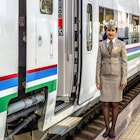
Jul 18, 2023 • 5 min read

Jul 3, 2023 • 3 min read
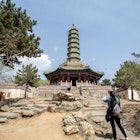
Apr 5, 2023 • 5 min read

Oct 27, 2021 • 7 min read

Sep 20, 2021 • 5 min read

Feb 23, 2020 • 2 min read

Jan 22, 2020 • 11 min read
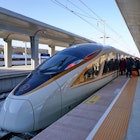
Jan 13, 2020 • 1 min read
- 86-19138970032 (GMT+8 18:00~09:00)

- Beijing Xian Tours
- Shanghai Beijing Tours
- Hong Kong Guilin Tours
- Hangzhou Suzhou Tours
- Kunming Lijiang Tours
- Shanghai Yangtze Cruise Tours
- Chengdu Tibet Tours
- More Short Stay Tours
- China Tours in January
- China Tours in February
- China Tours in March
- China Tours in April
- China Tours in May
- China Tours in June
- China Tours in July
- China Tours in August
- China Tours in September
- China Tours in October
- China Tours in November
- China Tours in December

- High Speed Trains
- China Yangtze Cruise Tour
- Photography
- Desert Adventure
- Ethnic Villages
- Biking Tours
- Kung Fu Tours
- Heritage Sites Exploration
- China Spring Tours
- China Summer Tours
- China Autumn Tours
- China Winter Tours
Notice! 2024 available cruise routes include 4~5 days Chongqing-Yichang(most classic) and 11~12 days Chongqing-Yichang-Shanghai(limited).

- Best-value Yangtze Cruises
- Top Family-friendly Cruise Ships
- Top 3 Luxury Yangtze River Cruises
- Yangtze River Highlights
- Yangtze River Cruise Routes
- Upstream or Downstream?
- Dining & Drinking
- Accommodations
- On-board Activities
- Yangtze Cruise Booking Steps

- Inner Mongolia

- Fanjingshan
- How to Plan Your First China Tour
- How to Plan Beijing Tour
- How to Plan Xian Tour
- How to Plan Shanghai Tour
- How to Plan Guilin Tour
- How to Plan Sichuan Tour
- How to Plan Family Tour
- 2024 China Travel Ideas
- Best Time to Visit China
- What to Pack for Your China Journey
- Updated China Travel News
- Ultimate Chinese Visa Guide
- Chinese Visa Types
- Chinese Visa Requirements
- Do I Need a Visa for China
- Chinese Visa Application
- Chinese Visa Exemptions
- 144-hour Visa Free
- Shenzhen Visa on Arrival
- Hainan 30-day Visa Free
- Embassies & Consulates
- Invitation Letter
- Useful Visa FAQs & Tips
- Entry Regulations
- Baggage Allowance
- Customs Declaration
- Exit Regulation
- How to Book Train Tickets
- How to Collect Train Tickets
- How to Cancel & Alter Train Tickets
- How to Read Train Tickets
China High Speed Train Types
Seats class & how to choose, friendly facilities on the train, the train station departure process, available food and drinks on the train, western toilets on the train, luggage racks & baggage allowance.
- Beijing Train Stations
- Shanghai Train Stations
- Guilin Train Stations
- Xian Train Stations
- Chengdu Train Stations
- Hong Kong West Kowloon Railway Station
- Beijing - Xian
- Beijing - Shanghai
- Guangzhou - Shanghai
- Shenzhen - Shanghai
- Chengdu - Xian
- Shanghai - Hangzhou
- Shanghai - Xian
- Chengdu - Chongqing
- Kunming - Lijiang
- Beijing Capital International
- Beijing Daxing International
- Shanghai Pudong International
- Shanghai Hongqiao International
- Guangzhou Baiyun International
- Hangzhou Xiaoshan International
- Chengdu Tianfu International
- Chengdu Shuangliu International
- Xian Xianyang International
- Shanghai - Beijing
- Hong Kong - Shanghai
- Guangzhou - Beijing
- Chengdu - Lhasa
- Shanghai - Guilin
- Shanghai - Sanya
- Travel in Spring Season
- Travel in Summer Season
- Travel in Autumn Season
- Travel in Winter Season
- Weather in January
- Weather in February
- Weather in March
- Weather in April
- Weather in May
- Weather in June
- Weather in July
- Weather in August
- Weather in September
- Weather in October
- Weather in November
- Weather in December
- Top 10 China Destinations
- Top 15 Things to Do
- China World Heritage Sites
- Top 10 Best Natural Beauties
- Top 10 Museums in China
- Top 10 Old Towns & Villages
- Five Great Mountains in China
- Top 10 Monasteries & Temples
- Top 10 Ski Resorts
- Top 10 Beautiful Lakes in China
- 7 Best Beaches in Sanya
- Top 6 Beautiful Waterfalls
- Panda Volunteering
- Having fun on Ice and Snow Festival
- About Us Who We Are Our Team Why Travel with Us Feedback & Reviews Travel Stories Travelers' Gallery Payment Guide Customer Support Contact Us
- Tour Experiences
Destinations
- Travel Guide

- Beijing-Shanghai
- Beijing-Xian
- Shanghai-Suzhou
- Shanghai-Xian
- Shanghai-Hangzhou
- Xian-Chengdu
China Trains Guide
Move around China in an awesome way! China has the second longest and busiest rail networks in the world as well as the longest and busiest high speed rails (HSR) in the world. By the end of 2017, China has constructed over 45,000 kilometers high speed rails to form a vast network which stretches from east to far west, and south to north. Over 500 cities and towns can be reached by advanced and modern high speed bullet trains which are comfortable, secure, efficient, convenient, environment-friendly, and run at speeds of 250km~350km/h. Fuxing trains, the newest generation of China high speed trains, can bring travelers to get to Beijing from Shanghai within 5 hours (1,318km), get to Xian from Beijing within 4 hours (1212 kilometers) and get to Guilin from Guangzhou within 2.5 hours (550km).
Worry-free train journey with China Discovery!
As more and more destinations having been connected by high speed rails, it is becoming more and more popular to travel China by high speed bullet trains. It is a great treat with comfort and unique experience in China. As the expert of China Train Travel, China Discovery has made fully use of our expertise to help thousands of travelers travel China with our well-designed high speed train tour packages during the past few years. Travelling with China Discovery, you only have to focus on enjoy the vacation as we will take care of all the details, including train tickets booking and collecting, train tickets delivery, pick-up and see-off at railway station, tour arrangements and guide service, etc. Start to plan a China train journey now !
- China Railway will operate 40 more high speed trains between Hong Kong and Guangdong, and 22 high speed trains between Hong Kong and other cities outside Guangdong, such as Beijing, Shanghai, Xiamen, Chongqing, Guilin, Kunming, etc., from April 1, 2023. - 23/03/2023
- China Discovery collected 8 Most Beautiful High Speed Railways in China. - 20/02/2023
- The second high speed railway from Chengdu to Kunming has been put into operation. It makes middle stops at Xichang(西昌), Panzhihua(攀枝花), etc. - 15/01/2023
- Zhangjiajie has high speed railways now. Currently you can take high speed train to Zhangjiajie from Shanghai, Guilin, Zhengzhou, Guangzhou, etc. You can also take a high speed train to Fenghuang Ancient City from Zhangjiajie now. - 24/12/2021
- China-Laos railway has been put into operation since December 3, 2021. The railway starts in Kunming, runs south through Yuxi, Pu'er, Xishuangbanna, and the border ports of Mohan in China and Boten in Laos, before entering the northern region of Laos and reach the capital city of Laos, Vientiane. - 24/12/2021
Get High Speed Train Ticket First
To travel China with high speed train, you should get a train ticket first. Currently, there are both paper ticket and E-ticket. E-ticket is only available in some stations. You have to collect train tickets before boarding your train. You can find your train number, seat/sleeper number, ticket fare, seat class, train station as well as your name and passport number (Real-Name Ticket Policy).
It is now easy to buy train ticket on China Railway's official ticket website 12306.cn as a English version has been launched. You can register account with your passport and email to buy train tickets. You can also buy ticket at the railway station or let third-party organizations to book for you. The ticket can be booked 15 days in advance. Passport is always necessary for both ticket booking and train boarding. If you travel with children under 120cm, you can buy the discounted Children tickets .
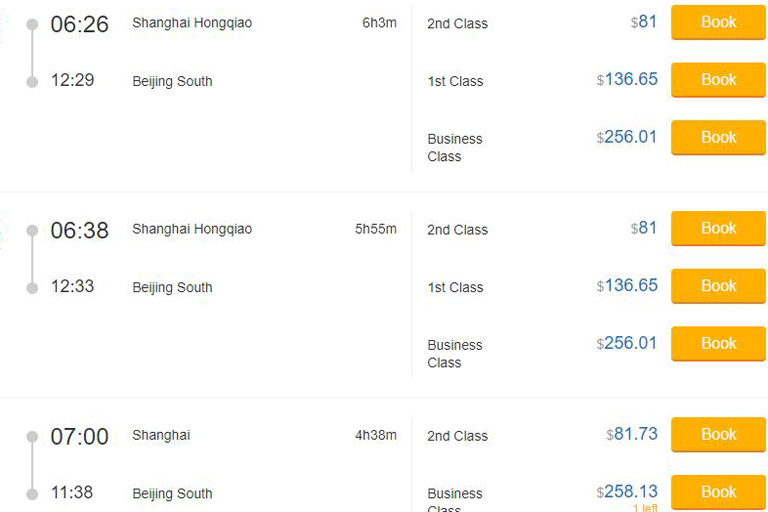
Most Essential Things to Learn about China High Speed Train
Fast, safe, reliable and comfortable high speed trains are now rivaling air travel as an efficient means of transportation for long distances. If you’re planning your high speed train trip or ready to book your train ticket, starting here means you’re on the right track to know everything about China high speed train, including tickets, embarkation and disembarkation, seats, facilities, food and service onboard, etc.
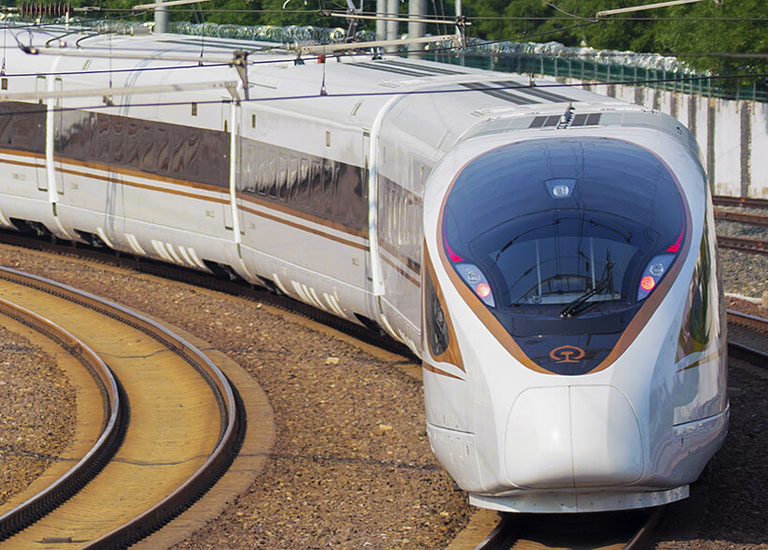
There are three kinds of High Speed Trains in China, differed by the letters G/D/C plus several digits. G-series High Speed Trains are the fastest & most advanced. D-series High Speed Train are the Electric Multiple Units (EMU). C-series usuaully run between two neighboring cities, like Beijing - Tianjin.
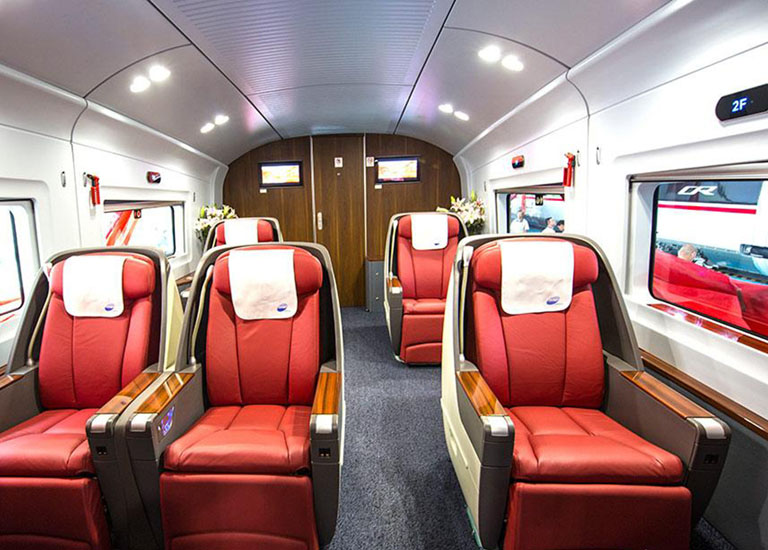
More than 90% of the seats are the Second Class Seats, the cheapest seats on the high speed trains. The First Class Seats are more spacious and quieter, compared with the Second Class Seats. Business Class Seats are much luxury and comfortable, just like the business class on the airplane.
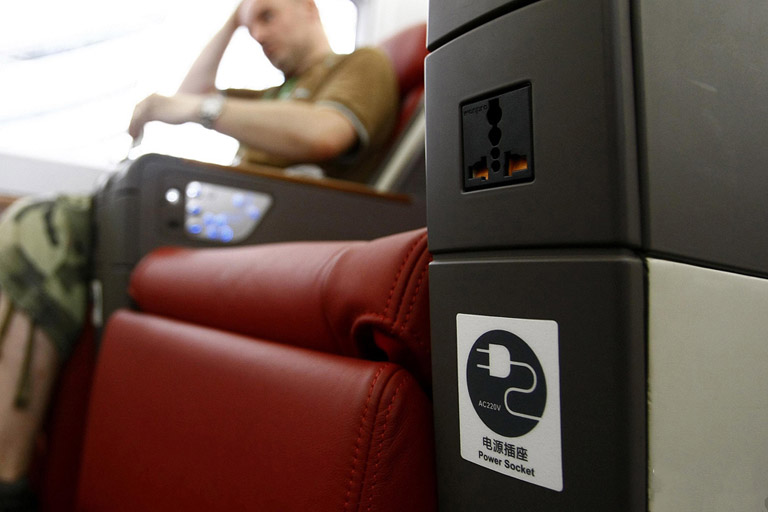
All China high speed trains are fully air-conditioned. There are both western-style toilets and squat toilets on the high speed trains. Every China high speed train has a dining car where you can buy packed Chinese meals of different standards. Power charging is available on each train.
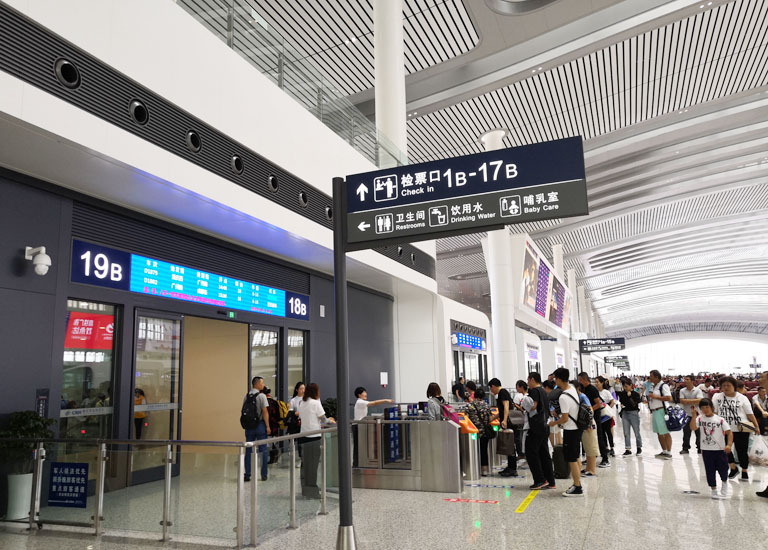
Don’t get intimidated by their massive labyrinths of halls, doors, floors and waiting areas of China's railway station. In fact, the process for boarding and disembarking is much simpler and easier than that of a plane. Usually, the larger railway stations are all user-friendly, and have signs in English for you.
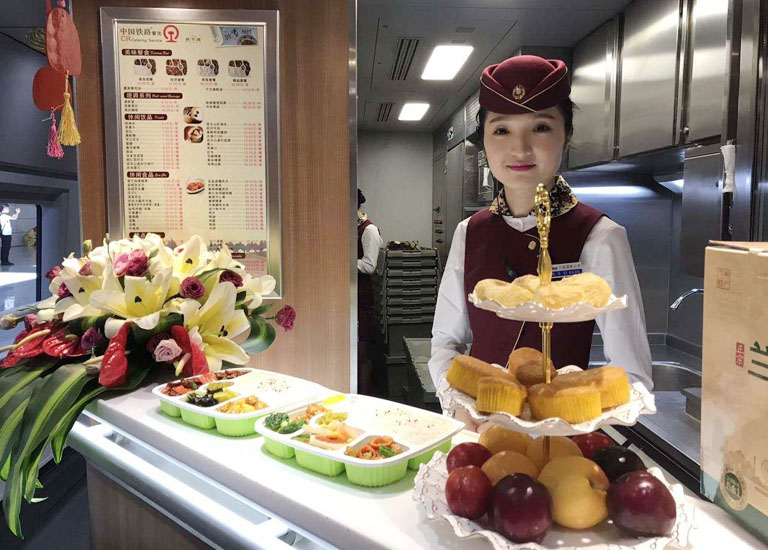
Most China high speed trains provide foods, snacks and drinks. Western food is not provided. The dining car is usually on the 5th carriage. There are several Chinese boxed-meals on the menu. The dining car also offers some common drinks. Hot water can be fetched at the dispenser.
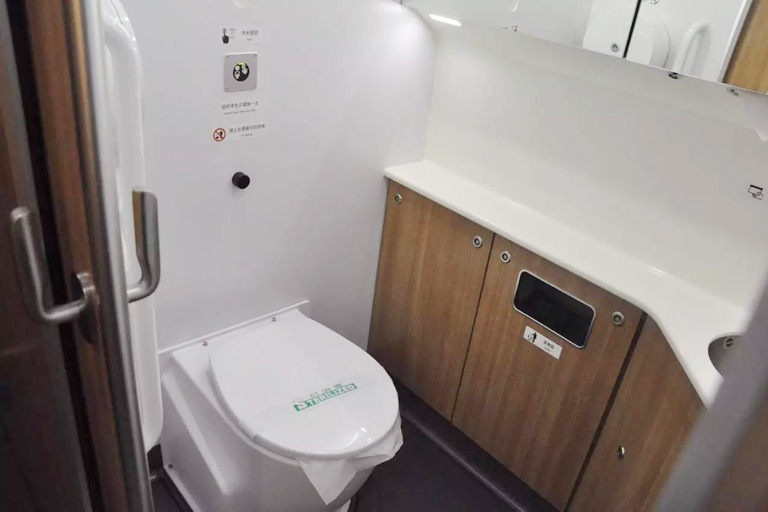
Western-style toilets and squat toilets are usually available on most high speed trains. They are usually modern and clean. Toilet paper is provided in the bathroom, but easily run out. You can bring some on your own. Smoking is not allowed in the toilets. When the train stops at stations, the toilet doors will close.
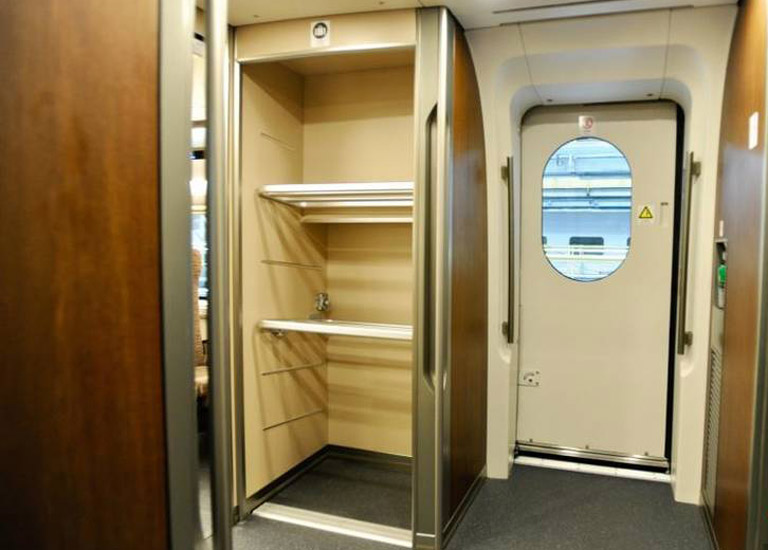
You can put the large-size suite cases in the luggage cabinets at the junction of two carriages or the empty room behind the last row of seats in your carriage. Carry-on suitcases or smaller luggage can be placed on the luggage racks above your seats. Also never pack the prohibited items to board train.
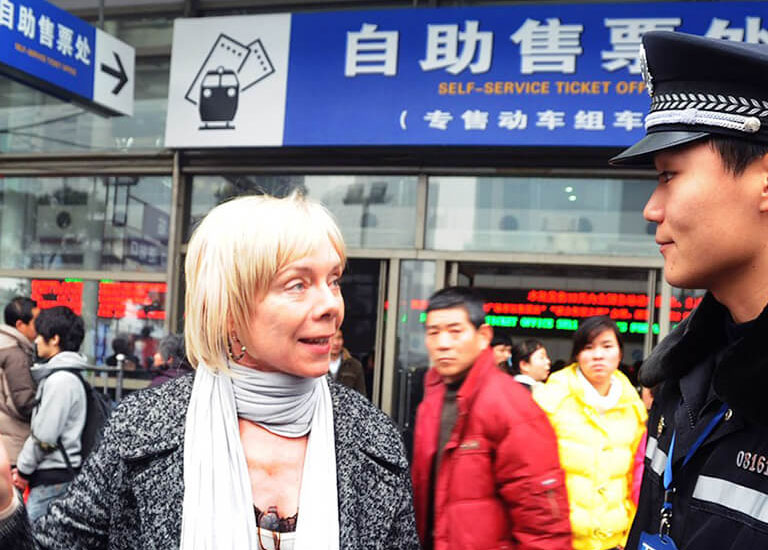
Useful Chinese Phrases for China Train Travel
To help you have a worry free high speed train trip in China, we have collected the most useful phrases, words, sayings which are frequently used to take high speed train in China, such as train types, the names of Ticket Halls, Waiting Halls, railway stations, tickets, etc.
China High Speed Train Cities and Routes
Till 2017, China has put over 25000km's high speed rails into operation, accounting for 66.3 percent of the tracks in the world. Currently more than 500 cities and tows in China are linked by high-speed railways. Almost every provincial capital city in China has its own high speed train station except Yinchuan and Lhasa. But there are continued expansion plans that the only two cities are expected to be covered by high speed train in 2020 and 2025. To best suit for your needs and likes, we’ve collected some of the most popular high speed train cities and railway routes with updated schedules , tickets fares, detailed route maps to help you plan your China trip easily.
- Beijing-Guangzhou
- Beijing-Harbin
- Beijing-Fuzhou (Huangshan)
- Shanghai-Zhengzhou (Kaifeng)
- Shanghai-Kunming
- Xian-Huashan (Mount Hua)
- Xian-Chongqing
- Hangzhou-Huangshan
- Zhengzhou-Xian (Luoyang)
- Lanzhou-Xinjiang (Urumqi)
- Guiyang-Guangzhou (Guilin)
- Chongqing-Chengdu
- Kunming-Guilin (Guiyang)
- Kunming-Dali
- Guangzhou-Hong Kong
- Beijing Pingyao
Get Inspiration from Real China Train Travel Stories
Currently most of the popular China destinations are covered by the massive China high speed railway system, including many China’s highlighting destinations, such as Beijing, Xian, Shanghai, Chengdu, Guilin, Hangzhou, Guangzhou, etc. It’s becoming more and more popular to travel around the beautiful China by the bullet trains now. Among the thousands foreign tourists who have experienced China high speed train trips, there are some friends sharing their true stories. Get inspired from their high speed train travel stories and plan your own riding tour now!

Luxury Shanghai Hangzhou Beijing High Speed Train Journey

China's Superfast Bullet Train Riding from Beijing to Xian

Guizhou is An Ethnic Paradise for Rail Travelers, Come?
Best china high speed train packages for 2024/2025.
To let you find the best trips which get the very essence of China, at the same time allow you to use the fashionable high speed trains as the major transportation means, we have designed many traveler-friendly tour packages, covering many highlighting destinations in China. Race on back of the Oriental Dragon now! No matter it is your first trip, or the second or the third in China, China Discovery will always offer you a suitable tour package which take you to explore China in the best way. Take a train tour among following recommended tour packages to explore China now, or contact us to design your own China holiday!

Beijing / Xian / Shanghai
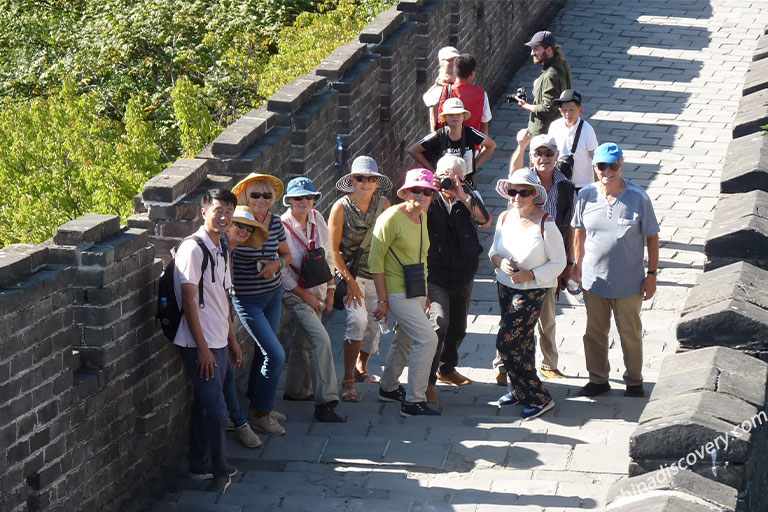
Beijing / Xian

Shanghai / Hangzhou / Beijing

Shanghai / Suzhou / Hangzhou / Huangshan

Guangzhou / Guilin / Yangshuo / Longji / Zhaoxing / Rongjiang / Kaili

Shanghai / Hangzhou / Putuoshan / Xiapu / Xiamen / HK
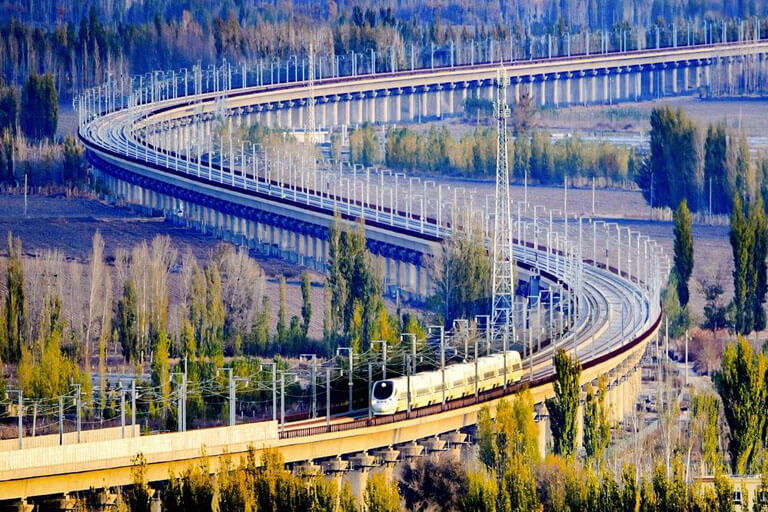
Kashgar / Tupran / Dunhuang / Jiayuguan / Zhangye / Xian / Beijing

Beijing / Pingyao / Xian / Luoyang / Shanghai
Start planning your tailor-made holiday to China by contacting one of our specialists. Once inquired, you’ll get a response within 0.5~23.5 hours.

Have a question? Get answers from our travel experts or guests
- Your Question:
- Your Email:
- Affordable and valuable price
- 100% tailor-made packages
- Highly rated customers reviews
- Efficient customer support
China Tours
- Top 10 China Tours
- Classic China Tours
- China Tours from Beijing
- China Tours from Shanghai
- China Tours from Hong Kong
- China Tours from Chengdu
- Short China Trips
- Customize China Tour
- China Panda Tours
- Family Tour with Kids
- High-Speed Train Tour
- Silk Road Travel
- Yangtze River Cruise
- Hiking & Trekking Tours
- Photography Tours
- China Minority Travel
- Beijing Shanghai Tours
- Shanghai Yangtze Tours
- Chengdu Jiuzhaigou Tours
- Chengdu Lhasa Tours
- Suzhou Hangzhou Tours
- Guilin & Yangshuo
- Zhangjiajie
“Very good experience”
“WONDERFUL 25 DAYS IN CHINA - PRIVATE TOUR”
“Awesome China tour from northeast to southwest”
Any questions, please email us at: [email protected] or call us at: 86-19138970032 (Monday-Friday 9 a.m. to 6 p.m. GMT+8)
- Terms & Condition
- Privacy Policy
- Customer Support
Copyright © 2011-2024. All rights reserved.
Cookie policy
We use cookies to give you the best experience on our website. Continue using our website means you agree with our cookie policy. For more info, please read here .
- China Train Tours
Customize Your Trip to the Real Ch i na
- China Tours
- China Tours by Category
China Family Tours
China's intricate train system, especially the high speed rail (HSR), links the vast country together, which makes travelling to the most intriguing destinations a reality.
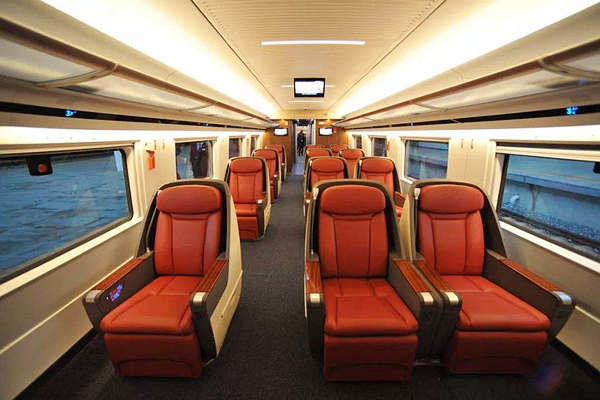
Best China High Speed Train Tours
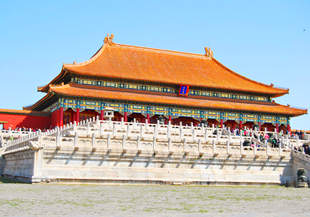
Historic & Scenic China Train Trips
These china train tour packages conjure up the past and get you around the historical destinations and old towns. Also here you’ll find some of the most scenic rides in China that traverse karst peaks, idyllic countryside, remote villages…
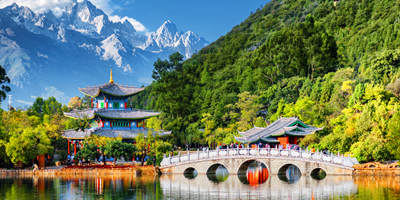
- Visit pandas, plus the Leshan Giant Buddha in Chengdu.
- Travel from Shangri-La to Lijiang & Dali, savoring up history and nature.
- Experience the historic Narrow-gauge Railway in Jianshui.
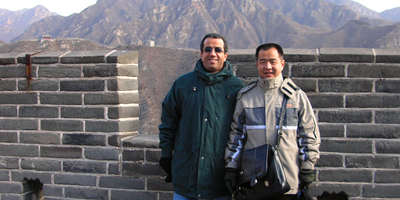
- Old capitals of China: Beijing, Luoyang, Xian & Nanjing
- Remarkable historical sites: the Great Wall, Terracotta Army, Pingyao...
- Ancient Buddhist shrines, grotto art & birthplace of Kungfu
- Slide into the paradise of surreal karst landscape in Guilin.
- Explore Zhangjiajie & Huangshan, experiencing sky walk.
- Delve into local culture of Tai Chi, Terracotta Warriors, etc.
Insider’s Picks for Rail Enthusiasts
Trans-china tours by rail.
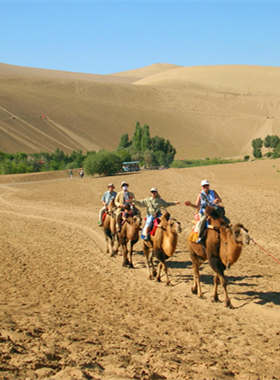
China Silk Road Train Tour

China Silk Road Tour
Take bullet train from historical capitals Beijing & Xian to the exotic Xinjiang, through the remote Tibetan village, stunning “Rainbow Mountain” of Zhangye and numerous ancient ruins, this itinerary brings together the best of Silk Road.
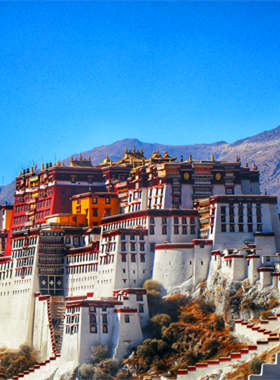
China Tibet Train Tour

One of the bucket list train trips in China, this once-in-a-life-time journey combines ancient wonders of China, historical sites and the great wilderness of Qinghai-Tibet Plateau. Pay homage to the Potala Palace and go to picnic at Yamdrok Lake.
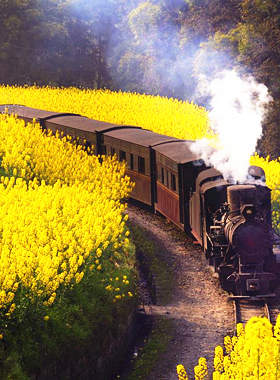
Train Lover’s Tour of China
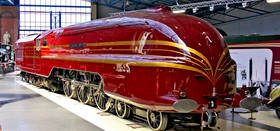
Rail enthusiasts can enjoy a fantastic holiday in China – riding on bullet train, steam train and narrow-gauge train trough cities, villages and beautiful countryside. Visit the best train museums, historical railway stations and the must-sees of China.
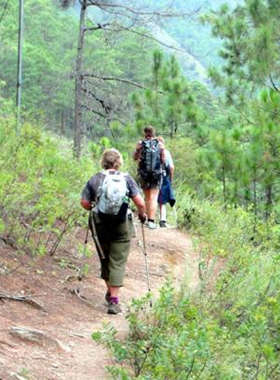
Cheap China Train Tour for Young Adventurers

21 days affordable China train adventure is a semi-independent trip specially crafted for young travelers aged 20 to 35 to save money, time and energy, and make their dream to discover the many faces of real China fulfilled.
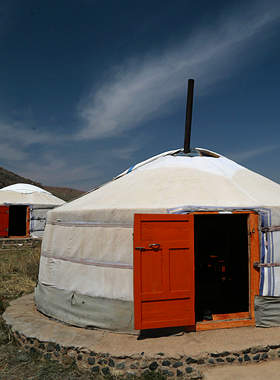
Trans China Train Journey from Mongolia

Take this tour to travel from Mongolia to China by train and continue your train journey across China, all the way to Hong Kong, with visits of Giant Chinggis statue, Hustai National Park, the Great Wall, Terracotta Army…

Trans China Train Journey from Vietnam to Mongolia

Discover the most that Vietnam China and Mongolia have to offer on this epic train holiday (both conventional train and high speed train). Explore world-class attractions, savor local culture, take in natural beauty, experience real local life.
Train Travel Tips & FAQs about China Train Tours

For international travelers, the best way to buy a China train ticket is to book with a China based online travel agency like Easy Tour China that charges reasonable commission fee, and exempt the fee if you book a China tour package with us. If you need to book yourself, book on www.12306.cn, the China Rail official website, and access its English version. >> Read more train tickets booking guide
For all China trains, including bullet train and normal-speed train, there are blue train tickets and red train tickets, which have similar information including boarding gate, departure and arrival stations, train number, departure date and time, ticket price, carriage number and seat/berth number, seat class, passenger’s personal data, and other info. >> Read more for details
For short-distance high speed train tours in China, you can choose from second class seats, first class seats, business class Seats. With a higher level, a passenger can enjoy a bigger size of the seat, as well as a greater personal space.
You can choose to change, cancel or refund a train ticket both online or at a specified window of a railway station. Normally, a passenger can change the departure date, train number, class of seats (berth), and seat (berth) number. You can get full refund if you cancel a ticket 15 days before departure, and have to pay cancelation fee if less than 15 days. >> Read more train ticket change and cancel policy
To make your train trip in China more smooth, it’s better you understand China trains baggage allowance. For both high-speed trains (C/D/G trains) and normal speed trains (K/T/Z trains), the free maximum carry-on luggage weight is 20 kg (44 lb.) for adult, and 10 kg (22 lb.) for a child. The carry-on baggage size is ≤ 130cm (51 in) for bullet train, and ≤ 160cm (63 in) for normal trains. >> Read more what items prohibited on a China train
Yes, it is very convenient and safe for seniors travel in China by train, but high speed train is recommended for the elderly and retirees, instead of the normal-speed train or green train . China high-speed trains and the rail stations give full consideration to the elderly passengers, with senior-friendly facilities, and providing them with a fast, comfortable, convenient and cheap way to travel. The elderly people with walking difficulties should be escorted to the train station by family or friends. You can contact the customer service of the railway station for assistance in advance. The station service staff will open the “green channel” -- the fast access, with elevator, wheelchair, and some other tools, for the elderly to get into the station and get on the train.

Most-read Articles about China Train Travel
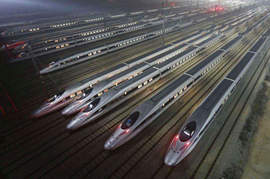
Top 7 Reasons to Travel by Train in China
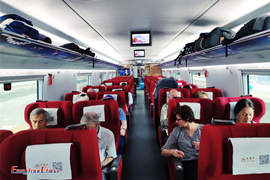
All You Should Know How to Take a Train in China
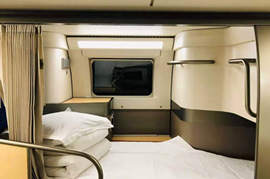
Must-knows Before Making a Train Travel Plan in China
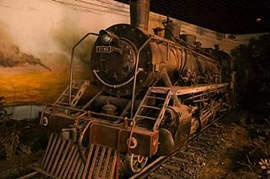
Top 8 Railway Museums in China
Create your trip to real china.
Train travel in china.
- Buy train tickets
- Buy ferry tickets
- Book a hotel
- Privacy & cookies
- Home
Train travel UK & Ireland...
Train travel in europe..., train travel in asia..., train travel in africa..., train travel in america..., train travel in australasia, how to take the train in china.
China has one of the biggest and busiest rail networks in the world, and trains link almost every town & city. Chinese trains are a safe, comfortable, punctual & cheap way to travel around China, and a Chinese train journey is an experience in itself, in contrast with less reliable and environmentally-unfriendly internal flights. This page will help you understand & plan train travel in China, & arrange your train tickets.
UPDATE 2024 : Travel to China is open again post-pandemic. China-Vietnam and China-Russia trains are still suspended, a limited China-Mongolia and a new China-Laos train service are operating.
Train times & fares for popular routes
International trains & ferries.
Beijing to Ulan Bator & Moscow by Trans-Siberian railway & onwards to Paris & London
Beijing, Xian & Ürümqi to Almaty & Astana (Kazakhstan)
Beijing to Hanoi (Vietnam) by train , onwards to Saigon , on to Phnom Penh & Bangkok
Beijing to Japan by ferry
Beijing to South Korea by ferry
Beijing to North Korea by train
Beijing to Taiwan by ferry
Hong Kong to Hanoi (Vietnam)
Kunming to Hanoi (Vietnam) by train
Lhasa to Kathmandu by bus & onwards to Delhi
Other information
Tours of China by train - organised for you
Recommended guidebooks for China
Travel insurance
Hotels in Beijing Hotels in Shanghai Hotels in Xian
Hotel suggestions in Beijing & Shanghai
Get a VPN to access Twitter, Facebook, Google and so on whilst in China
Useful country information
How to check train times & fares.
For online train timetables in English between any two major Chinese cities, use the journey planner at one of these sites:
- www.chinahighlights.com (also gives fares, in US$)
- www.trip.com
Be aware that some online journey planners aren't connected directly to the Chinese Railways system, they take periodic downloads. One site may therefore be more up to date than others.
The official Chinese Railways website is www.12306.cn , previously Chinese-only, it now has an English version.
Beijing Metro: For a map, see www.johomaps.com/as/china/beijing/beijingmetro , showing Beijing Main (Zhan), Beijing West (Xi) & Beijing South (Nan) mainline stations. Metro website www.bjsubway.com . Another simpler metro map is at www.explorebj.com/subway .
Shanghai metro: service.shmetro.com/en/ .
Maps of the Chinese train network
cnrail.geogv.org/enus - interactive map, you can search for a station or enter a train number to see the route taken by that train. High-speed lines shown in red, classic lines in green.
www.chinahighlights.com/image/map/china-railway-map-big.jpg
www.cnvol.com/images/chinarailwaymap.gif ,
www.johomaps.com/as/china/chinarail.html
A neat little site that will map the calling points of any train number you enter: cn.freepublicinfo.org .
Map of Beijing: Click for street map of Beijing showing stations & main sights .
How to buy tickets
When do reservations open .
Reservations usually open 30 days before departure for online bookings and 28 days before departure for sale at stations, for most long-distance trains. You cannot buy tickets before reservations open.
Some D-category sleeper trains only open 20 days ahead. Some C-category trains only 10 days ahead.
The booking horizon used to be 12 days (10 days at stations), but was increased to 20 days in January 2013, then to 60 days in December 2014. However, a temporary shortening to 30 days in early 2017 has become permanent.
Do tickets sell out?
Yes they do. Most long-distance trains get fully-booked days ahead. So book as many days ahead as you can or pre-arrange tickets online as explained below . Although as China's new G-category high-speed trains are expensive by Chinese standards you'll sometimes find Beijing-Shanghai or Beijing-Xian high-speed train tickets available on the day of travel or the day before, assuming you are flexible as to the class or exact departure time. But in all other cases, long-distance train tickets often sell out days before departure. Train tickets are best booked at least 3-4 days in advance, preferably more, apart from peak holiday periods when they should be booked as soon as reservations open or secured through a train ticketing agency who knows the ropes, as trains get very fully-booked weeks ahead.
Peak holiday periods means on and around the Spring Festival, May Day on 1st May and National Day on 1st October. It's also busy throughout the summer, and the beginning or end of university terms. At other times, trains can still sell out but it's usually possible to secure seats or sleepers a few days ahead.
But why not see for yourself? If you run an enquiry on www.chinahighlights.com/china-trains or www.trip.com for today, tomorrow or a few days time, you'll see which trains are sold out, which are still available, an d which have only a few seats left. As I write this, most Beijing-Shanghai trains are sold out for the day after tomorrow, but a few trains still have seats left the day after that. It's a similar story between Beijing and Xian.
How to buy tickets online
Chinese Railways launched online booking in 2011 at www.12306.cn , but until 2020 it was only in Chinese. It now has an English version, but unless that has changed too, it only accepts Chinese bank cards. So visitors to China should buy tickets through one of the following reliable recommended agencies, who charge a small fee.
Option 1, b uy at Chinahighlights.com
www.chinahighlights.com/china-trains is a reliable and helpful train ticketing agency which has been around since 1998. They have developed a clear & easy-to-use English-language train booking website linked to the Chinese Railways ticketing system to show train times, fares & availability for any train journey within China. They can book Chinese domestic trains and now also international trains to or from Hong Kong and from China to Hanoi, Ulan Bator & Moscow.
Prices are shown in US Dollars, they add a service fee of around $6 per ticket.
You can book months ahead if you like , they will take your booking request before reservations open and will make the actual booking with Chinese Railways the maximum 30 days before departure, as soon as reservations open. Booking with them more than 30 days ahead therefore gives you a 99% chance of getting the exact date, train & class you want, at least outside peak periods when half of China is trying to do the same thing!
After making a booking at www.chinahighlights.com/china-trains you'll be sent a payment link, and staff will contact you when the booking has been confirmed with Chinese Railways. A s with all Chinese train ticket agencies, the actual booking is made by staff behind the scenes (not 'live' online) so is only confirmed when you get their confirmation email.
Travel is now ticketless, you scan your passport at the automatic gates at the entrance to the platform, the system recognises your passport number, knows you have a reservation and lets you through, see the section below about finding & boarding your train .
Tip: If you find a self service ticket machine of the latest type which recognises passports as well as Chinese ID cards, you can use it to print out a reminder of your itinerary with car & seat numbers, and/or after your journey use one to print an old-style ticket (now merely a reimbursement slip) as a souvenir, see the self-service ticket machine section below .
If you have feedback from using www.chinahighlights.com/china-trains , do please e-mail me . So far they have been reported as providing a prompt and efficient service.
Option 2, buy at Trip.com
www.trip.com (formerly Ctrip.com) also offers live online train times, fares & tickets, it's a well-known long-established site with a great reputation which is also useful for hotels & flights.
Trip.com can book any Chinese domestic train, also high-speed trains to/from Hong Kong, but not other international trains or the sleeper trains to/from Hong Kong.
You can select a range of currencies including RMB, $, €, $ & Au$.
You need names & passport numbers for each passenger. You can order online before Chinese Railways opens bookings, www.trip.com will book tickets for you as soon as booking opens.
Trip.com charges the official Chinese Railways price plus an RMB 30 ($5) fee per ticket, which they call a Hotel Promotion Code.
Tip: If you find a self service ticket machine of the latest type which recognises passports as well as Chinese ID cards, you can use it to print out a reminder of your itinerary with car & seat numbers, and/or after your journey use one to print an old-style ticket (now merely a reimbursement slip) as a souvenir, see the self-service ticket machine section below .
If you have feedback from using www.trip.com , do please e-mail me .
Option 3, buying tickets for departures from Hong Kong
You can easily look up train times and buy tickets between Hong Kong and Beijing, Shanghai or Guangzhou in either direction at www.chinahighlights.com/china-trains . Tickets can be sent to a hotel or private address anywhere in mainland China, Hong Kong or Macau. They get good feedback for their service and charge in US$ and add a service fee of around $20. On www.chinahighlights.com , Hong Kong's Hung Hom station is listed as 'HongKong'.
Alternatively, if you're willing to make a bit more effort to save on the booking fee, you can book departures from Hong Kong to Beijing and Shanghai by email at the official ticket office price through KCRC (Kowloon Canton Railway Corporation) Customer Services. Visit their website at www.mtr.com.hk (click 'customer site' then 'intercity passenger services' then 'more information'. Note that the online booking system on their intercity trains home page is only for the HK to Guangzhou intercity trains, for the Beijing & Shanghai through trains you'll need to email their customer services department. When looking up times and fares on their website, remember that Hong Kong is shown as 'Hung Hom'). You will be given a reference number and can then pick up and pay for tickets at Hong Kong's 'Hung Hom' station in Kowloon. Note that Hong Kong ticket office does not accept credit cards, only cash. However, there is an ATM just round the corner from the station.
Back to top
How to buy tickets at the station
It's fairly easy to buy tickets yourself at the station even if you don't speak Chinese, although trains are busy so book as many days ahead as you can and be prepared to take a second choice of train, class or date. Expect an X-ray bag check to enter the ticket office.
Take your passport!
Remember to take your own passport and the passports of all other passengers. Rules introduced in 2011 make it essential for foreigners to show a passport to buy tickets for any long-distance train. You'll also need your passport to board the train. A Chinese citizen's ID card, foreigner's temporary residence permit, exit-entry permit or diplomatic certificate can be used to buy tickets instead of a passport.
Check the train availability board!
At major stations you'll see a colourful LED display showing how many seats are left in each class on each main train departure today and for the next week or so. Don't waste time queuing to ask for a ticket today if the board above your head is clearly showing zero seats left on that train! See what these look like and how to read them below .
Which ticket window for which trains?
Ticket windows are only signed in Chinese, apart from a few labelled as for cancellations & refunds. However, don't worry, in a major station ticket hall, all ticket windows can generally sell tickets for all trains and routes. Chinese Railways have a central computer reservation system so you can buy tickets for any route at any station. But when picking a train, remember that it's usually easier to get tickets for a train which starts at the station you're at, rather than one starting somewhere else and picking up passengers at your station en route.
English-speaking ticket windows
There is a special English-speaking ticket window for foreigners at Beijing main station, usually window 16 in the separate ticket office to the right of the main building accessed off the forecourt, see the photos below . You may also find English-speaking windows at Xian and Shanghai.
Language problems? Use these useful booking forms!
You won't always find an English-speaking window. Use these handy forms designed by Chinese rail expert Duncan Peattie and updated by Eliot Zhang, which not only help you ask for what you want, they will help you understand the booking clerk's reply if your first choice isn't available. Your hotel can help you write down the place names.
Download booking form for C, D, G category high-speed trains
Download booking form for Z, T, K category trains, including sleepers .
Travel is now ticketless
You won't be given a ticket as travel is now ticketless and all you need is your passport to board the train, see the section below about finding & boarding your train . However, when you book travel in person at a ticket office, you'll be given a printout confirming your journey details. This is not a ticket!
At Beijing station (= Beijing or Beijing Railway station)
T he ticket office is a separate block to the right of the main building as you stand on the forecourt, clearly marked 'Ticket Office'. Expect a baggage X-ray check at the door. Only domestic Chinese tickets are sold, not international tickets. One or two of the many ticket windows are designated for foreigners, a red LED display may tell you which one. It's often window 16, but not necessarily. Allow plenty of time to buy your ticket, as you may have to queue.
At Beijing West station (= Beijing Xi or Xizhan)
There are various ticket offices including offices on both the north and south sides of the station, directly accessed from outside the station. At Beijing West you need a ticket to enter the departures area. As Beijing West is a mile or two outside central Beijing, you may find it easier to buy tickets at Beijing station.
At Beijing South station (= Beijing Nan or Beijingnan)
There are various ticket offices inside the main departures hall. Go through the X-ray and metal detector security checks into the main departure hall and look for one of the offices around the sides. As Beijing Nan is a few miles outside central Beijing, you may find it easier to buy tickets at Beijing station.
To buy Trans-Siberian tickets in Beijing from Beijing to Ulan Bator or Moscow, see the Trans-Siberian page . To buy tickets from Beijing to Hanoi , see the Vietnam page .
At Shanghai station
The English speaking ticket window at the main station was window 43 though this has now been reported as changed to window 10 on the ground floor of the main ticket office to the southeast of the main station.
At Shanghai Hongqiao
There are several ticket offices inside the main departure hall. Go through the X-ray and metal detector security checks into the main departure hall and look for one of the offices around the sides.
Alternatively, buy from a local train ticket agency
In major cities, it can be more convenient to buy tickets at one of the numerous 'hole in the wall' ticketing agencies located all over the city. These local offices charge an RMB 5 (50p or $1) extra fee, just ask your hotel if there is one nearby or use the 'Train Ticket Office Search' at www.cnvol.com . Don't expect these local agencies to speak English, so ask your hotel to write down your destination, date, time and class in Chinese to show the staff.
Train availability displays in ticket offices
You'll find these train availability boards at all main station ticket offices and they're not hard to read, even though they're in Chinese. The photo below was taken at Beijing West on 1 August, and as you can see, there's zero availability in any class for today's train G625 leaving at 18:56, so don't waste time asking. But there's plenty of availability in all classes tomorrow (2nd August) including 13 seats in business class and 36 seats in 1st class and 617 in 2nd class.
At Beijing Railway Station & Beijing West the class columns run left to right as soft sleeper, hard sleeper, soft seat, hard seat then standing places. The soft seat & hard seat columns are used for 1st class & 2nd class on C, D & G-trains and the soft sleeper column is used for premium or business class on those trains.
At Beijing South the sequence from left to right is Business class, 1st class, 2nd class .
Self-service ticket machines
Most stations have self-service ticket machines. Until recently, these were of no use to foreign visitors as they only recognised Chinese ID cards. The latest type now recognises foreign passports, although they don't normally have an English language facility (although an English version may be in the pipeline). That means most visitors will find using them for tickets too difficult, but you can easily use them to print your itinerary, or print a reimbursement slip as a souvenir or to claim expenses.
How to print your itinerary, or a reimbursement slip as a souvenir
If you have already booked online, you can print out a Trip information reminder with your train times, car & seat/berth numbers. You can do this any time before you travel. After your journey you can print out an old-school blue ticket, although this is now only a Reimbursement slip good if you want to claim the journey on expenses or just want a souvenir, it's not valid for travel. You can do this immediately after you travel, or for up to 30 days afterwards. Follow the steps shown below. Photos below courtesy of David Feng.
Finding & boarding your train
Allow time for security checks at the station.
Arrive at the station in plenty of time before the departure of your train, perhaps 30-40 minutes before departure.
At stations where the ticket office is separate, for example Beijing Railway Station or Beijing West, there are queues at the entrance to the station for a ticket & ID check, as only ticket-holders are allowed into the departures hall. Join any queue at any kiosk, have your ticket and 1'wand'.
At stations where the ticket office is inside the main hall, for example Beijing South or Shanghai Hongqiao, there will be short queues just inside the entrance to the station hall for a security check. You put your bags through an X-ray scanner then security staff check you over with an electronic 'wand'.
Scan your passport to access the platform
Once inside the station, look for the departure indicators. At major stations such as Beijing South or Shanghai Hongqiao, the departure boards alternate between Chinese & English. At smaller stations they are only in Chinese, but you can easily make out your train number and departure time, and the platform or gate number to go to, as the photos in this section show. Finding your train is unlikely to be a problem.
There are automatic gates at the entrance to each platform or group of platforms. The gates can read Chinese ID cards & Chinese Green Cards for expats settled in China.
At some stations, each gate has a passport scanner as well as a Chinese ID card scanner. This latest type of gate is shown in the photo below. You place your passport data page face-down on the passport scanner, it reads your passport, knows you have a reservation and lets you through. Your passport needs to be machine-readable, although it doesn't need to be biometric.
At other stations, the gates only have Chinese ID card scanners. Foreign passport holders must use a separate passport reader, located at one end of the gateline, after which you are let through a manual gate. You place your passport data page face-down on the scanner, it reads your passport, knows you have a reservation and lets you through.
A few small stations have no passport readers at all, so you need to ask staff to let you through. Showing a printout of your journey helps with this, if you buy at a ticket office you'll be given a printout, if you have booked online you can get a printout by showing your reservation number at a ticket office window. These printouts are labelled Trip information reminder in English.
Tip: Expenses to claim or you just want a souvenir? You can still get the traditional blue ticket if you like, but this now a Reimbursement slip and not valid for travel. You can collect it either immediately after your journey or for up to 30 days afterwards, from a staffed ticket window or from the latest type of self-service machine which can recognise foreign passports. Watch the video guide .
Boarding a train at Beijing Station
1. Beijing station is in central Beijing, 3 km from Tiananmen Square. It has it's own station on the Beijing Subway, called simply Beijing Railway Station - see Beijing subway map .
2. Beijing main station dates from 1959 and whilst Beijing's South & West stations are modern and airport-like, negotiating Beijing's original station is a more chaotic old-style Asian experience. So arrive in plenty of time, at least 40 minutes before your train leaves.
3. Whether you arrive by subway or taxi, you end up on the station forecourt seen in the photo below left. You then enter the station through any of the 30-odd red-canopied ticket-check kiosks seen in the photo below right in front of the main entrance. There will be a queue in front of each kiosk.
4. Immediately after the ticket check, there's a luggage X-ray check as you enter the building itself.
5. You can then check the departure display to see which waiting room to go to for your train. Boarding usually starts around 20-30 minutes before departure.
Boarding a train at Beijing South: See the Beijing to Shanghai page
Boarding a train at beijing west.
7. You may also find departure boards showing the status of each train. Most trains will be shown as 'on time' with the most immediate departures shown as 'waiting', which means you can enter that train's specific waiting room. Once a train is ready for boarding, usually about 30 minutes before departure, it's shown as 'check in', meaning you can proceed through to the platform. Barriers close 5 minutes before departure, and the train is then shown as 'check out'. Photos in this section are courtesy of Sunil Mehta .
What are Chinese trains like ?
Chinese trains link virtually all main cities and towns in China, and are a safe, comfortable & civilised way to travel, even for families or women travelling alone.
Classes of seat & sleeper on classic trains
Chinese trains generally have four classes, although you won't find every class on every train:
Soft sleeper = comfortable 4-berth compartments. Most western travellers travel soft sleeper, a comfortable, civilised & affordable way to travel. Soft sleepers are spacious 4-berth compartments with two upper & two lower berths by night, converting to two sofas for daytime use. All necessary bedding is provided. There's a table with tablecloth, and usually a vacuum flask of hot water for making tea (or drinking chocolate or cuppas soups if you've brought some). The compartment door locks securely, and a smartly-dressed attendant looks after each car. The best trains even feature individual TV screens and power sockets for laptops & mobiles. Passengers share with other passengers, but this is no problem, and a good way to meet people.
Can you book a 4-berth soft sleeper for sole or dual occupancy? My advice is to do what the Chinese do, buy one ticket for one berth for one person and share. It's not a problem, and you meet people this way.
Hard sleeper = open-plan bunks in bays of 6. If you're on a tight budget or if the soft sleepers are full, there's no reason why you shouldn't go hard sleeper, as many western backpackers do. Hard sleeper consists of open-plan carriages with a broad aisle on one side of the car, bays of 6 bunks (upper, middle & lower) on the other side. In spite of the name, hard sleeper bunks are reasonably well padded, and bedding is supplied. Newer trains even have power sockets for laptops & mobiles.
Soft seat & hard seat: Equivalent to first & second class seats on a European train. Short distance daytime trains often only have hard class seats, though some inter-city trains have both soft & hard class. 'Hard' seats are usually padded and reasonable comfortable, in spite of the name.
Deluxe soft sleeper = 2-berth compartment with toilet. In addition to the normal classes, a handful of trains have deluxe soft sleepers, also known as Superior soft sleepers, include Beijing-Hong Kong, Beijing-Shanghai & Beijing-Xian. These are 2-berth compartments with private toilet. There are only limited numbers of these 2-berth compartments are available, often booked by government officials, so by all means ask for one but don't bang your head against a brick wall trying to get one, be prepared to travel in normal 4-berth soft class if necessary. Sharing a 4-berth really isn't a problem, it's the norm in China, and you might even meet some real Chinese people this way.
Classes of seat on high-speed trains
1st & 2nd class: Just to confuse you, the new high-speed C, D & G category trains are described as having 1st class & 2nd class seats. The Chinese officially classify these trains as 1st class soft seat and 2nd class soft seat , as this allows the Ministry of Railways to get around government regulations that limit the price of normal hard & soft class ticket train fares. 2nd class has very compact seats usually arranged 2+3 across the car width. 1st class has much larger seats arranged 2+2 across the car width.
Business class . G-category high-speed trains have a premium first class called Business class. This has individual electrically-reclining leather seats arranged 2+1 across the car width. There is complimentary green tea and juice and a tray meal may be included in the fare, served at your seat. Business class is spacious, carpeted, and the egg-like business class seats recline to a flat bed at the touch of a button. Business class is expensive even by western standards, but it's a real treat, very civilised and relaxed.
Premium, premier or superior class. Now it gets a bit confusing, so listen up! All the G-category high-speed trains have a small compartment immediately behind the driving cab at each end of the train, originally called 'sightseeing' because you could look through a glass bulkhead through the driving cab to get a view of the line ahead or behind. However, this glass sightseeing window is now permanently kept electrically frosted up, and on some newer trains it's a solid bulkhead in any case, so the term 'sightseeing' is no longer used.
On some trains , the end compartment is fitted with five business class seats, arranged in one 1+1 row across the car width and one 1+2 row. They all rotate to face the direction of travel, and are sold as normal business class.
On other trains there are two business class seats immediately behind the cab, arranged 1+1 across the car width, followed by three more red leather seats arranged 2+1 across the car width. As these three seats are narrower and don't recline or rotate, they are sold as first class.
On a few trains , the end compartment is fitted with 6 seats arranged in two rows 2+1 across the car width. These seats are the same style of seat found in first class, but they are sold at a higher price than first but less than business. The Chinese term for this class is usually translated as premium or premier or superior or occasionally deluxe , depending which website you're using. On a few trains you'll also find these superior class seats in a small 6-seat compartment mid-train. Although you'll never find superior class on a train which has business class!
Restaurant cars, toilets, smoking...
Toilets: Chinese trains generally have both western & squat toilets, but it's always a good idea to take your own supply of toilet paper. The toilets on the modern D & Z category trains are immaculate, so no worries there!
Restaurant cars: Most long-distance trains have a restaurant car, with waiter service of drinks, snacks & meals. The best trains on key routes such as Beijing-Shanghai have menus in both Chinese and English.
Smoking: Smoking is not permitted in the sleeping-car compartments or corridors on any Chinese train, or anywhere at all on board high-speed trains or the pressurised trains to Tibet. But smoking is allowed (or at least, condoned) in the vestibules between carriages and in some restaurant cars on the regular T & K category long-distance trains.
Categories of train
Chinese train numbers usually start with a letter, which indicates the category of train. The better the category of train, the faster it is likely to be, and the more modern & comfortable the carriages are likely to be. Slightly higher fares are charged for the better train categories.
C (Chengji), D (Dongche) & G (Gaotie) trains are China's top-quality high-speed trains with modern air-conditioned coaches and streamlined power-cars at each end. Most are 200-300km/h daytime electric trains, with 'G' category trains the fastest, 'D' category the next fastest. A few overnight D-trains are equipped as high-quality 200km/h sleeper trains. Photos of G-category train . Photos of D category sleeper train .
Z trains (= Zhida, high-quality express sleeper trains): The previous top-quality sleeper train, the Z-trains are now the second best, but still with very modern air-conditioned coaches. Photos of Z category sleeper train
T trains (= Tekuai, extra fast): Trains with a T in the train number are the next best category, see the photos below.
K trains (= Kuaisu, fast): Trains with a K in the train number are 'fast'. Slightly higher fares are charged for better categories of train.
A typical T or K category Chinese train
T & K category trains may not be as glamorous as the front-rank D or Z category trains, but even these T or K trains are usually very comfortable, often modern & air-conditioned.
Luggage on Chinese trains
You take your bags with you onto the train, and put them on the racks in your sleeper compartment. At major stations, bags may be X-rayed before boarding.
In theory, the luggage limit on Chinese trains is 20 Kg for adults, 10 Kg for children, and the maximum dimension of any item should not exceed 160 cm (this is reduced to 130cm on all C, D & G category high-speed trains).
However, in reality no-one weighs or measure your bags, so as long as they will fit through the security X-ray machines and as long as you can carry them all onto the train yourself, you'll be fine. If you really want to transport vast quantities of luggage you can pay for a baggage ticket for bags in excess of the official limits.
Taking a bike
You can't take a bike with you onto Chinese trains as carry-on luggage, bikes have to be sent as cargo on a passenger train with a luggage van, which of course means a classic train, not a high-speed train. There are two options:
Option 1 , you can take it to the luggage office at your starting station and check it in, then collect it again from the luggage office at your destination station. This option is described in Matt Glaspole's report below. Your bike will travel on whatever train has the necessary luggage van with space available, whatever train you choose to use yourself.
Option 2 , you can use a faster door-to-door collect-&-deliver service offered by Chinese Railways between major cities. You may need an agency to help you arrange this.
Traveller Matt Glaspole reports on taking a bicycle on Chinese trains : "Not every train has a luggage van, but if you mention in the ticket office that you have a bicycle, the ticket staff can book you onto a train that has one. If you do have to take a train without a luggage van, the luggage staff will send your bicycle on the next train that does have one. Once you have your ticket, you need to find the luggage office, which is often hidden around the back of the station somewhere. You might not find any English spoken here, but your train tickets should give the staff all the information they need. The luggage service is a bit old fashioned, and the charges can involve a few RMB in 'tips' to the officials involved. The luggage rates are calculated per kilometre like a passenger ticket, but are not as expensive. If you take the pedals or anything else off to prevent joyriding, point this out to the staff so they can make a note of this on the luggage ticket. This indemnifies them from the potential that you or someone else at the other end will accuse them of having lost or stolen the missing bits. Once, I didn't mention to the staff that the pedals were missing, and they starting combing the town near the station to find me, so they could amend the ticket. Accusations of theft must be very serious! My bicycle was never damaged in the luggage vans, although other cyclists have found themselves missing a bungee strap or two from time to time."
Luggage storage at stations
There are left luggage offices at most main Chinese stations, often privatised so markings and signage vary. Look for the suitcase in a square pictogram or the words Left Luggage.
Stations with a left luggage office include Beijing railway station (which has at least two, both accessed from outside in the forecourt), Beijing South (inside the ticket hall), Beijing West (accessed from outside), Xian, Shanghai Hongqiao, Shanghai, Shenzhen.
The left luggage office at Beijing South inside the departures hall is open 06:00-23:00, a medium locker costs RMB 10 (£1, $1.50) for 0 to 7 hours, RMB 15 (£1.50, $2.50) for up to 12 hours, RMB 25 for up to 24 hours. A large locker costs RMB 15, RMB 25 & RMB 40 respectively for the same time periods. Other left luggage offices are likely to charge similar prices.
Beijing to Shanghai
The best way to travel this route is by train. Not only is the train ride an experience in itself, the trains are generally very punctual and reliable than flying, avoiding the many delays affecting flights on this crowded air corridor.
Beijing to Xian
Beijing to Xian by time-effective sleeper or by high-speed train. The best way to travel between Beijing & Xian is by train, either on a time-effective overnight sleeper train which also saves a hotel bill, or on one of the new 300km/h (186 mph) high-speed trains. The high-speed line opened on 26 December 2012 allowing trains to link Beijing West and Xian North in as little as 4h17, with a dozen high-speed departures a day.
Xian North , also known as XianBei , is 10 km north of the city centre on Xian metro line 2.
Xian main station is in the city centre, so significantly more convenient.
G-category high-speed trains have Business class, 1st class, 2nd class and a buffet car. 1st class seats are 2+2 across the car width, 2nd class seats are 2+3 across the car width. Business class consists of leather power-reclining seats arranged 1+2 across the car width in a carpeted car.
D-category highsleeper trains are high-speed sleeper trains with air-conditioned soft sleepers, hard class sleepers & hard class seats.
T-category sleeper trains are classic sleeper trains with 4-berth soft sleepers, hard sleepers & restaurant car.
Distances: Beijing to Xian by sleeper train on the classic route is 1,283 km (801 miles), via the new high-speed route it's 1,198km (749 miles).
The Terracotta warriors are 40-45 minutes from Xian main station by bus 306 or 307, fare about RMB 7. Minibuses & taxis are also available. There are luggage storage facilities (left luggage office) at Xian main station, price RMB 5 per person.
All trains shown here run every day. Finding & boarding your train Luggage arrangements
Beijing metro map . Street map of Beijing showing stations . Hotels in Beijing . Hotels in Xian .
$1 = approx RMB 7.0, £1 = approx RMB 8.9.
As of 1 January 2023, children under 6 travel free (just one per adult goes free), all other children under 14 travel for half fare. Those 14 & over pay full fare. Child discounts only apply to the 'base' part of a sleeper fare, so in sleepers it's closer to a 25% reduction on the total fare.
The sleeper fares shown here are for lower berths. Upper berths (and middle berths in hard sleeper) are a fraction cheaper.
You can easily tickets online at www.chinahighlights.com or www.trip.com once booking has opened .
For full details of how to buy tickets online or at stations, see the How to buy tickets section above .
What are the high-speed G-trains like ?
Second class is fine if you're on a budget, although it's fairly cramped as seats are arranged 2+3 across the car width. A middle seat in the row of three isn't much fun! First class seats are arranged 2+2 across the car width, so are far more spacious and well worth the extra cost. Superior class seats (also known as Deluxe or Premium) are identical to first class seats, but arranged 2+1 across the car width in the sightseeing area immediately behind the cab at each end of the train, 6 seats in each of the two sightseeing areas. The glass to the cab is often kept frosted, defeating the object of the sightseeing area, so I'd stick with regular first class. Some trains have Business class instead of Superior class, and although expensive even by western standards, it's carpeted, spacious and relaxed, with electrically-reclining flat-bed seats and complimentary tray meal. Wonderful if you can afford it. See the photos of the Beijing-Shanghai high-speed trains here , as the Beijing-Xian G-trains are similar.
Beijing to Badaling & Great Wall
You can visit the Great Wall at Badaling by train from Beijing, no need for a restrictive tour. See the Great Wall of China page .
Beijing to Tianjin
High-speed 350 km/h C-category trains (sometimes known as Hexie trains) link Beijing South Station & Tianjin every 10-20 minutes, taking just 30 minutes for the 120 km (75 miles) journey. Simply use www.chinahighlights.com or www.trip.com to find specific train times. The fare is around RMB 58 (£6 or $9) for a 2nd class seat, RMB 69 (£7 or $10) in a first class seat. It's easy enough to buy tickets at the station on the day of travel.
Beijing to Guilin & Nanning
As well as the classic T and Z category sleeper trains from Beijing to Guilin and Nanning, since 2014 there are two Beijing-Guilin-Nanning high-speed trains which do the run in a single day. So you can choose between a high-speed journey done in a single day or a cheaper classic overnight sleeper train ride, both are genuine Chinese experiences. The choice is yours.
G421/G422/G529/G530 are G-category high-speed trains using the new high-speed lines, with 2nd, 1st & business class plus buffet car, see the photos of similar Beijing to Shanghai high-speed trains here .
The T & Z trains are classic trains using the classic route, with 4-berth soft sleepers, hard sleepers & restaurant car.
Train T289/T290 has 2-berth deluxe soft sleepers as well as 4-berth soft sleepers, hard sleepers & restaurant car.
You can check times for this & other routes at www.chinahighlights.com or www.trip.com . Map of Beijing showing stations
Beijing to Guilin is 2,135km (1,334 miles), Beijing to Nanning is 2,566km (1,603 miles) via the classic route. Beijing metro map . .
You can easily tickets online at www.chinahighlights.com or www.trip.com once booking has opened . For full details of how to buy tickets online or at stations, see the How to buy tickets section above .
Beijing to Kunming
Beijing to Kunming by high-speed train or classic sleeper. You can travel between Beijing & Kunming either on a classic Z-category sleeper train night-day-night, or on one of the G-category 300km/h (186 mph) high-speed trains which do the entire journey in a single day. Before you go for the new single-day high-speed option as a knee-jerk reaction, bear in mind that the Z53 classic train still only takes one daytime day out of your schedule, a soft sleeper on the Z53 costs less than a cramped 2nd class seat on a G-train, it gives you more room to spread out, make yourself at home and enjoy the journey across China, and it saves two hotel bills!
G-category high-speed trains have 1st & 2nd class seats, business class seats and a buffet car. 1st class seats are 2+2 across the car width, 2nd class seats are 2+3 across the car width. Business class seats are arranged 2+1 across the car width and go fully flat. See the photos in the Beijing-Xian section .
Z-category sleeper trains are classic air-conditioned sleeper trains with 4-berth soft class sleepers, hard sleepers, restaurant car with menu in Chinese and English. See the photos in the Beijing-Xian section , although there's no deluxe soft sleeper on this route.
Distances: Beijing to Kunming by sleeper train on the classic route is 3,104 km (1,929 miles), via the new high-speed route it's xxxx km (xxx miles).
Finding & boarding your train Luggage arrangements
Beijing metro map . Map of Beijing showing stations . Hotels in Beijing .
Beijing to Guangzhou & Shenzhen
By new high-speed train, new high-speed sleeper or classic sleeper. A new high-speed line opened in December 2012, and 300km/h (186mph) trains now link Beijing West and Guangzhou South in as little as 7h38, on the world's longest high-speed line. Introduced in January 2015, bullet-nosed high-speed sleeper trains run on Friday to Monday nights, taking a single night to do what the classic trains take a day and night to do.
G-category trains run at 300 km/h (186 mph) with business class, 1st class & 2nd class seats and a buffet car. 1st class seats are 2+2 across the car width, 2nd class seats are 2+3 across the car width. Business class consists of leather power-reclining seats arranged 1+2 across the car width in a carpeted car. See the photos of the Beijing to Shanghai G-category high-speed trains here as the Beijing-Guangzhou-Shenzhen G-trains are similar. You'll also find advice on which class to choose on that page.
D-category trains are high-speed sleeper trains , with 4-berth soft sleepers, 2nd class seats & buffet car, see the photos of the Beijing to Shanghai D-category high-speed sleeper trains here as the Beijing-Guangzhou-Shenzhen G-trains are similar.
Z-category trains are classic sleeper trains with 4-berth soft sleepers, hard class sleepers & restaurant car.
How to buy tickets Finding & boarding your train Luggage arrangements Map of Beijing showing stations
Beijing to Guangzhou via the new high-speed line is 2,298km (1,436 miles). Beijing to Shenzhen is 2,400km (1,500 miles).
Beijing to Hong Kong
Hong kong to shanghai : , hong kong to guangzhou : , macau : , shanghai to xian.
Option 1, Shanghai to Xian by high-speed train
High-speed trains running at up to 300 km/h (186 mph) link Shanghai Honquiao station with Xian North station, fastest journey 5h40, with some trains taking 7-8 hours. Check times at www.chinahighlights.com/china-trains or www.trip.com . For sample prices see below.
The trains have business class, 1st class & 2nd class seats and a buffet car. 1st class seats are 2+2 across the car width, 2nd class seats are 2+3 across the car width. Business class consists of leather power-reclining seats arranged 1+2 across the car width in a carpeted car. See the photos of the Beijing to Shanghai G-category high-speed trains here as these trains are similar.
Xian North, also known as XianBei , is 10 km north of the city centre on Xian metro line 2. Shanghai Honqiao station 18 km from central Shanghai near the old airport
Option 2, Shanghai to Xian by time-effective sleeper train
Classic Z-category sleeper trains and high-speed D-category sleeper trains also link Shanghai & Xian. A sleeper is not only more time-effective, it saves a hotel bill and as these trains use the main stations in the city centres, it can be more convenient, saving taxi costs too.
The high-quality Z-category trains have air-conditioned 4-berth soft sleepers, hard sleepers & restaurant car.
The high-speed D-category sleeper trains have 4-berth soft sleepers, 2nd class seats & restaurant car, see the photos here .
You can check times & fares & availability in English at www.chinahighlights.com/china-trains or www.trip.com .
Shanghai to Guangzhou
Choose between a daytime high-speed train taking as little as 6h48 at up to 300 km/h (186 mph) or a time-effective overnight train. The sleepers have an additional advantage, the use a main station in the city centre at least at one end of their journey.
G-category high-speed trains use the new high-speed lines, with business class, 1st class, 2nd class & buffet car, see photos of similar Beijing-Shanghai trains here .
Z99 & Z100 are high-quality sleeper trains with soft sleepers, hard sleepers, hard class seats & restaurant car.
T169 & T170 have soft & hard sleepers, hard class seats & restaurant car.
You can easily tickets online at www.chinahighlights.com/china-trains or www.trip.com once booking has opened . For full details of how to buy tickets online or at stations, see the How to buy tickets section above .
Shanghai to Guilin & Nanning
Choose between a daytime high-speed G-train taking around 11 hours, or a sleeper.
All trains run every day all year round.
The T-category trains have 4-berth soft sleepers, hard sleepers, hard class seats & restaurant car.
The G-category train is a high-speed train using the new high-speed route opened in 2014. Business class, 1st & 2nd. See the photos here .
Trains to Lhasa & Tibet
The first regular passenger trains started running over the new railway to Lhasa in Tibet on 1 July 2006. The Qinghai-Tibet Railway is the highest in the world, climbing from 2,829m above sea level at Golmud (Geermu) to 3,641m at Lhasa, much of it built on permafrost. Its highest point is in the Tanggula Pass, at 16,640 feet (just over 5,000m) above sea level. Because of the lack of oxygen at that altitude, all passenger coaches have extra oxygen pumped into them, and oxygen is available to passengers through tubes if they have problems. Before the railway was built into Tibet, travellers had to take a train as far as Golmud (which the railway reached in 1984) followed by a gruelling 48 hour bus journey to Lhasa. Now there are direct air-conditioned trains from Beijing, Shanghai, Guangzhou & Xian to Lhasa.

Beijing, Xian, Shanghai, Guangzhou to Lhasa by train
Getting a permit for tibet, the journey to lhasa by train, traveller's report s.
Traveller Brett Ackroyd reports: "I took the train from Lhasa to Beijing. It departed absolutely on time from Lhasa and arrived at Beijing’s West Station on time two nights later. During the first 36 hours or so the buffet car (where I spent most of time) served only buffet for lunch and dinner and a set breakfast menu. It seemed that once the train cleared Tibet in to China things changed and a food menu was provided. Smoking rules also appeared to relax once the train entered China, a fact backed up by the Lonely Planet’s entry regarding the train. As far as I could tell oxygen wasn’t pumped in to the carriages, and although there were ports at all seats and beds for an oxygen mask to be attached I never saw a mask itself. I and all other passengers had to sign a health declaration form that before boarding that confirmed we hadn't any heart conditions and related problems!"
Traveller Frances Partridge reports: "Just completed the 48 hour Lhasa to Beijing train ride. Lhasa station is awesome; very modern, very beautiful; maybe a bit of a showcase? No one seemed to mind my photographing anywhere. We left dead on time. The attendant came to my compartment and gave me the oxygen tube to attach to the outlet in case of need. Having been in Tibet for a week already, I was fine, just coughing a lot like most Tibetans were. There were about eight other Westerners on the train, a handful of Tibetans and lots of Chinese people. To be honest, not the most spectacular scenery, compared to crossing Tibet, but what an engineering achievement! The highest railway in the world, much of it constructed on permafrost. At night the inside of the carriage doors froze hard but the carriages themselves were very warm and comfortable. Outside we were above the tree line but under the yak line. Endless moss, frozen rivulets of old ice, yak herds and what I thought were eagles but a Tibetan told me were 'eagle's nephews'. I booked soft class (for a nice change) but the hard sleeper was almost as good according to my companions down the train. I had the cabin of four beds to myself all day until late in the evening when an elegant Chinese lady appeared at my door. She looked appalled to be sharing with a foreign backpacker, especially one who had spread out all over the adjoining bunk, but soon settled in and was civil (in Chinese). The car attendants were pleasant; the waitresses in the restaurant car were surly with a habit of whipping away the ashtray after one cigarette. Trying to make them smile was a good, if fruitless, way to spend time. One morning we arrived for breakfast at 9.30 am to be told that for us, breakfast was over. Annoying when the car is full of train personnel eating their heads off. Travel, eh? The train stopped at stations twice a day so we could stretch our legs and have an unhindered smoke and buy snacks. I was tempted to jump off at Xian to go see the terracotta warriors but restrained myself, as there's always next year. We stopped at one station late at night, where it seemed that half the Chinese Army were saying goodbye to the other half. From the hugging and sobs and photography I assumed they had finished their posting in the Tibet Autonomous Region and were heading home to Beijing. They were very young boys and girls. On the second day trees appeared outside and farms and cows. Suddenly I stopped coughing and could breathe much more easily. Then into the chaos and noise of Beijing. I am so very glad I took this train - if you get the chance, go for it!"
Traveller Keith Crane reports: "We had great trouble finding somebody who could book me a ticket independently (we were in Guangdong province - and tried calling Beijing) as all the agents wanted to offer a fully inclusive tour for between 5,000-7,000 Yuan. Finally we found an agent in Chengdu, www.dreams-travel.com , who could book the ticket and our Tibet pass very efficiently. They also run the very good Wen Jun Mansion Hotel, a recommendable, cheap place to stay. Chengdu is also the home of China's Panda research and breeding base so you can see the cuddly black and white creatures close while you wait for your train! Chinatripadvisor was pretty slow off the mark, not knowing much more than anyone else before bookings opened. Anyway our combined ticket (soft sleeper and Tibet pass) came to about 1,700 Yuan each in the end and off we went. Despite reading stories of altitude sickness we suffered none - and if the train was pressurised, we found the toilet windows open throughout the journey. The soft class accommodation is comfortable - there are western-style toilets - but the catering facilities are limited - a 44 seat dining car for a 15 carriage train! And not enough refrigeration for cold beer!"

International train, bus & ferries
Beijing ► ulan bator (mongolia) ► moscow (russia) ► western europe.
Two weekly trains link Beijing with Moscow, one via Mongolia, one direct into Russia, see the Trans-Siberian page . From Moscow, daily trains run to Cologne & Amsterdam, with connections for London, see the London to Russia page .
Beijing ► Japan
Ferries link Shanghai several times a week with Kobe and Osaka in Japan. For ferry connections between China & Japan, see below .
Beijing ► Taiwan
You can travel between China and Taiwan by ferry. For details see the Taiwan page .
Beijing ► North Korea
For the direct train between Beijing & Pyongyang in North Korea, see the North Korea page .
Beijing ► South Korea
For ferry connections between Beijing & South Korea, see the South Korea page .
Beijing ► Hanoi, Saigon (Vietnam)
There's a comfortable train service from Beijing to Hanoi taking 2 nights and 1 day. You can also travel from Kunming or Nanning to Hanoi by train. For train times & fares, for details see the Train travel in Vietnam page .
Hong Kong ► Hanoi, Saigon (Vietnam)
You can travel overland by train & bus from Hong Kong to Hanoi in Vietnam, quite cheaply and comfortably. You take an intercity train from HK to Guangzhou, the overnight sleeper train from Guangzhou to Nanning, a connecting train to Pinxiang then a bus to the border and on the Hanoi. For details of how to do this, see the Train travel in Vietnam page .
Beijing ► Lhasa (Tibet) ► Kathmandu (Nepal)
There's no railway from Tibet through the Himalayas to Nepal, at least not yet, but the Lhasa to Kathmandu journey can be done using various 7-day organised bus tours.
Weekly Lhasa-Kathmandu bus service? The internet is full of reports of a Lhasa to Kathmandu bus service starting, then being withdrawn, then starting again. However, the most reliable information suggests that there is currently NO such bus, as all attempts to keep it going have so far failed. So if you want to travel from Lhasa to Kathmandu, you'll need to sign up to one of the organised tours, see below.
Organised tours between Tibet & Nepal: Currently, the only way foreigners are legally permitted to travel between Lhasa & Kathmandu is with an organised tour. The cheapest tours take 8 days (7 nights) for the 955 km journey and cost about $400. Try www.heiantreks.com , who normally run Lhasa-Kathmandu overland tours twice a week, www.trekkingtibet.com (recommended by one seat61 correspondent), www.visitnepal.com/getaway (weekly, $450) or www.richatours.com or do a Google search for other agencies. In 2005, there were reports of a new twice-weekly bus service from Kathmandu to Lhasa but apparently this service folded soon after it started. If you have any feedback or recommendations, please email me !
For onward travel from Kathmandu to Delhi or Varanasi in India by a combination of bus & train, see the Nepal page .
Beijing ► India
The direct route from China to India is not particularly practical. Most if not all border crossings are officially closed to foreigners, and you need some serious permits to be in those border regions. You can, however, go from Beijing to Lhasa in Tibet by train ( see here ), then take regular organised tours from Lhasa to Kathmandu, see the Nepal page . You can then get by regular scheduled bus and train to Delhi or Varanasi in India, also see the Nepal page .
Beijing ► Bangkok (Thailand), Kuala Lumpur (Malaysia) and Singapore
Start by taking the twice-weekly Beijing to Hanoi train, details on the Vietnam page . You can then either go to Saigon and across Cambodia to Bangkok, then by train to Malaysia and Singapore, or take a 24 hour bus ride from Hanoi to Vientiane in Laos, then by overnight train to Bangkok. See this interactive route map and click each part of the route you want for details.
Ferries from China to Japan
There were two ferry companies each sailing weekly year-round from Shanghai to either Kobe or Osaka in Japan. However, in 2021 the Shanghai Ferry Co. ceased trading and sold its vessel to its competitor, www.shinganjin.com . Feedback if you use this ferry is appreciated!
Japan-China International Ferry Company
The Japan-China International Ferry Company, www.shinganjin.com , sails weekly from Shanghai to Japan, going alternately to Kobe or Osaka.
Important update 2024 : This ferry has been suspended since the pandemic, but they hope to resume in June 2024 with a new ship.
* Ship sails to Osaka & Kobe alternately, see www.shinganjin.com for fares & schedules, for English, change JP to EN top right.
Fares start at 20,000 Japanese Yen or RMB 1,300 (£140 or $195) one way for a berth in a shared Japanese-style room accommodating 8-15 passengers or 25,000 Yen / RMB 1,600 for a berth in a western-style 4-berth cabin. There's a 10% discount for students, children 6-11 half fare. A range of cabins is available on board, with restaurants, cafe, etc.
You can book via their online application form less than 2 months but no less than 7 days before departure at www.shinganjin.com .
Alternatively, for sailings from China, the telephone number for the Shanghai branch is +86 2165 957 988. There is someone who can speak English and the only information you need to give is your name, date of birth, class of travel and passport number. They will then make a reservation and you can buy the ticket at the port. The telephone number for people travelling from Japan to China is +81 3 5489 4800. This is their Tokyo branch, as unfortunately nobody can speak English at their Osaka office.
The following photos show the former Shanghai Ferry Co vessel, now sold to the Japan-China International Ferry Co.
Traveller's reports
Traveller Mark Cundall used the Japan-China International Ferry Company: "The ship was first class, clean and absolutely no problem. If anyone wants to get from China to Japan, I'd recommend this company. One key point is that when you get dropped in Osaka you need a bus to get to the metro, costing 300 yen, although there are no money exchange facilities at the port. Also, all vending machines on the ship use Japanese yen, although Chinese RMB are accepted in the gift shop, cafe and so on. So change some money into yen before you board the ship!"
Train travel within Japan
For information about train travel in Japan, see the Japan page . To check Japanese train times online, see www.hyperdia.com (English button upper left).
Hotels in China
The Beijing Hotel Nuo Forbidden City is one of the oldest hotels in Beijing, built in 1917. It's location is perfect, it's just a few minutes walk along the main road to Tiananmen Square and the entrance to the Forbidden City, 3 minutes walk from Wanfujing Metro Station. Service is excellent and the colonial-style rooms spacious. An excellent and extensive breakfast buffet is served in the modern extension behind the main building. The hotel was originally Block B of the Beijing Hotel, Block C next door dating from 1954 is now the Beijing Grand Hotel and Block D dating from 1974 retains the name Beijing Hotel and is a state-run hotel. There's more on the history of this hotel at en.wikipedia.org/wiki/Beijing_Hotel . Tip: The hotel's rooms are both in the original 1917 block and the modern block behind, ask for a room in the original 1917 building.
A cheaper option , still with good reviews and location, try the Pentahotel Beijing . It's informal, comfortable, and walking distance from Beijing Railway station - although a taxi is better if you've luggage. There's a bar and noodle bar downstairs.
In Shanghai
The Fairmont Peace Hotel is the place if you want 5-star comfort as well as history & grandeur, it starts at around €190 for a double. It's right in the centre of the Bund in a building dating from 1929. As the Cathay Hotel, pre-1949 it was regarded as Shanghai's most prestigious hotel, see en.wikipedia.org/wiki/Peace_Hotel .
Tours of China by train
Train travel specialists Railbookers offer several tours of China by train, with hotels, tours, train tickets organised for you as a package. They can also arrange flights if you need them. Check out their Beijing to Shanghai and China's History & Panda Trail itineraries .
Flights to China
Overland travel around China by train is an essential part of the experience, so once there, don't cheat and fly, stay on the ground! But if a long-haul flight is unavoidable to reach China in the first place, try Virgin Atlantic who fly direct from London to Beijing, Shanghai or Hong Kong , a sound choice for both price and service.
1) Check flight prices at Opodo, www.opodo.com
2) use skyscanner to compare flight prices & routes worldwide across 600 airlines..

3) Lounge passes
Make the airport experience a little more bearable with a VIP lounge pass, it's not as expensive as you think, see www.loungepass.com
Buy at Amazon.co.uk or Amazon.com
Alternatively, you can download just the chapters you need in .PDF format from the Lonely Planet Website , from around £2.99 or US$4.95 a chapter.
Travel insurance & other tips
Always take out travel insurance.
Never travel overseas without travel insurance from a reliable insurer, with at least £1m or preferably £5m medical cover. It should also cover cancellation and loss of cash and belongings, up to a sensible limit. An annual multi-trip policy is usually cheaper than several single-trip policies even for just 2 or 3 trips a year, I have an annual policy with Staysure.co.uk myself. Here are some suggested insurers. Seat61 gets a small commission if you buy through these links.
Get an eSIM with mobile data package
Don't rely on WiFi, download an eSIM with a mobile data package for the country you're visiting and stay connected. Most newer mobile phones can download a virtual SIM card so you don't need to buy a physical SIM, including iPhone 11 & later, see device compatibility list . Maya.net is a reliable eSIM data retailer with a 4.5 out of 5 Trustpilot rating and a range of packages including unlimited data .
Get a Curve card for foreign travel
Most banks give you a poor exchange rate, then add a foreign transaction fee on top. A Curve MasterCard means no foreign transaction fees and gives you the mid-market exchange rate, at least up to a certain limit, £500 per month at time of writing. The money you spend on your Curve card goes straight onto one of your existing debit or credit cards.
How it works: 1. Download the Curve app for iPhone or Android . 2. Enter your details & they'll send you a Curve MasterCard - they send to the UK and most European addresses. 3. Link your existing credit & debit cards to the app, you can link up to two cards with the free version of Curve, I link my normal debit card and my normal credit card. 4. Now use the Curve MasterCard to buy things online or in person or take cash from ATMs, exactly like a normal MasterCard. Curve does the currency conversion and puts the balance in your own currency onto whichever debit or credit card is currently selected in the Curve app. You can even change your mind about which card it goes onto, within 14 days of the transaction.
I have a Curve Blue card myself, it means I can buy a coffee on a foreign station on a card without being stung by fees and lousy exchange rates, just by tapping the Curve card on their card reader. The money goes through Curve to my normal debit card and is taken directly from my account (in fact I have the Curve card set up as payment card on Apple Pay on my iPhone, so can double-click my phone, let it do Face ID then tap the reader with the phone - even easier than digging a card out). I get a little commission if you sign up to Curve, but I recommend it here because I think it's great. See details, download the app and get a Curve card , they'll give you £5 cashback through that link.
Get a VPN for safe browsing. W hy you need a VPN
When you're travelling you often use free WiFi in public places which may not be secure. A VPN encrypts your connection so it's always secure, even on unsecured WiFi. It also means you can select the geographic location of the IP address you browse with, to get around geoblocking which a surprising number of websites apply. See VPNs & why you need one explained . ExpressVPN is a best buy with a 4.7 out of 5 Trustpilot ranking which I use myself - I've signed up as an ExpressVPN affiliate, and if you go with expressvpn.com using the links on this page, you should see a special deal, 3 months free with an annual subscription. I get a small commission to help support this site.
Carry an Anker powerbank
Tickets, reservations, vaccination records and Interrail or Eurail passes are often held digitally on your mobile phone, so it's vital to keep it charged. I always carry an Anker powerbank which can recharge my phone several times over if I can't get to a power outlet. Buy from Amazon.co.uk or from Buy from Amazon.com .
Back to home page

China Train Tours 2024/2025: Travel China by High-speed Train
Thanks to the wide-ranging high-speed rail network, improved speed and comfort, high-speed train tours have become increasingly popular for tourists to travel around China. At present, tourists can get to most parts of China by high-speed trains, no matter whether they want to visit the top popular cities/destinations, or are planning to reach some remote areas. Compare to flying, traveling by high-speed train is more on time, the prices are usually better, and most importantly, will offer you a memorable experience with changing scenery through the window. And all the high-speed trains in China are comfortable and fully air-conditioned with dining cars and Western-style and squat toilets.
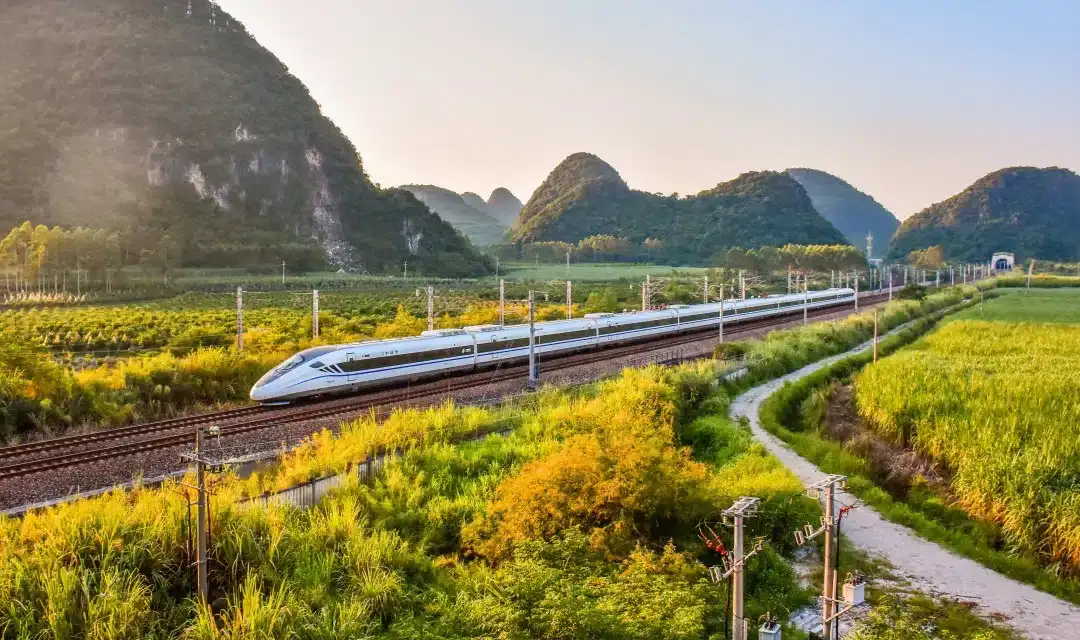
Most Popular China Train Tours
Below are our best-selling train tours, covering China’s popular tourist destinations like Beijing , Xian , Shanghai , Guilin , Chengdu , Mt. Huangshan , and culture-rich destinations like Pingyao , Silk Road , Lhasa , etc. These are all sample tours for your inspiration, and our travel consultants are always happy to help you customize your own China train tours according to your specific likes, budgets, and requirements.
6 Days Beijing – Xian – Shanghai Private Tour by Bullet Train
11 days essence silk road tour from xian to urumqi, 9 days china cultural tour of beijing-datong-pingyao-xi’an, 6 days china tour of beijing and huangshan by high-speed train, 10 days chengdu – xi’an – xining – lhasa private tour, 13 days beijing-xian-chengdu-yangtze river-shanghai tour, 9 days shanghai-suzhou-hangzhou-huangshan tour, 13 days beijing – xian – hangzhou – huangshan – shanghai tour, china high-speed train tours with stunning culture & scenery.
These are the China train tours to culture-rich destinations, which will reward you with a unique cultural experience and beautiful scenery on the way. Feel free to contact our travel consultants if you have your own ideas for the trip.
8 Days Silk Road Bullet Train Tour
13 days silk road adventure tour from xining to kashgar, 6 days shenzhen- guilin tour by high-speed train, 10 days historic china tour of xi’an-pingyao-datong-beijing, 13 days guangzhou-shenzhen-guilin-chengdu-xian-beijing tour, 6 days shanghai-suzhou-xian group tour, 6 days classic xining and lhasa tour by train, 4 days xian-lanzhou-xiahe tour by train, no suitable tour need advice, recommended china tours & related articles, 7 days china private tour of shanghai-hangzhou-huangshan, 12 days essential silk road group tour from xi’an to urumqi, 5 days beijing & xian classic tour, 4 days xian – shanghai tour by high-speed train, 5 days short silk road tour from dunhuang to urumqi, 11 days marco polo tour from beijing to urumqi, 13 days silk road small group tour beijing, xian, dunhuang, turpan, urumqi, shanghai, 7 days beijing xian shanghai group tour by overnight train, 5 days guangzhou-guilin highlights tour, 17 days itinerary of silk road exploration with zhangjiajie, how to choose a train type & seat class in china, destinations, popular tours, travel blog.
Top 15 Things to Do in China 2024/2025 11/10/2022 07:53
Chinese Zodiac 04/14/2022 09:29
Why Visit Dunhuang and Top Things to Do in Dunhuang 03/29/2022 09:33
We are member of:
Email: [email protected] [email protected] WeChat/Whatsapp: 86-15129005119 Call: (+86)18792910029 (08:00-21:00 Beijing Time)
2002-2022 © All Rights Reserved.
Username or email *
Send us a quick inquiry
* Tell us your travel requirements/questions here.
I prefer to be contacted via:
Email WeChat WhatsApp Phone call
Your travel consultant will reply within 24 hours.
A TripAdvisor award-winning China travel agency organizing diverse private and mini-group China tours. We offer in-depth experience, free cancellation, flexible & safe trips.
[email protected] [email protected]
WeChat/Whatsapp
86-15129005119
(+86)18792910029 (08:00-21:00 Beijing Time)
- China Train
- Waiting open

- Train Travel Tips
- Booking Policy
- How to Buy Train Tickets
- How to Collect Train Tickets
- How to Get On/Off a Train
- Taking an Overnight Train
- Top Train Travel Phrases
- Lost Ticket
- Baggage Allowance
- Taking Bike on Train
Popular Cities

China Train Travel: A How-To Guide
T rain travel in China is best summed up in three words: comfy, convenient, and at times, confusing . At least, that's compared to the country's budget airlines and buses, both of which offer a rickety, hair-rising adventure in itself. If you're happy to fork out a little extra cash and get the China train experience, here's some tips to make the process a little bit smoother!
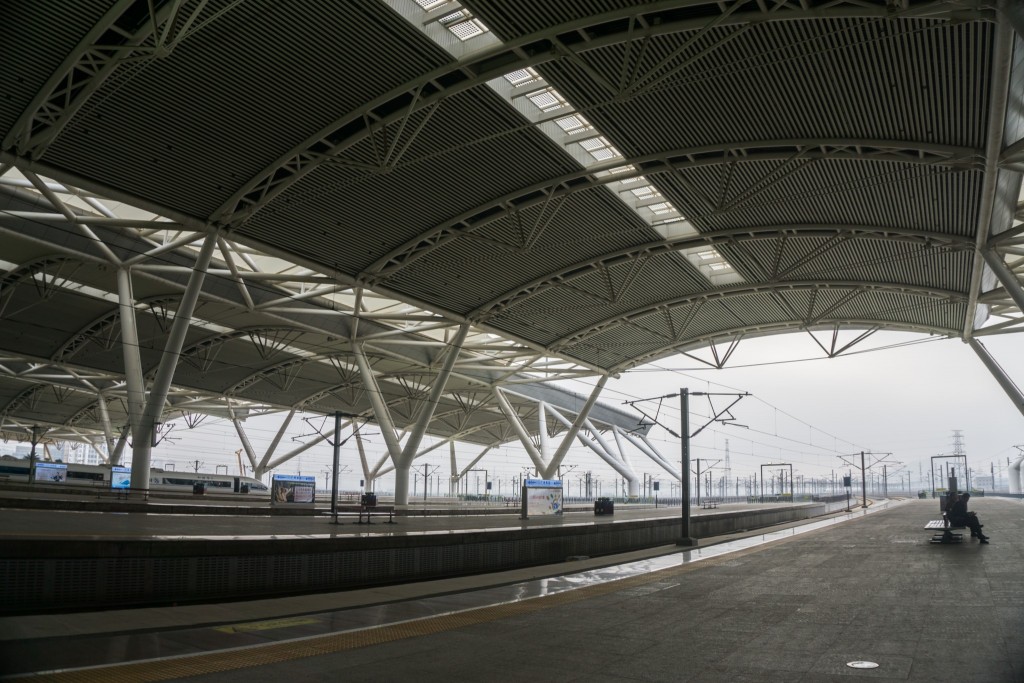
Train Types
There are a few classes of trains in China, each ranging in seat type, services offered, speed, and overall cleanliness. Here's a quick run-down of your options:
High-speed Rail
- Modern & clean
- Cover large distances
- Are fast (up to 300km/hr!)
- Non-smoking in entire train (enforced)
- Assigned seating (enforced)
“Regular” trains
- Cheaper than high-speed (often the older version of current high-speed trains)
- Fairly clean
- Non-smoking except between cars
Overnight/ Sleeper Trains
- Provides a “free” night of accommodation
- Fairly comfortable & affordable
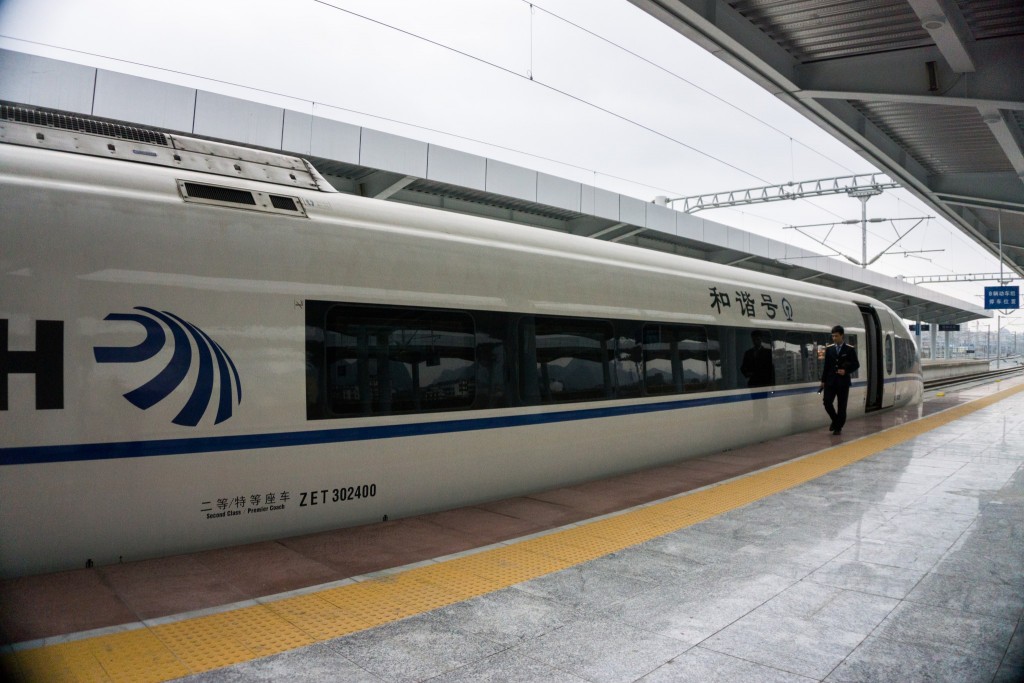
China is well serviced by trains, with connections between major cities and even remote locations including Mongolia. Simply search your Point A to B via sites like C-Trip (more on that below), and you'll very likely find a number of trains servicing that route.
How to Buy China Train Tickets
C-Trip is another user-friendly option that we mostly used throughout our travels in China. The website's English is decent, it has competitive pricing, plus a rewards program that earned us ~$40 USD back which we used on accommodation. Tickets can be bought with credit or Paypal, then pick up at the train station ticket office
You can buy tickets at the train station ticket counters. Take note, the self-service “English” machines won't accept non-Chinese cards, and often aren't fully English anyway, so just approach any of the ticket counters. It's helpful to have the name of your destination in Chinese in case of potential language barriers. As always in China, bring your passport .
You could also buy train tickets from a travel agency (they are abundant in China), simply ask your hotel or Tourist Information Centre.
Train Classes
Once you look to buy tickets, you'll notice there's several classes to choose from, indicated by letters. Here's what those letters mean:
- C, D & G trains : China's best high-speed trains. They're modern, air-conditioned, and most run at 200-300km/hr. Most overnight D-trains are older versions of the high-speed train.
- Z trains : now second best, these were previously China's greatest quality high-speed sleeper trains. Fairly modern with air conditioning.
- T trains : these are the next best after Z trains. Much older models but still functional.
- K trains : these aren't as quick as high-speed trains but are still “fast”, and as such are higher-priced.
Overnight Sleeper Train Types: A Comparison
Upon booking an overnight train, you'll notice there are several seat options. Here's a quick breakdown of what each entails.
Hard Sleeper
- Cheapest ticket type (and despite the name, isn't actually hard)
- Has thinner sleeping mattresses than the “soft” ones
- Shared compartment/room without doors
- 6 bunks per compartment
Soft Sleeper
- Cheaper ticket type
- Thicker sleeping mattresses
- Shared compartment/room without doors
- 4 bunks per compartment
Private Rooms
- Priciest ticket type
- 2 bunk compartment
- Some have a private toilet (which sells out FAST)
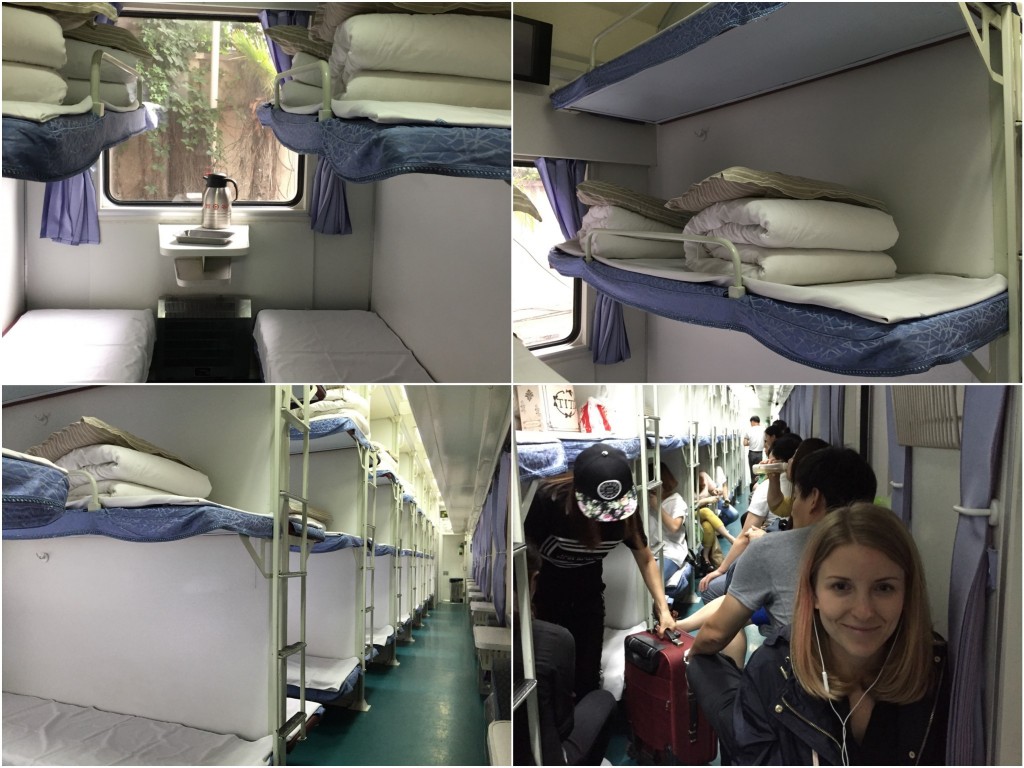
We've taken all of China's train types – overnight, regular, and high-speed. We were pleasantly surprised by the overnight train experience in the “hard” sleeper class (see above photo). It was quieter and cleaner than expected, and felt like sleeping in a hostel dorm. Some points worth noting:
- There are no seats (besides your bed), except for 2 tiny hard seats per aisle for the 6 bunks (see photo at end of article). If you're lucky enough to have the bottom bunk (which is the only one tall enough to sit upright in), it also has its own mini table.
- There isn't anywhere to lock your belongings but there is a shelf where everyone puts their bags. Theft seems to not be a concern, but we did sleep with our valuables (phone etc) in our beds to be safe.
- There are no doors to the compartments, but there are curtains on the windows.
- Lights are turned off automatically at 10PM & people generally are quiet after this time
- The bottom bunk has the most space (you can actually sit up in it), whereas the top two above it you cannot sit upright
China's trains mostly have squat toilets, but are fairly clean with a washing station outside the bathroom. Be sure to bring toilet paper & soap or sanitizer (as you should everywhere in China!).
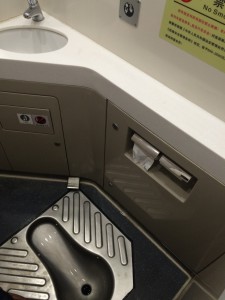
Some overnight trains have a restaurant car, it depends on the class. Snack carts regularly go by with overpriced food, snacks and bottled drinks. No coffee though except instant on high-speed trains, at a hefty 40 RMB/cup (~$6 USD!).
Nearly all Chinese trains have free water dispensers that dispense hot water only . So if instant coffee, tea, or instant noodles are your thing, bring 'em along!
Note : free bottles of mineral water are offered at train stations for certain train classes. Simply show your ticket and see if you’re eligible (or if you speak Chinese, just ask!).
Reading Your Train Ticket
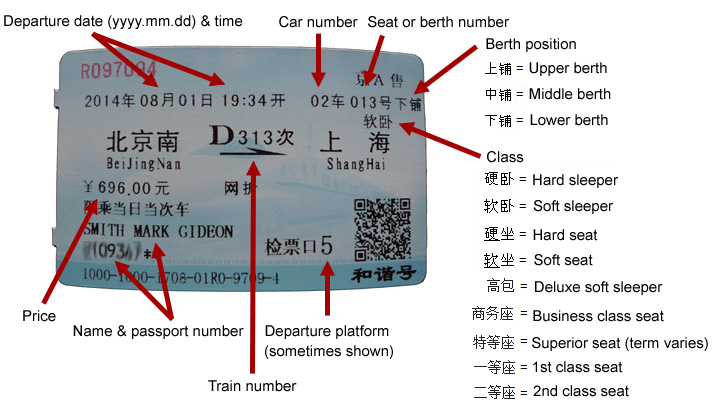
Seat61 has made this great translation picture to help you decipher your ticket. That being said, even without this you'll still be able to ask staff to help you figure your seat and platform out.
Avoiding Headaches & Mishaps
- Give lots of buffer time for train ticket pick-up/boarding – Chinese train stations are HUGE .
- Always bring your passport.
- Check ticket availability online in advance to avoid disappointment. Tickets can sell out in high season (July/Aug).
- All train stations in China involve a security check . Yep, even public subway stations, too. Give yourself LOTS of buffer time to put your bags through x-ray machines, possibly be patted down and maybe have your bags pried through – much like airport security. If you're carrying bottled drinks, you'll be asked to drink them to prove they don't contain harmful contents.
- Eat before boarding & pack snacks. Food is quite inflated on Chinese trains, so it pays to pack food if you can. Convenience/grocery stores have pre-made sandwiches, noodle boxes, or salads. Most train stations have noodle restaurants inside if you want to eat pre-boarding.
- Pack headphones and/or ear plugs . You'll likely need it to block out the movies people watch without headphones and general noisy conversation (though our overnight experience was surprisingly tranquil).
- Bring layers of clothing . You never know if a train will be overly air-conditioned or stiflingly hot. I always wear loose layers for long rides, with easy options to add on if I’m too cold.
And there you have it, (just about) everything you need to know for train travel in China. Having done China's long-distance buses and budget airlines, I'd definitely say train travel is our preference. If you've got a long trip, have the extra pocket cash, or are low on travel sanity, the trains are absolutely worth it.
Questions, comments or info to add? Don't be shy, ask away!
Leave a Reply Cancel reply
Your email address will not be published. Required fields are marked *
Jetpack has locked your site's login page.
Your IP address 149.40.61.226 has been flagged for potential security violations. You can unlock your login by sending yourself a special link via email. Learn More

Why Travel by Train in China?
Fast & affordable.
China high speed train runs from 200km/hr to 350km/hr at reasonable price. It takes only 4.5 hours by the fastest train from Beijing to Shanghai for the 1318 km journey.
Punctuate and Reliable
Chinese trains are punctuate. They are less affected by weather and environment comparing to internal flights and buses.
Safe & Comfortable
Chinese trains are a safe, comfortable way to travel around China. Each train has its own police. People are traveling under real-name policy.
Cheap Price and Hassle-free Service
We offer the hassle-free service to book china train ticket online. you can search the time table and ticket availability at our website and book online. we accept visa, mastercard and paypal. the e-ticket will be sent to you by email and then you can redeem at railway station's counter., search train.
search time table and ticket availability online
we accept VISA, MasterCard, AMEX and PayPal
Receive E-ticket
Receive E-ticket by email and check in with passport
How to book China Train Ticket Online?
Frequently asked questions.
Yes, of course you can. We accept booking request from all over the world. Thanks to the internet technology, our customers grows rapidly.
We accept online booking at least 24 hours in advance. The trains in China mainland open for sale 15 days before the earliest. You are advised to pre-book the tickets as early as you can and we will proceed to purchase the tickets as soon as the trains open for sale.
The e-ticket is booked under your full name and passport number. You need to provide your name in full which exactly identical to your passport.
The valid names accepted by the ticketing system is Last Name + First Name + Middle Name as appeared in the MRZ (machine reading zone) at the bottom of your passport identity page.
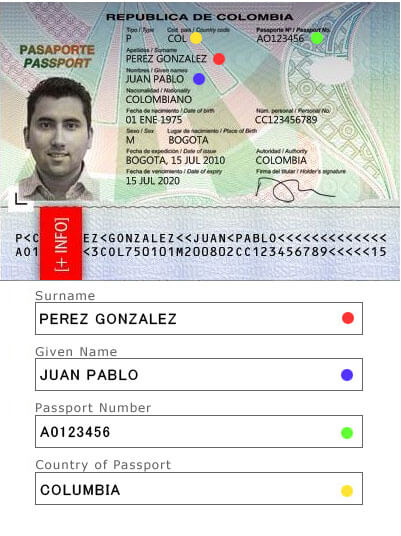
We accept VISA, MasterCard, AMEX and PayPal online. For customers who do not have credit card or PayPal. we accept bank transfer upon your request.
Once your tickets are issued, the e-tickets will be sent to you by email. You can use your passport to check in at the railway station without any paper ticket. China Railway does not provide paper tickets anymore.
Not really. Once we have received your payment, we will proceed to do real-name verification and purchase the tickets as soon as the train opens for sale. In case the tickets are not available, we will inform you by email and you can change to another train or cancel and get a refund. Based on our statistics, approximately 95% of paid booking have been able to get the tickets successfully.
Besides the ticket fare, we charge the service fee and transaction fee. The service fee varies depending on different ticket price. You can see the fee during the booking process.
The e-ticket will be sent by email and no shipment required.
No, sorry. Tickets are not reserved before payment.
China Railway has adopted the e-ticketing system and do not provide paper tickets at all.
Please request cancellation online at our My Bookings or contact us by email. For urgent cancellation, please call us. Please read Terms and Conditions before initiating a cancellation request.
15 days before the earliest. Sometimes it is 3 to 5 days before in the event of railway timetable adjustment.
The seats are assigned by computer and no human intervene is allowed. Generally the seats are next to each other, but they might be separated if there are not many seats left.
From January 1, 2023, For children boarding with adults, child discount tickets shall be booked for those over 6 years old and under 14 years old; full-price tickets shall be booked for those over 14 years old. Each adult passenger with a paid ticket, may board together with a child under the age of 6 bearing a free child ticket with no reserved seat. Only one child may board with a free child ticket together with each adult passenger, other children shall board with a discount child ticket.
We can try for you but it is not 100% guaranteed as the seats are assigned by computer and based on seat availability.
Popular Train Tickets
- Beijing to Shanghai
- Beijing to Xian
- Beijing to Pingyao
- Beijing to Datong
- Beijing to Qingdao
- Beijing to Jinan
- Xian to Zhangjiajie
- Changsha to Guilin
- Changsha to Zhangjiajie
- Shanghai to Beijing
- Shanghai to Hangzhou
- Shanghai to Nanjing
- Shanghai to Hefei
- Shanghai to Yiwu
- Shanghai to Huangshan
- Xian to Beijing
- Xian to Shanghai
- Xian to Pingyao
- Xian to Chengdu
- Xian to Luoyang
- Xian to Huashan
- Hong Kong to Guangzhou S.
- Hong Kong to Humen
- Hong Kong to Chaoshan
- Hong Kong to Xiamen
- Hong Kong to Shenzhen
- Guangzhou S to Hong Kong
- Guangzhou to Guilin
- Guangzhou to Shenzhen
- Guangzhou to Shanghai
Trains & tickets
- Train types
- Child ticket
- Real-name policy
Useful to know
- Baggage limit
- How to read a train ticket?
- Cancel train ticket at railway station
- Terms & conditions

- Car Rentals
- Airport Transfers
- Attractions & Tours
- Bundle & Save
- Destinations
- Trip.com Rewards
Plan Your Travel with China Railway Lines: China Train Map, China Bullet Train Map

April 18, 2024
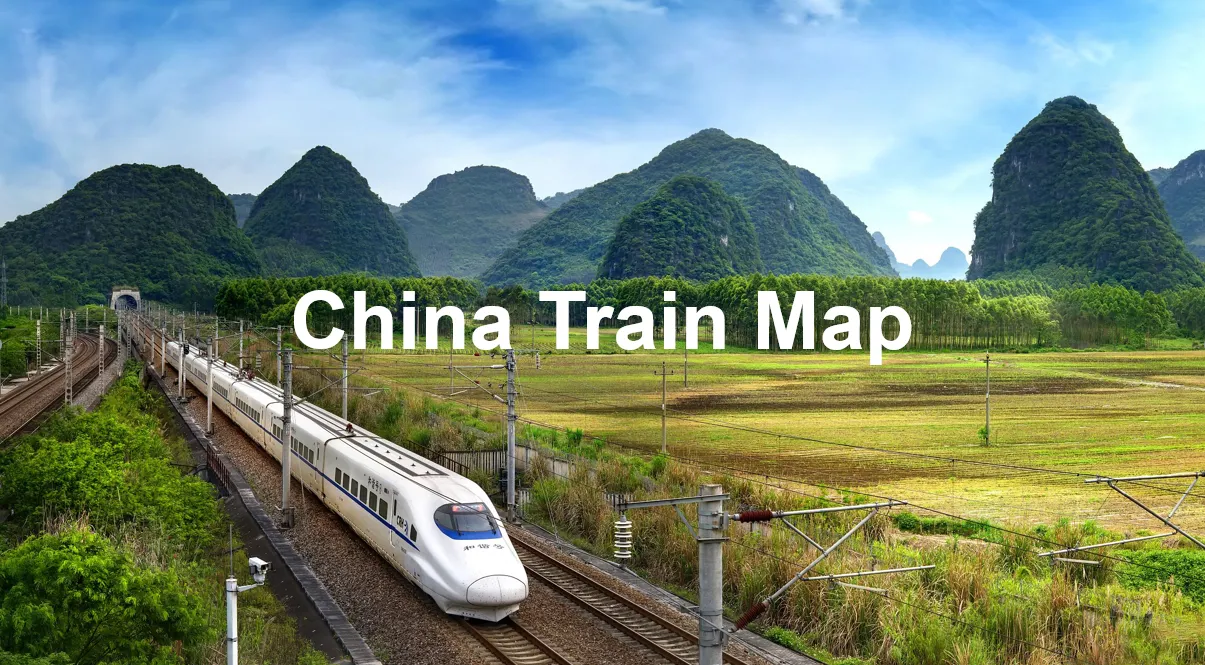
About China Train Map
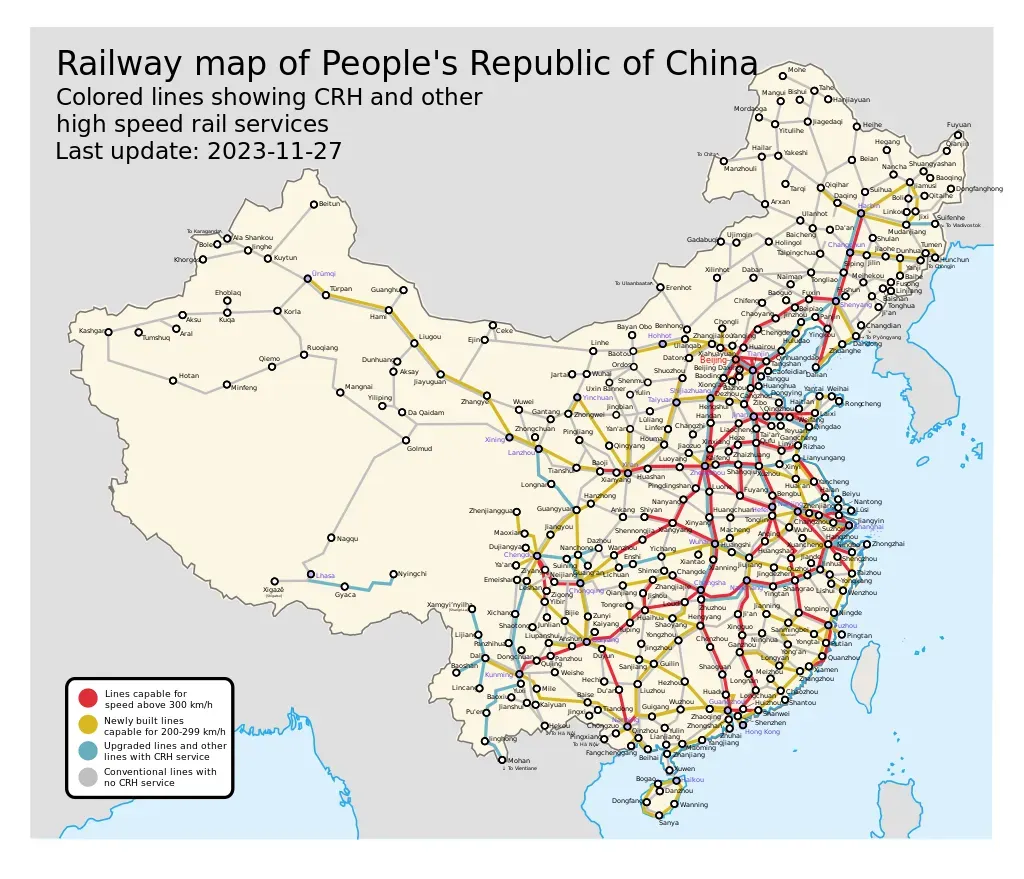
Source: Wikipedia
China railway network is extremely extensive and reaches all parts of the country, including remote and mountainous regions. As of 2020, the total operational length of China's railway network is approximately 146,300 kilometers , making it the second-longest railway network in the world, surpassed only by the United States.
China has also developed one of the world's most extensive high-speed rail (HSR) networks. As of 2020, the total length of China's high-speed railway lines is about 37,900 kilometers , accounting for about two-thirds of the world's total high-speed rail tracks. The high-speed rail system has significantly reduced travel times between major cities in China, with trains reaching speeds of up to 350 kilometers per hour.
Moreover, China aims to increase the total length of the high-speed railway to 70,000 kilometers by 2035, covering more than 90% of the population.
Visitors can check the above China train map for more accurate information.
Top China High Speed Train Routes
Popular china railway routes: china train map.
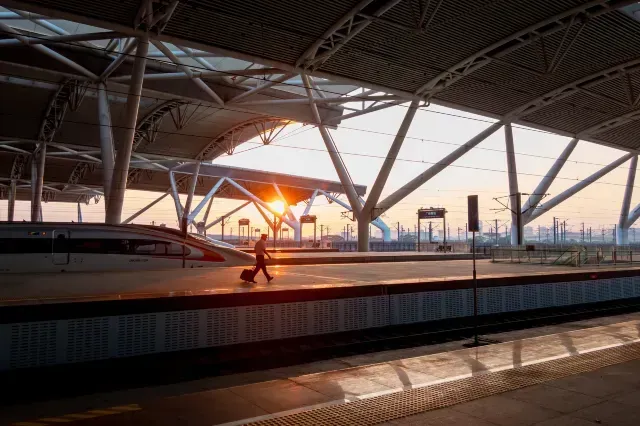
China boasts one of the most extensive and advanced railway networks in the world, with high-speed trains (known as Gāotiě) connecting major cities across the vast country. Here are some of the most popular China railway routes, destinations, and related China train maps:
1. Beijing-Shanghai High-Speed Railway(京沪高速铁路)
Connecting the capital city of Beijing with Shanghai, China's largest city, this high-speed rail line is one of the most frequented routes in the country. The journey covers a distance of about 1,433 kilometers and can be completed in as little as 4.5 hours, reaching speeds of up to 350 km/h. Along the way, passengers can stop at major cities such as Tianjin, Jinan, and Nanjing.
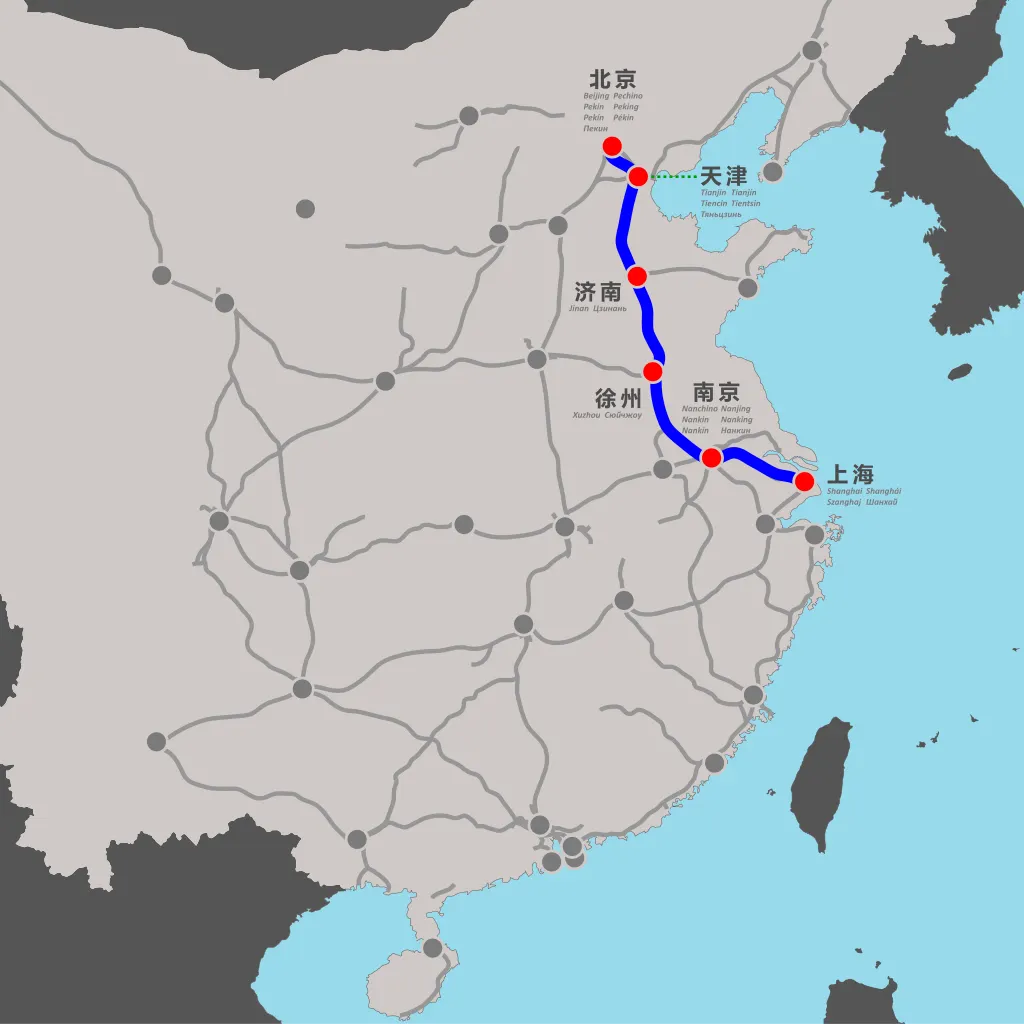
Source: from Wikipedia
2. Beijing-Guangzhou High-Speed Railway(京广高速铁路)
Spanning over 2,230 kilometers, this route links the northern capital of Beijing with the southern city of Guangzhou. It is one of the longest high-speed rail lines in the world and passes through several important cities, including Shijiazhuang, Wuhan, and Changsha. The journey can take around 8 hours, which is a significant reduction from the 20+ hours it would take by conventional train.
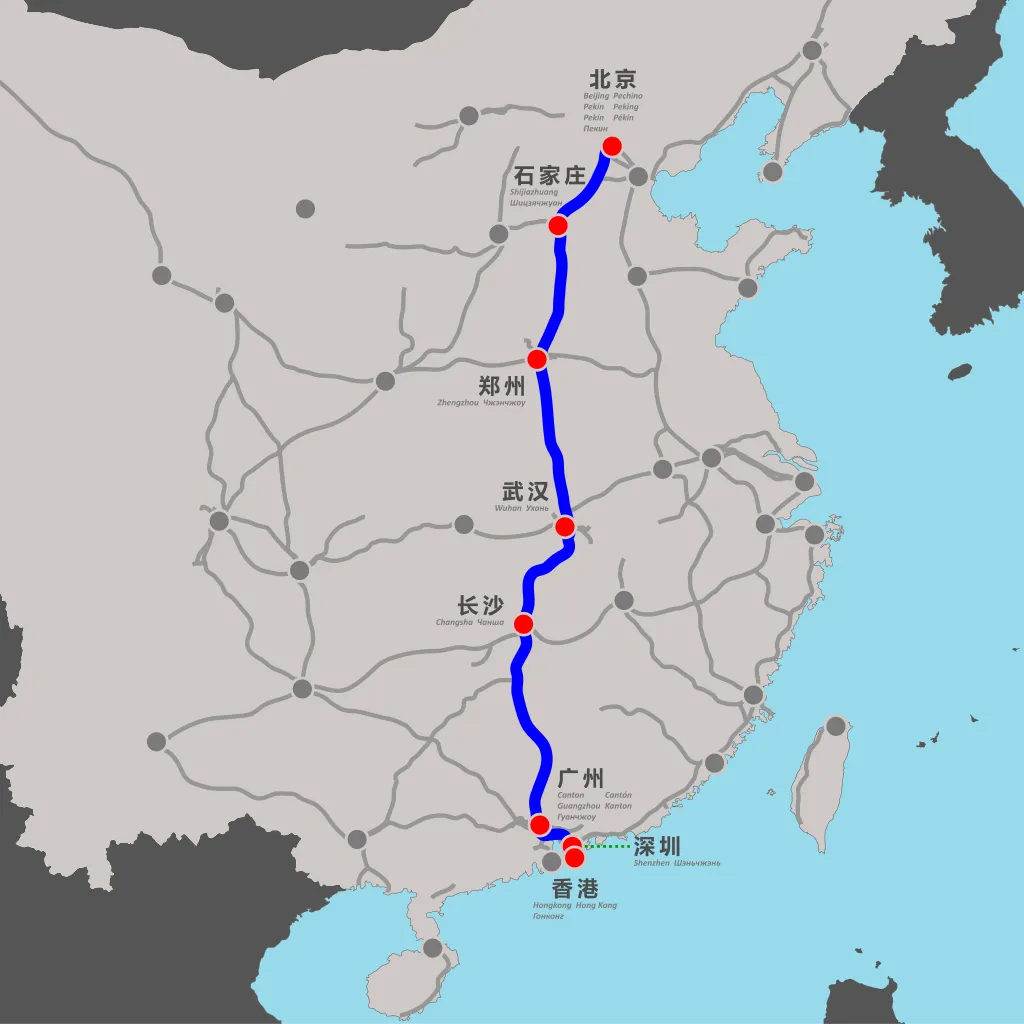
3. Shanghai-Kunming High-Speed Railway(沪昆高速铁路)
This route connects Shanghai on the east coast with Kunming in the southwest, traversing a distance of over 2,258 kilometers. The line passes through several provinces and offers access to scenic destinations such as Hangzhou, Nanchang, Changsha, Guiyang, and the beautiful landscapes of Yunnan province. The entire trip takes approximately 11 hours.
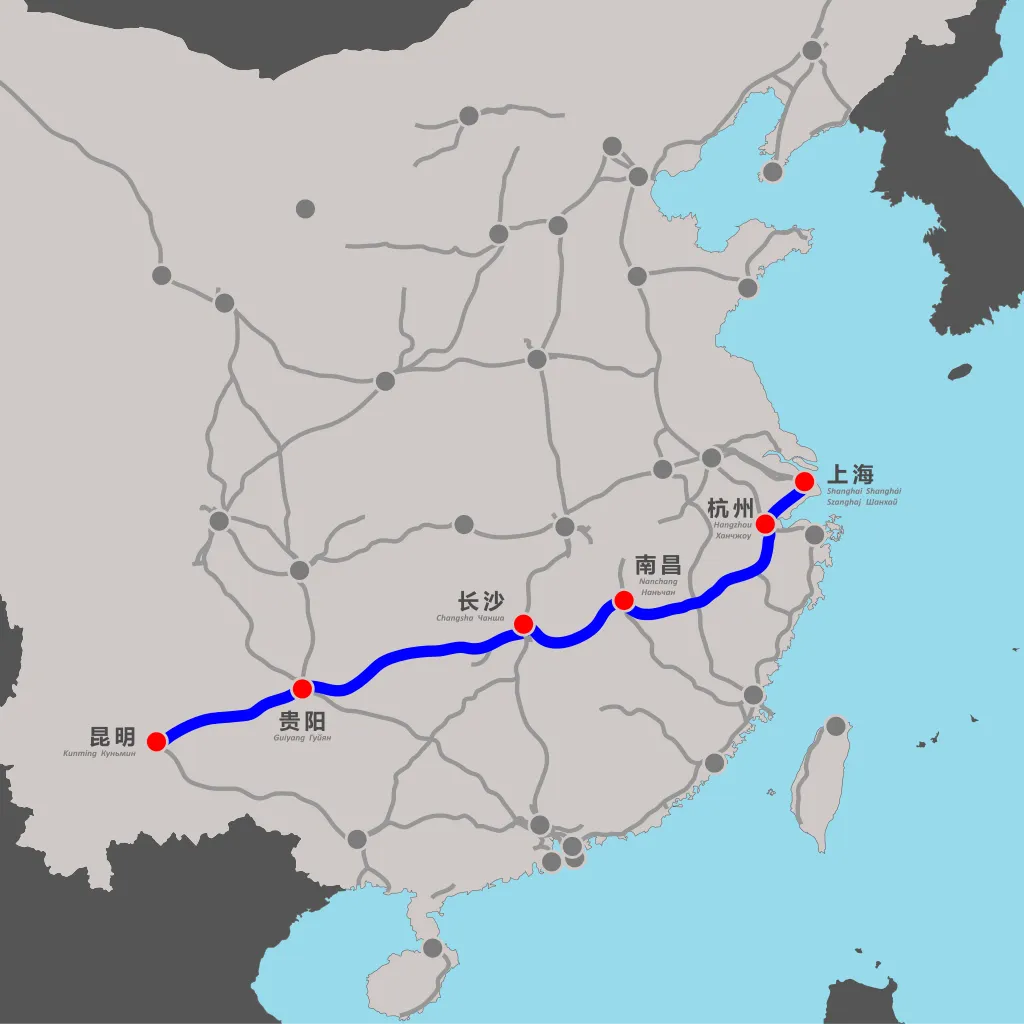
4. Beijing-Harbin High-Speed Railway(京哈高速铁路)
Linking Beijing with Harbin, the capital of Heilongjiang province in northeastern China, this high-speed rail line extends for about 1,700 kilometers. Known for its ice festivals, Harbin is a popular winter destination. The train passes through cities like Chengde, famous for its summer resort and imperial gardens, and Shenyang, an important industrial center.
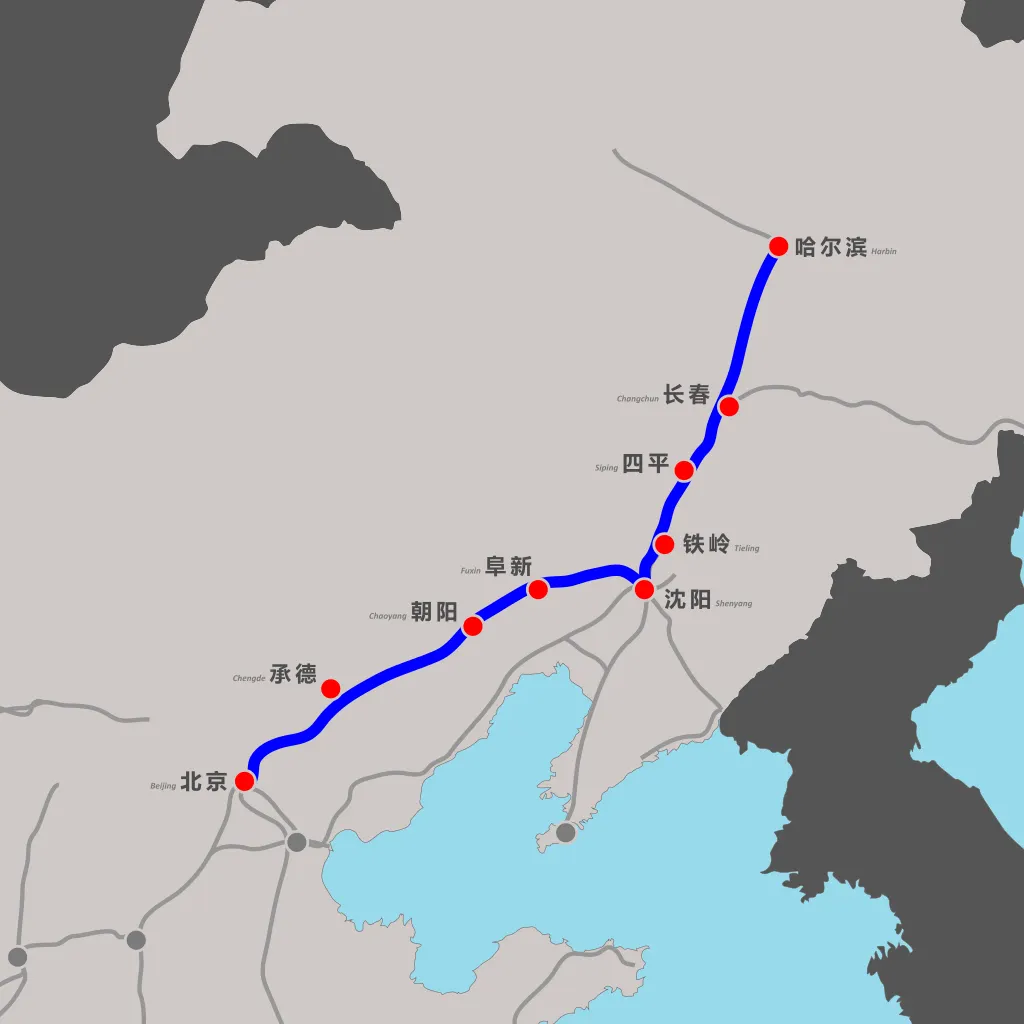
5. Guangzhou-Shenzhen-Hong Kong Express Rail Link(广深港高速铁路)
This relatively short but very important route connects the major cities of Guangzhou and Shenzhen with Hong Kong, facilitating easy cross-border travel. The entire journey from Guangzhou to Hong Kong can be completed in under an hour. This line provides a crucial link for business and tourism between mainland China and Hong Kong.
6. Chengdu-Chongqing High-Speed Railway(成渝高速铁路)
This route serves the economic corridor between Chengdu, the capital of Sichuan province, and Chongqing, a major city in Southwest China. The journey covers around 307 kilometers and can be completed in just over an hour, making it an excellent option for business travelers and tourists exploring the region's spicy cuisine and stunning landscapes.
7. Xi'an-Chengdu High-Speed Railway(西成高速铁路)
This line connects Xi'an, home to the famous Terracotta Army, with Chengdu, known for its panda sanctuaries and Sichuan cuisine. The journey covers about 510 kilometers and takes approximately 3 to 4 hours, passing through the Qinling Mountains, which offer a picturesque backdrop for travelers.
8. Hangzhou-Huangshan High-Speed Railway(杭黄高速铁路)
For those interested in natural beauty and ancient villages, the Hangzhou-Huangshan route is a must. It connects the city of Hangzhou, renowned for its historic West Lake, with Huangshan, where the Yellow Mountains (Huangshan) are located. The trip takes about 3 hours and provides access to some of China's most breathtaking landscapes and UNESCO World Heritage Sites.

China Train Lines

Conventional China Train Lines
China high speed train lines.
- Beijing–Shanghai High-Speed Railway (Jinghu High-Speed Railway)
- Beijing–Guangzhou High-Speed Railway (Jingguang High-Speed Railway)
- Shanghai–Kunming High-Speed Railway (Hukun High-Speed Railway)
- Hangzhou–Fuzhou–Shenzhen High-Speed Railway
- Harbin–Dalian High-Speed Railway
- Beijing–Harbin High-Speed Railway (Jingha High-Speed Railway)
- Beijing–Hong Kong (Taipei) High-Speed Railway
- Hefei–Fuzhou High-Speed Railway
- Xiamen–Shenzhen High-Speed Railway
- Guiyang–Guangzhou High-Speed Railway
- Zhengzhou–Xi'an High-Speed Railway
- Xi'an–Chengdu High-Speed Railway
- Nanjing–Hangzhou High-Speed Railway
- Shanghai–Nanjing High-Speed Railway
- Tianjin–Qinhuangdao High-Speed Railway
- Shijiazhuang–Jinan High-Speed Railway
- Changsha–Kunming High-Speed Railway
- Lanzhou–Xinjiang High-Speed Railway
International China Railway Lines
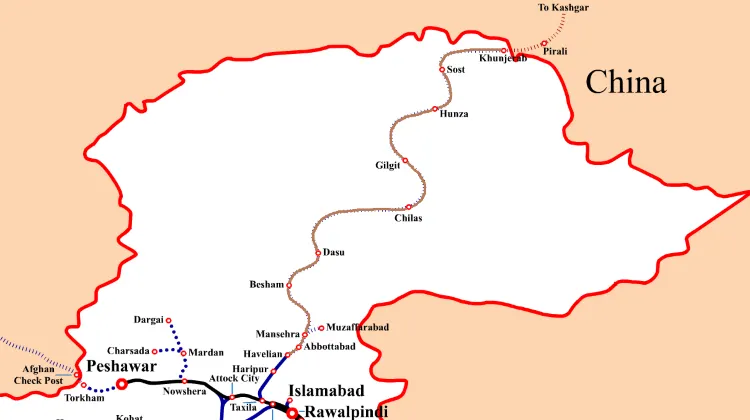
Source: from Wikipedia/China–Pakistan railway map
- China–Nepal railway
- China–Pakistan railway
- China–Laos railway
- China–North Korea railway
- Yiwu–London railway line
- Chongqing–Xinjiang–Europe Railway
- Yiwu–Madrid railway line
- Trans–Mongolian Railway
Plan your China Railway Travel with Trip.com Now!
Faqs about china train map, can i purchase china train tickets online, how can i use the china train map to plan my trip, does the china train map include high-speed rail lines, are all train stations shown on the china train map.
China Train Map Guide
- 1. About China Train Map
- 2. Top China High Speed Train Routes
- 3. Popular China Railway Routes: China Train Map
- 4. China Train Lines
- 5. Plan your China Railway Travel with Trip.com Now!
- Customer Support
- Service Guarantee
- More Service Info
- Website Feedback
- About Trip.com
- Terms & Conditions
- Privacy Statement
- About Trip.com Group
Other Services
- Investor Relations
- Affiliate Program
- List My Property
- Become a Supplier

China’s Punishment for People With Bad Debts: No Fast Trains or Nice Hotels
F OSHAN, China—Qin Huangsheng once imagined a better life in the city when she left her home village to become a factory worker at age 16.
Now, in her early 40s, she has $40,000 in personal debt and a base salary of $400 a month. Debt collectors are hounding her. She is blocked from buying tickets on China’s high-speed rail, just one of the penalties the government is increasingly imposing on people who don’t pay their bills.
On the aging slow trains she is left to ride, Qin sometimes looks at the other passengers and thinks: “I wonder if they’re all bad debtors like me.”
People across China are being weighed down by their debts and a system that penalizes them for not paying the money back. Beijing is cracking down on delinquent debtors by seizing their salaries or restricting them from getting government jobs, as well as curbing their access to high-speed trains and air travel. Many are forbidden from buying expensive insurance policies and told they aren’t allowed to go on vacation or stay in nice hotels. Authorities can detain them if they don’t comply.
The number of people on a publicly available government delinquency blacklist has jumped by nearly 50% since late 2019 to 8.3 million today. Courts can put people on the blacklist when they don’t fulfill judgments against them to pay money back or are deemed to be not cooperating with legal proceedings.
Unlike in the U.S., China doesn’t allow most people—including those who had a run of bad luck—to declare bankruptcy to write off bad debts and move on with their lives, a policy some Chinese scholars are criticizing as unfair.
Household debt has surged by 50% in the past five years to around $11 trillion today. While that is lower than the $17.5 trillion Americans owe, it is a huge sum in a country where people earn far less.
With home prices falling, deflation risks becoming entrenched and unemployment a persistent challenge, Chinese leaders are eager to get people spending more. But each additional dollar going to pay for debt is taking away one that could be used to splurge on new clothes or pay for a vacation. The threat of punishment for falling behind on debt is making many families more conservative with their money.
Retail sales of consumer goods in China rose 4.7% on year in the first quarter, the government said Tuesday, lagging behind total economic growth of 5.3%. As many in China curtail spending, the government is giving priority to turbocharging manufacturing and exports, a strategy that is exacerbating trade tensions with the West.
With so many Chinese consumers under financial pressure, Western companies including Apple, Estée Lauder and General Motors have reported weaker sales in China.
Chinese officials didn’t respond to questions about the blacklisting system. The government has said previously it only seeks to target those who have the ability to repay their debts but refuse to do so.
Behind China’s personal-debt surge
China’s long housing boom was a significant cause of the rise in personal debts, because many people had to borrow more to afford homes. Some buyers took on extra debt to buy more properties for investment purposes, sometimes letting them sit empty. Now that the boom is over and prices are falling, many are stuck with debts they can’t handle.
The number of foreclosed homes listed for sale rose 43% in 2023 to roughly 400,000 properties, according to real-estate research firm China Index Academy.
The increase in personal debts is also partly a result of more people using credit cards or tapping personal credit lines to handle expenses as the economy stagnates.
Many economists say a U.S.-style financial crisis is unlikely in China soon. State control of the banking system means the government can absorb losses and inject capital in an emergency. Household debts have also largely plateaued over the past two years, as many people give priority to using extra cash to pay down liabilities rather than shopping or investing in stocks.
Still, the prevalence of large personal debts is a problem for China’s leadership.
“Household debt booms tend to lead to bad macroeconomic outcomes, even in the absence of a financial crisis,” said Amir Sufi, a University of Chicago economist. China has no simple fix. “Once the cycle starts, it’s usually one in which it’s painful, long and difficult to predict when it will end,” Sufi said.
A tough system for borrowers
China has tried for years to lift personal spending to ease its economy’s traditional reliance on infrastructure and real-estate growth. Its banks issued tens of millions of new credit cards each year, with outstanding balances jumping 50% between 2018 and 2023 to well over $1 trillion. Private technology apps such as Alipay and WeChat also started helping consumers secure loans as their digital payment systems soared in popularity.
But when debts go unpaid, a person’s income can be seized by the state to cover their liabilities, leaving debtors with a small allowance to scrape by.
A 38-year-old man petitioned courts in the southern city of Guangzhou to raise his monthly allowance to 12,000 yuan, equivalent to around $1,600, from 9,500 yuan to help pay for a newborn child. Judges denied his request late last year, and instead concluded that his allowance should be cut by nearly 40% because he was already getting too much, court records show.
A black market has emerged to serve people on the blacklist. In one case, Shanghai authorities busted a ring of scalpers who were booking high-speed rail tickets on behalf of debtors who were barred from doing so themselves. In early 2021, authorities tracked down a debtor who had been using the service and took him into custody, according to a local court.
The current system gives priority to protecting creditors—often powerful, state-owned institutions—at the expense of helping struggling individuals. Scholars who study the issue say China urgently needs a nationwide personal-bankruptcy system to achieve leader Xi Jinping’s goal of making the country more equitable, by forcing creditors and debtors to share the costs of soured loans.
“A personal-bankruptcy system is a mechanism for the redistribution of wealth,” Li Shuguang, a scholar who has advised the government on bankruptcy policy, wrote in a Chinese magazine commentary online last summer.
Movement on the issue has been stymied in part by opponents who believe such a system would only encourage more people to shirk their debts.
One woman’s saga
For Qin, the former factory worker, easy access to credit backfired badly.
As a 16-year-old in 1999, Qin boarded an overnight bus from her home in rural southern China to the grimy manufacturing hub of Dongguan, north of Hong Kong.
Her parents, who are farmers, couldn’t afford a payment of less than $15 needed for her to take a high-school entrance exam. She vowed to make it on her own, and found work in factories producing slippers and golden jewelry.
A few years later, Qin secured her first credit card. With it, she bought a computer to teach herself to type so she could land a better job.
When the bill was paid, Qin said she tried to cancel the card. “Keep it for an emergency,” the bank clerk told her.
Qin’s career flourished and she eventually moved to the metropolis of Guangzhou. By 2010, she said, she was managing bidding for a company that supplied fire-safety equipment to real-estate projects. Her nest egg steadily grew from the lucrative commissions she earned in the property boom.
When the property sector slowed, she jumped industries. An acquaintance had been involved in a startup that was developing software to help small-business owners collect WeChat data to generate more foot traffic and aid marketing efforts.
Qin said she invested the equivalent of around $150,000 of her savings into the venture.
The startup burned through her initial investment as it tried to get the software up and running. Qin said she then agreed to start putting some of its expenses, including office supplies, rent and employee salaries, on her credit cards, and to tap personal credit lines she had obtained via WeChat and Alipay.
A roadshow by the company was warmly received, she said. But its prospects dimmed after the Covid pandemic hit.
The company’s struggles left Qin with the equivalent of tens of thousands of dollars of debt. Phone calls from debt collectors have become a daily occurrence.
With no option of bankruptcy, Qin concluded that a new job was her only way out of trouble.
“As long as I’m still living and have a life, I can work hard to earn the money back,” she said.
That path has faced unexpected difficulties. In 2021, while preparing for a business trip to Shanghai, more than 700 miles northeast of Guangzhou, Qin realized that she had lost her access to high-speed rail, where a government I.D. is required to buy a ticket. She took the slow train—and later quit that job in part because the travel restrictions were making it impossible.
Local officials didn’t respond to questions about Qin’s case and The Wall Street Journal wasn’t able to verify some details of her account.
Today, Qin is working in a shop in Foshan, south of Guangzhou, selling traditional Chinese medicines. With a base salary of about $400 a month, she has found it tough to put a dent in her debts, but said she has managed to pay back two of her credit cards so far, with about $40,000 still to go.
Qin is trying to stay optimistic, hoping that medicine will be in high demand as China’s population ages, opening the door to bonuses and potentially even running her own shop. Still, she has had to get creative to earn the cash to pay her debts.
Her current role requires Qin to collect payments from customers using a digital wallet on WeChat. But she said that function on her account has been frozen several times since 2022, leaving Qin to seek help from her family.
She decided not to tell her parents about the full scale of her troubles, however.
If they knew the truth, Qin said, they “wouldn’t be able to sleep.”
Grace Zhu and Zhao Yueling contributed to this article.
Write to Brian Spegele at [email protected]
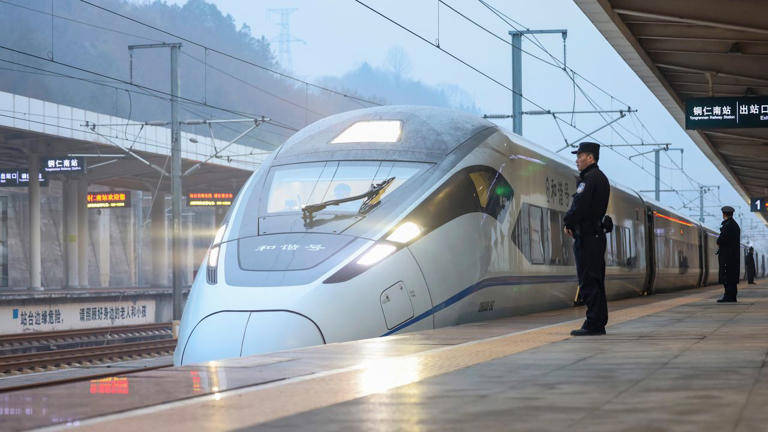
- Travel Updates
China brutally mocked over new train station design
The design of a proposed train station in China has gone global for all the wrong reasons.

‘Snapped in half’: Man’s horror flight

Uber bans Sydney mum over first name
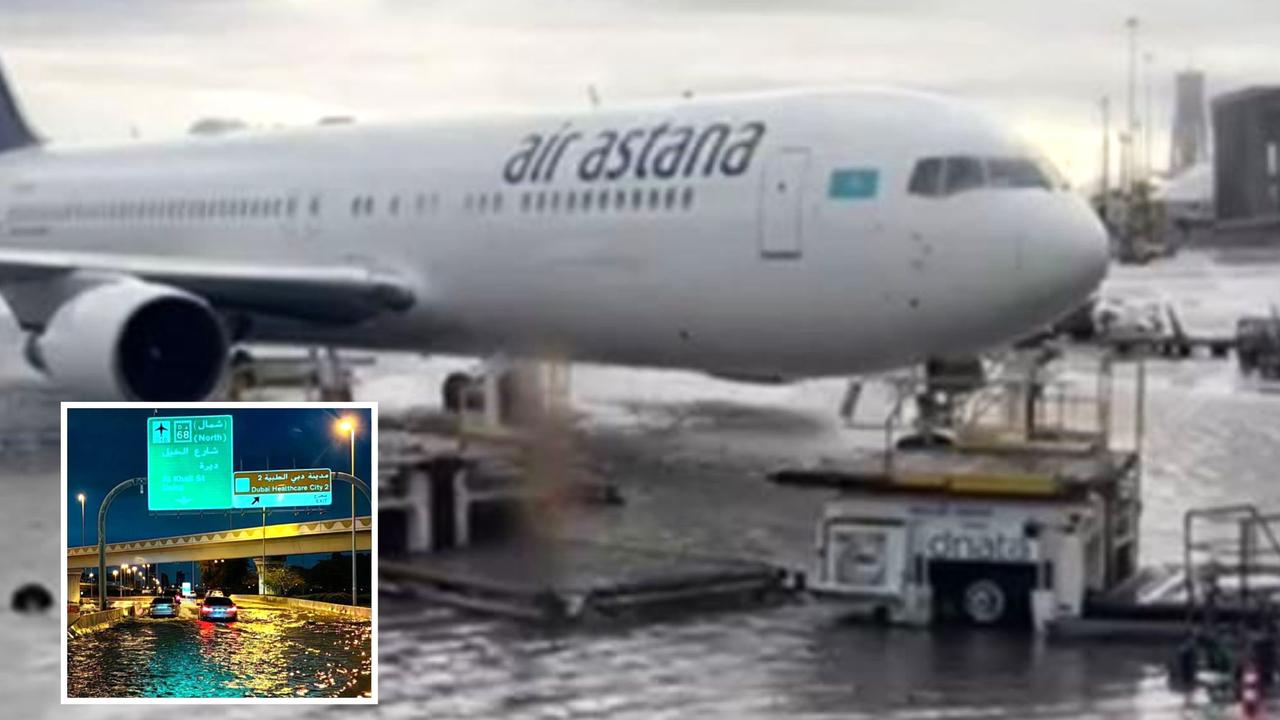
Travellers frantic as airport ‘runs out of food’
The design of a proposed train station in China is supposed to take inspiration from a flower but people on social media can’t see anything but a sanitary pad.
And for that reason, a rendered image of the proposed North Nanjing station has gone global.
Authorities have reportedly claimed the inspiration for the design was the plum blossom, which is a beloved flower.
Nanjing hosted a festival in February and March dedicated to them.

On Chinese social media platforms, the topic has generated millions of views, according to British public service broadcaster BBC.
“This is a giant sanitary pad. It’s embarrassing to say it looks like a plum blossom,” one person was quoted to say on Weibo.
“Why can we all tell it is a sanitary pad immediately, but the architects can’t?” another user wrote.

Foreign social media users have been left just as shocked.
“It’s another ‘were there any women in the room when this was being designed?’ things,” wrote one woman, attracting thousands of likes on Instagram.
More Coverage

Another popular comment agreed: “This is what happens when there are no women in the room.”
“Did they not notice that plum blossoms have five petals?” one comment asked with almost 2000 likes in support.
The design was approved by the government of Jiangsu province and China State Railway Group, according to state-owned media.
Add your comment to this story
To join the conversation, please log in. Don't have an account? Register
Join the conversation, you are commenting as Logout
A man has broken his leg 30 minutes into a seven hour flight after the plane hit turbulence when he was returning from the bathroom.
A woman shares how she was suddenly banned on the Uber app for her name.
Stressed passengers at Dubai’s major airports, including those travelling from Australia, have said conditions are dire.
- train tickets
Elektrostal to Ho Chi Minh City by train
Travel from Elektrostal (Russia) to Ho Chi Minh City (Vietnam) by train (7667km): schedule and information to the train connection. Compare fares and buy your ticket.
The train connection Elektrostal (Russia) - Ho Chi Minh City (Vietnam) runs via China. Please read the following travel information and blog posts.
Your travel route could be like that.
1 Elektrostal (Russia) - Beijing (China) - Hanoi (Vietnam) - Ho Chi Minh City (Vietnam)

The following links could be interesting for you.
train connections : popular connections travelled by other users
The route consist of more than one step. You have to buy several train tickets.
1a Travelling from Elektrostal (Russia) to Beijing (China)
To travel from Russia to China by train, use the direct train connections by the Trans-Siberian Railway. Buy your train ticket via one of the following booking links. There find as well the exact train schedules and ticket prices. You will need additional train tickets in Russia and China to connect to the international train. These are also available via the given booking links. A journey from Moscow to Beijing takes about five days and tickets are available from 500 EUR. The route is served by Russian railways RZD and Chinese railways.
1b Travelling from Beijing (China) to Hanoi (Vietnam)
If you want to travel from China to Vietnam by train, you have daily train connections. There are two main travel routes available. The first travel route is from Beijing, Guilin, Nanning (China) to Hanoi (Vietnam). There are two direct trains per week from Beijing (China) to Hanoi (Vietnam). There are every day connections from Nanning (China) to Hanoi (Vietnam). If you travel on a date were no direct train runs from Beijing to Hanoi, first travel by the daily overnight train from Beijing to Nanning, then by the daily overnight train from Nanning to Hanoi. The second travel route is from Kunming (China) to Hanoi (Vietnam) with change and border crossing at Hekou (China) and Lào Cai (Vietnam). The train in China coming from Kunming ends at the station Hekou North (China). Journey time 5 hours. There you take a bus or taxi to the border (10 minutes). Walk over the border. And again by bus or taxi (10 minutes) to the station of Lào Cai (Vietnam). From there continue to Hanoi by direct train. How to buy tickets: - buy train tickets from China to Vietnam at Chinahighlights. For the city of Hanoi fill in Gia Lam, Hanoi !!! Direct train: Beijing - Gia Lam, Hanoi. Connection with change: Beijing - Nanning and Nanning - Gia Lam, Hanoi. - buy train tickets inside of Vietnam are available via 12goasia. For example: Lào Cai - Hanoi.
Where to buy a ticket from Beijing to Hanoi?
Our recommendation! Buy your train ticket or bus ticket at 12go. Compare ticket prices from different companies on this travel connection.
Buy the train ticket at a railway station. Note: in some countries you have to pay a service fee at the ticket counter. The ticket can be purchased at a station in the country of departure, also sometimes in other countries.
train company: CNR 中国铁路总公司 / VIET Đường Sắt Việt Nam
train connections: popular connections travelled by other users Hanoi - Beijing / Guilin - Hanoi / Nanning - Hanoi / Shanghai - Hanoi / Wuhan - Hanoi / Kunming - Hanoi / Chengdu - Hanoi / Guangzhou - Hanoi / Shijiazhuang - Hanoi / Beijing - Ho Chi Minh City
1c Travelling from Hanoi (Vietnam) to Ho Chi Minh City (Vietnam)
Travel from Hanoi to Ho Chi Minh City by overnight train. The journey time is 32 to 37 hours. Train ticket fares start from 25 EUR. There are up to 6 train connections daily. The trains of Vietnamese railways offer the following service classes: - 3rd class, hard wooden seats - 2nd class, soft seats with air-condition - 2nd class, sleeper with 6 berths per compartment, with air-condition - 1st class, sleeper with 4 berths per compartment, with air-condition On some trains luxury train wagons are attached. For example "Violette Express" and others which offer 4-berth and 2-berth compartments. The train numbers are as follows with departure time in Hanoi, arrival time in Ho Chi Minh City and the total journey time: - SE1 / 22:20 / 05:45 / 31:25 - SE3 / 19:25 / 04:38 / 33:13 - SE5 / 08:50 / 18:55 / 34:05 - SE7 / 06:00 / 16:30 / 34:30 - SE9 / 14:25 / 03:25 / 37:00 - SE11 / 08:00 / 21:05 / 37:05 We recommend to travel one of the most scenic parts of this rail journey between Huế and Đà Nẵng on day light (SE1, SE3). You get to this section of the travel route 13 hours after departure in Hanoi. Sit on the left in direction of travel to have the best view. If you travel as tourist, it makes sense to include some stops for example in Huế, Đà Nẵng and Hội An. Find the exact train schedules and buy your ticket via the given booking links.
Where to buy a ticket from Hanoi to Ho Chi Minh City?
train connections: popular connections travelled by other users Ho Chi Minh City - Hanoi
A Train Journey in North-Vietnam
Need a cheap place to sleep we recommend booking.com, find a cheap flight compare prices on kiwi.com.

Do you have questions about the connection between Elektrostal and Ho Chi Minh City? Does something not work as it should? Just ask in our forum and get competent answers from our rail travel experts.
Train Routes
- Bosnia-Herzegovina
- Czech Republic
- Netherlands
- Switzerland
- United Kingdom
about railcc : We are real travellers and offer honest and well-grounded tips and tricks for your train journey.
Train tickets
- search train route
- night train
- train company
Rail passes
- Britrail Pass
- German Rail Pass
- Swiss Travel Pass
- Renfe Spain Pass
- Balkan Flexi Pass
Travel guide
- travel tours
- train types
- train travel in ...
- ferry connections
- bus tickets
- Interrail Global Pass
- Interrail One Country Pass
- first time Interrail
- how to Interrail
- Interrail train reservations
- Interrail night trains
- Interrail ferries
- Interrail buses
- Interrail country overview
- Interrail offers and discounts
- Eurail Global Pass
- Eurail Select Pass
- Eurail ONE Country Pass
- how to Eurail
- first time Eurail
- Eurail train reservations
- Eurail night trains
- Eurail ferries
- Eurail buses
- Eurail in ...
- Eurail offers and discounts
- about railcc
We speak more than 30 languages
rail.cc is partner and friend of

- Preplanned tours
- Daytrips out of Moscow
- Themed tours
- Customized tours
- St. Petersburg
Moscow Metro
The Moscow Metro Tour is included in most guided tours’ itineraries. Opened in 1935, under Stalin’s regime, the metro was not only meant to solve transport problems, but also was hailed as “a people’s palace”. Every station you will see during your Moscow metro tour looks like a palace room. There are bright paintings, mosaics, stained glass, bronze statues… Our Moscow metro tour includes the most impressive stations best architects and designers worked at - Ploshchad Revolutsii, Mayakovskaya, Komsomolskaya, Kievskaya, Novoslobodskaya and some others.
What is the kremlin in russia?
The guide will not only help you navigate the metro, but will also provide you with fascinating background tales for the images you see and a history of each station.
And there some stories to be told during the Moscow metro tour! The deepest station - Park Pobedy - is 84 metres under the ground with the world longest escalator of 140 meters. Parts of the so-called Metro-2, a secret strategic system of underground tunnels, was used for its construction.
During the Second World War the metro itself became a strategic asset: it was turned into the city's biggest bomb-shelter and one of the stations even became a library. 217 children were born here in 1941-1942! The metro is the most effective means of transport in the capital.
There are almost 200 stations 196 at the moment and trains run every 90 seconds! The guide of your Moscow metro tour can explain to you how to buy tickets and find your way if you plan to get around by yourself.
- China railway launches charter tour train service to Russia's Vladivostok
SHENYANG, April 17 (Xinhua) -- A charter tour train taking 300 Chinese tourists departed on Tuesday from a north China city for Russia's Vladivostok on a seven-day tour.
This was the first of such train service this year operated by China Railway Shenyang Bureau Group Co., Ltd., headquartered in Shenyang, capital of northeast China's Liaoning Province.
The charter tour train departed from Shanhaiguan Railway Station in Qinhuangdao City, Hebei Province. The trip's itinerary winds through Yanji and Hunchun cities in northeast China's Jilin Province before going across the border for a visa-free travel in Vladivostok, Russia.
The railway company has planned to open three charter tour train service to Vietnam, Laos and Russia, respectively, to boost visa-free travel. Enditem
Go to Forum >> 0 Comment(s)
Add your comments....
- User Name Required
- Your Comment
Vacations, planes, and high-speed trains are off limits if you're in too much debt in China
- China is punishing citizens who can't repay their debts by cutting off access to social services.
- So-called deadbeat debtors are blacklisted, facing travel restrictions and government jobs.
- The blacklist is similar to the country's "social credit" system that punishes undesirable behavior.
China wants its citizens to repay their debts — and it is willing to punish those who don't.
That means that delinquent debtors are restricted from accessing some services in the country, like high-speed trains and air travel. Some, according to a Wall Street Journal report , are forbidden from government jobs and denied pricier insurance policies, vacations, and even nice hotels.
Outstanding debtors are placed on a government delinquency blacklist . Informally, these people are referred to as "laolai" — roughly translated, "deadbeat debtors." And the number of names on the list is about 8.3 million, according to the Journal — a jump of nearly 50% since 2019 .
It's not just formal restrictions they face; some phone companies in China have gone as far as assigning special ringtones to debtors to warn other people that they are talking to someone on the brink of insolvency.
However, procedures for personal insolvency in China are few and far between. Unlike most other countries, China doesn't allow most people to write off their debts with bankruptcy, per the Journal.
Instead, the Chinese government can take steps like seizing a debtor's income as restitution, leaving them with a small allowance so they can cover living expenses.
That isn't always enough, though, as one man found when he petitioned to raise his monthly income allowance to help pay for a newborn child. Rather than approving the increase to 12,000 yuan, or approximately $1,600, the Journal reported that the court cut his allowance by nearly 40%.
In China, a country that traditionally values saving, some consider borrowing money to be taboo . That's backed by a 2021 study, which noted that in Chinese society, "many still view bankruptcy as a vehicle for feckless shirkers to escape their debts."
That's left many debtors feeling trapped by the system, which can make it increasingly difficult for them to pay off seemingly insurmountable liabilities.
China's debtor blacklist is technically separate from its " social credit system ," but both have similar functions — namely, tracking individual behavior and rewarding or punishing people for it.
The system, which is not yet fully implemented, has penalized citizens for everything from social media posts to jaywalking . The worst offenders may face trouble getting loans and travel restrictions — similar to the experience of blacklisted debtors.
The Chinese economy has slumped after exiting the pandemic . Researchers have warned of a "debt-deflation spiral" that could make the situation for Chinese households even worse.
Watch: Thousands of demonstrators erupt in rare protests against COVID-19 restrictions across China
- Main content

COMMENTS
China Train Tours. China's convenient railway network brings on a whole new experience. The improvement in both speed and comfort makes train travel in China a very viable option to flying. The following China train tours are carefully designed catering to different needs and interests, covering popular destinations conveniently reached by train.
Shanghai's Maglev train is the fastest of all China's high speed trains, traveling at a phenomenal 431 kilometers per hour. It travels 30.5 kilometer distance from Shanghai Pudong International Airport to Longyang Road Station in 7 minutes and 20 seconds. Blink and you might just miss the whole trip!
Longer China Trips with High Speed Train Experience 11 Days Classic China Kungfu Tour by Speed Train. Beijing / Luoyang / Xian / Shanghai. A wonderful trip for Kungfu fans who visit China for the first time, since this private tour not only includes the classic trip to Beijing, Xian and Shanghai, but also a visit the Shaolin Temple, where you can see the authentic Chinese Kungfu.
China train system boasts over 159,000 km (98,800 mi) long railway, including the world's largest high speed train network connecting more than 500 cities across the country, and the highest speed can reach 350 km/h (217 mph). To plan a budget, convenient and safe travel, China train is your best choice.
Find China High Speed Train Tours by Cities. China's vast high speed railway system has covered more than 500 cities and towns in China, including those China's iconic travel destinations - Beijing, Xian, Shanghai, Hong Kong, Chengdu, Guilin, Huangshan (Yellow Mountain), etc.
Beijing Xian High Speed Train Tours: From China's capital to China's ancient capital, it takes only 4.5-6 hours to cover 1,209km. 2. Shanghai Beijing High Speed Train Tours: From China's biggest city to China's second biggest city, it takes only 4.5-6 hours to cover 1,318km. 3. Xian Chengdu High Speed Train Tours: From Terracotta Warriors to ...
24/7 One-to-One Service. We provide reliable and professional service throughout your journey planning and train travel in China. International passengers may have known that the policy for taking a train in China is becoming less strict, and more and more trains are being resumed day by day. It is the best time to take a train trip in China now.
Beijing to Lhasa (3757km) One of China's most epic train journeys is this spectacular two-day trip along the highest railway line in the world. Running from the nation's capital all the way to Tibet, it covers some 3757km across eight provinces. Departing Beijing in the evening, you'll awake to the flat rural landscapes of the North China ...
Day 1~4 Arrival & Beijing Tour & High Speed Train to Xian. Day 5~6 Xian Tour & Flight to Chongqing. Day 7~9 Yangtze River Cruise & High Speed Train to Wuhan. Day 10 Wuhan & High Speed Train to Guilin. Day 11~12 Guilin & Flight to Shanghai. Day 13~14 Shanghai Tour & Departure.
Why to travel by High Speed Trains. Super Fast - China high speed trains run at speeds about 250~350km/h. The newest Fuxing trains' speed can reach to 400km/h. You can get to Beijing from Shanghai (over 1,200km) within 5 hours. More Punctual & Reliable - High speed trains are on time.
What's On. China Railway will operate 40 more high speed trains between Hong Kong and Guangdong, and 22 high speed trains between Hong Kong and other cities outside Guangdong, such as Beijing, Shanghai, Xiamen, Chongqing, Guilin, Kunming, etc., from April 1, 2023. - 23/03/2023. China Discovery collected 8 Most Beautiful High Speed Railways in ...
Classic China tours by high speed train allow you to explore Beijing, Shanghai, Xian, Chengdu, Guilin, Hong Kong, and all the highlights of China, in a more stylish and economic way. The speed train is safe, time-saving, cheap, comfortable and punctual, and has become the optimum choice to travel in China and experience the charming oriental ...
Provides official China train schedule, fares and ticket availability search plus train station guide and rail travel information for overseas visitors. Check your trip by Route Station Train No. Input departure station:
This page will help you understand & plan train travel in China, & arrange your train tickets. UPDATE 2024: Travel to China is open again post-pandemic. China-Vietnam and China-Russia trains are still suspended, a limited China-Mongolia and a new China-Laos train service are operating. How to check train times & fares
Below are our best-selling train tours, covering China's popular tourist destinations like Beijing, Xian, Shanghai, Guilin, Chengdu, Mt. Huangshan, and culture-rich destinations like Pingyao, Silk Road, Lhasa, etc.These are all sample tours for your inspiration, and our travel consultants are always happy to help you customize your own China train tours according to your specific likes ...
China train schedule & live ticket availability, book tickets online within 3 mins. 1700 high ratings on TripAdvisor & 50000 train tickets sold last year. Train Travel Tips. Booking Policy. How to Buy Train Tickets. How to Collect Train Tickets.
With speeds of up to 300 km/h (186 mph), train travel in China is a fast, convenient, cheap and comfortable option. Book your China bullet train ticket now! High-speed D train tickets and G train tickets can be booked a minimum of 35 minutes before departure and a maximum of 60 days before departure.
Jen Avery. Jen is a five-foot-short fireball with an itch for adventure. Besides travel, her shameless vices include wine-fuelled nights with good company, road trips to remote places, and squealing at adorable elderly dogs. (Also: COFFEE!). Train travel in China is cozy and cheap, but at times, confusing.
China high speed train runs from 200km/hr to 350km/hr at reasonable price. It takes only 4.5 hours by the fastest train from Beijing to Shanghai for the 1318 km journey. ... Chinese trains are a safe, comfortable way to travel around China. Each train has its own police. People are traveling under real-name policy. Cheap Price and Hassle-free ...
Beijing-Shanghai High-Speed Railway (京沪高速铁路) Connecting the capital city of Beijing with Shanghai, China's largest city, this high-speed rail line is one of the most frequented routes in the country. The journey covers a distance of about 1,433 kilometers and can be completed in as little as 4.5 hours, reaching speeds of up to 350 km/h.
FOSHAN, China—Qin Huangsheng once imagined a better life in the city when she left her home village to become a factory worker at age 16. Now, in her early 40s, she has $40,000 in personal debt ...
Nanjing hosted a festival in February and March dedicated to them. The new North Nanjing station has been mocked globally for looking like a sanitary pad. Picture: Weibo. On Chinese social media ...
It is open from 6 am to 1 am. Trains come very frequently: during the rush hour you won't wait for more than 90 seconds! Distances between stations are quite long - 1,5 to 2 or even 3 kilometers. Metro runs inside the city borders only. To get to the airport you will need to take an onground train - Aeroexpress. RATES AND TICKETS. Paper ticket
Drive • 1h 3m. Drive from Elektrostal to Moscow 58.6 km. RUB 450 - RUB 700. Quickest way to get there Cheapest option Distance between.
In this photo released by Xinhua News Agency, an electric multiple unit (EMU) train of the China-Laos Railway arrives at Yuxi Railway Station in Yuxi in southwestern China's Yunnan Province ...
The train connection Elektrostal (Russia) - Ho Chi Minh City (Vietnam) runs via China. Please read the following travel information and blog posts. Your travel route could be like that. 1 Elektrostal (Russia) - Beijing (China) - Hanoi (Vietnam) - Ho Chi Minh City (Vietnam) 7667 km
The Moscow Metro Tour is included in most guided tours' itineraries. Opened in 1935, under Stalin's regime, the metro was not only meant to solve transport problems, but also was hailed as "a people's palace". ... There are almost 200 stations 196 at the moment and trains run every 90 seconds! The guide of your Moscow metro tour can ...
SHENYANG, April 17 (Xinhua) -- A charter tour train taking 300 Chinese tourists departed on Tuesday from a north China city for Russia's Vladivostok on a seven-day tour. This was the first of such ...
Vacations, planes, and high-speed trains are off limits if you're in too much debt in China Written by Camilo Fonseca 2024-04-17T19:03:02Z